Gear-obsessed editors choose every product we review. We may earn commission if you buy from a link. How we test gear.


What Bike Is Each Team Racing in the Tour de France?
Details of the frames, wheels, components, and tires used by all 22 teams in the 2024 Tour de France.
The Tour de France is the world’s highest-profile cycling event. With millions of eyes on the race, the Tour is a rolling showcase for bicycle brands and equipment manufacturers. And since 2024 is also an Olympic year, several teams are racing on brand-new (or even unreleased) bike platforms to get a leg up on competitors or get in some final testing.

Nineteen bike brands are represented among the twenty-two teams participating in this year’s race. Wilier, Specialized, and Canyon sponsor two teams each. Enve and Van Rysel are two fresh faces in the 2024 Tour de France peloton. And Lapierre departs the Tour peloton after a 22-year run with the Groupama-FDJ team’s switch to Wilier.
On the drivetrain side, Shimano dominates the field, with 19 of the 22 Tour teams shifting with Dura-Ace Di2 derailleurs. The three remaining teams run SRAM's new Red AXS components. Campagnolo is absent from the Tour for another year.

For tires, eight teams are on Continental (specifically the GP5000 S TR) and seven are on Vittoria (Corsa Pro) —all running tubeless systems. The two Specialized sponsored teams are using Specialized tires and latex inner tubes. Cofidis is the only team still running tubular tires (Michelin). The remaining four teams are on Cadex, Enve, Schwalbe, and Pirelli rubber.
Below is a complete list of the bikes—along with the component groups, wheels, and tires—used by each team in this year’s Tour de France.
Click Here for Full 2024 Tour Coverage
Alpecin-Deceuninck (ADC)
Arkéa-b&b hotels (ark), astana-qazaqstan (ast), bahrain victorious (tbv), cofidis (cof), decathlon-ag2r la mondiale team (dat), ef education-easypost (efe), groupama-fdj (gfc), ineos grenadiers (igd), intermarché-wanty (iwa), israel-premier tech (ipt), lidl-trek (ltk), lotto-dstny (ltd), movistar team (mov), red bull-bora-hansgrohe (rbh), soudal-quickstep (soq), team dsm-firmenich postnl (dfp), team jayco-alula (jay), team visma-lease a bike (tvl), totalenergies (ten), uae team emirates (uad), uno-x mobility (uxm).

Bike: Canyon Aeroad CFR
Alpecin-Deceuninck uses Canyon’s Aeroad bike for the vast majority of race days. The brand released an updated version of its weight-focused Canyon Ultimate in 2022, which the team also has access to but rarely uses. We recently saw the team race a subtly updated version of the Aeroad, so expect to see an announcement from Canyon very soon. The closest consumer version of this bike from Canyon currently retails for $9,200.
Groupset: Shimano Dura-Ace R9200 Wheels: Shimano Dura-Ace (various depths) Tires: Vittoria Corsa Pro (tubeless)

Bike: Bianchi Specialissima RC or Oltre RC
Arkéa-B&B Hotels is sponsored by Bianchi. The team chooses between the Specialissima RC (an all-around bike) or the Oltre RC (the aero-focused bike shown above). The choice of bike is seemingly down to rider preference rather than the specific stage profile. Bianchi offers a team replica Oltre RC for sale but does not list a price. Expect to pay more than the standard Dura-Ace variant, which sells for $14,500.
Groupset: Shimano Dura-Ace R9200 Wheels: Vision Metron SL (various depths) Tires: Vittoria Corsa Pro (tubeless)

Bike: Wilier Triestine Filante SLR
Astana-Qazaqstan is one of two teams sponsored by Wilier (the other is Groupma-FDJ). While Wilier recently launched a brand-new climbing bike (the Verticale SLR), I do not expect AST team riders will choose it over the brand’s all-around race bike (the Filante SLR), even for the high mountain stages. The Verticale SLR has virtually no aerodynamic features, and at the speeds that Tour riders climb, aerodynamics is always in play in the race. A consumer model of the Filante SLR with Dura-Ace sells for roughly $14,300.

Bikes: Merida Reacto (shown above) and Scultura
Merida bikes are rarely seen in North America but are very popular in other regions of the world. The brand offers its riders the choice of the aero-focused Reacto and the weight-focused Scultura. Both models have been around for a few seasons. I expect the team will primarily use the Reacto, but I wouldn't be surprised if Pello Bilbao (the team's GC hopeful) goes for the Scultura in some high mountain stages. Expect to pay roughly $12,000 for a team replica model (if you live in a part of the world where you can buy a Merida or you can import one).
Groupset: Shimano Dura-Ace R9200 Wheels: Vision Metron SL (various depths) Tires: Continental GP5000 S TR (tubeless)

Bike: Look 795 Blade RS
Look does not produce separate aero and climbing bikes. Instead, the French brand has one model optimized for both—a strategy many other brands are also turning to in 2024. The most interesting thing about the Cofidis team bikes is that they are the last team consistently using tubular tires. A Look 795 Blade RS with Dura-Ace and Corima wheels retails for $11,000.
Groupset: Shimano Dura-Ace R9200 Wheels: Corima (various depths) Tires: Michelin (Tubulars)

Bike: Van Rysel RCR Pro
Another French team riding a French bike. The revitalized AG2R team has won races left and right since Decathlon joined as a title sponsor. The French sporting goods retailer supplies AG2R riders with its new Van Rysel RCR. The RCR is another all-around bike that balances weight with aerodynamics. Decathlon sells a team replica version of the RCR Pro for $11,000.
Groupset: Shimano Dura-Ace R9200 Wheels: Swiss Side Hadron Ultimate (various depths) Tires: Continental GP5000 S TR (tubeless)

Bikes: Cannondale SuperSix Evo
Cannondale’s fourth-generation SuperSix Evo is both lightweight and quite aerodynamic. While the American brand offers an all-out aero bike (the SystemSix) most riders opt for the all-around SuperSix Evo instead. Ben Healy (the Irish breakaway specialist and known aero-weeny) is the rider more likely to be seen on the older SystemSix for that bit of extra aero. Cannondale sells a team replica SystemSix Evo Lab 71 for $14,000.
Groupset: Shimano Dura-Ace R9200 (with FSA cranks) Wheels: Vision Metron SL (various depths) Tires: Vittoria Corsa Pro (tubeless)

Bikes: Wilier Triestine Filante SLR
Like Astana-Qazaqstan, Groupama-FDJ also rides Wilier bikes. Both teams use Wilier’s all-around race bike (the Filante SLR), which balances weight and aerodynamics. The main difference between the bikes of these two teams comes down to wheels. Groupama-FDJ has long been a Shimano-sponsored team, so they use Shimano wheels instead of the Vision wheels used by Astana. The consumer model of the Filante SLR with Dura-Ace sells for roughly $14,300.
Groupset: Shimano Dura-Ace Wheels: Shimano Dura-Ace (various depths) Tires: Continental GP5000 S TR (tubeless)

Bikes: Pinarello Dogma F
Pinarello has made the single aero and lightweight bike for longer than most competitors. The Italian brand recently updated the Dogma to be slightly more aero and lighter based largely on its partnership with the team. Ineos certainly hopes the updated bike will help them return to the top step of the Tour’s podium. A close replica of the team’s bike , which includes a Princeton CarbonWorks wheelset, can be purchased for $14,500.
Groupset: Shimano Dura-Ace R9200 Wheels: Shimano Dura-Ace or Princeton CarbonWorks Tires: Continental GP5000 S TR (tubeless)

Bikes: Cube Litening C:68X Pro
Cube has a relatively small presence in North America, but the worldwide brand has an enormous bike lineup featuring everything from commuter e-bikes to kids’ bikes. Obviously, the Litening C:68X is neither of those. Instead, it is the aero-focused Cube race bike that Intermarché-Wanty riders choose for most race days. The Dura-Ace model of the Listening is one of the least expensive consumer-available versions of a Tour de France race bike in this year’s event, selling for roughly $8,200.
Groupset: Shimano Dura-Ace R9200 Wheels: Newman Advanced SL (various depths) Tires: Continental GP5000 S TR (tubeless)

Bikes: Factor Ostro VAM
The primary race bike of IPT, Factor released the updated Ostro VAM at the beginning of the 2024 racing season. While Factor also makes a dedicated lightweight climbing bike (the O2 VAM), the Ostro VAM is light enough that riders choose it for most days. A special edition Tour de France replica team bike with Dura-Ace is available from Factor for $11,200.
Groupset: Shimano Dura-Ace R9200 Wheels: Black Inc Tires: Continental GP5000 S TR (tubeless)

Bikes: Trek Mado ne SLR
Trek launched a brand new eighth-generation Madone ahead of the Tour. Trek claims the new frame is as light as the Émonda (Trek’s lightweight climbing bike), which is being discontinued from the brand’s lineup. Importantly, the new Madone is also as aerodynamic as the previous generation Madone, which was a dedicated aero bike. Trek sells a team replica Madone 8 for $13,500 .
Groupset: SRAM Red AXS Wheels: Bontrager Aeolus Tires: Pirelli TLR (tubeless)

Bikes: Orbea Orca and Orca Aero
Orbea continues to provide dedicated aero bikes and climbing-focused bikes to Lotto-Dstny. Pictured above is the Orca Aero, but Lotto-Dstny riders have often used the lighter-weight Orca during the 2024 racing season. A Lotto-Dstny team replica with Dura-Ace sells for $12,000.
Groupset: Shimano Dura-Ace R9200 (with FSA cranks) Wheels: Oquo (officially), Zipp (unofficially) Tires: Vittoria Corsa Pro (tubeless)

Bikes: Canyon Aeroad CFR Movistar is the second Canyon-sponsored team in the Tour. Like Alpecin-Deceuninck, Movistar also uses the Aeroad as its primary race bike. However, team leader and GC hopeful Enric Mas often chooses Canyon’s weight-focused Ultimate model. A SRAM Red version of the Aeroad from Canyon sells for $9,000—but this bike has the previous generation of Red. This is likely because a new Aeroad will be released soon with the latest Red parts. Expect that bike to be slightly more expensive. Groupset: SRAM Red AXS Wheels: Zipp Tires: Continental GP5000 S TR (tubeless)

Bike: Specialized Tarmac SL8
Specialized only offers the Tarmac SL8 to its sponsored teams, having moved away from the “aero is everything” slogan. The Tarmac SL8 is a do-it-all, lightweight-but-still-very-aerodynamic race bike. This also makes it easier for riders and teams —they no longer need to consider or transport two different bikes to each event. A team replica Tarmac SL8 is available for $16,500. Which is technically the most expensive complete bike in this year's race that someone could actually buy as is.
Groupset: SRAM Red AXS Wheels: Roval Tires: Specialized Turbo Cotton (with latex innertubes)

Bikes: Specialized Tarmac SL8
Soudal-QuickStep uses almost the same bikes as Red Bull-Bora-Hansgrohe, except that the Soudal bikes use Shimano Dura-Ace drivetrains instead of SRAM Red. The $14,000 consumer version of the Tarmac SL8 with Dura-Ace is also slightly cheaper than the Red-equipped Red Bull team replica bike. However, the Dura-Ace-equipped Tarmac does not include the slightly lighter and more aero Team wheelset.
Groupset: Shimano Dura-Ace R9200 Wheels: Roval Tires: Specialized Turbo Cotton (with latex innertubes)

Bikes: Scott Foil RC
Scott is still a brand that makes both an aero and a lightweight bike (Scott Addict), but you would never know it by looking at the bikes raced by DSM-Firmenich PostNL races. The team rides the aero-optimized Scott Foil RC, even in the high mountains. It’s the case of an aero bike that became the team’s default race bike. A version of the team bike is available from Scott for $11,000.

Bikes: Giant Propel Advanced SL and TCR Advanced SL
Jayco-AlUla riders can choose between the aero-optimized Propel or the all-new, tenth-generation TCR that is more weight-focused. Built with Dura-Ace, both bikes are available to consumers for $12,750.
Groupset: Shimano Dura-Ace R9200 Wheels: Cadex Tires: Cadex GC (tubeless)

Bikes: Cervélo S5 and R5
Team Visma-Lease a Bike is known for optimizing everything. So it’s not surprising that they switch around bikes and wheels more often than most other teams. While Visma-Lease a Bike riders always ride the aero-optimized S5 on flat and rolling stages, they often switch to the weight-focused R5 for mountain stages—a standard practice for teams with two bike options. Visma-Lease a Bike also uses the in-between option of the aerodynamic S5 with very light wheels (shown above), presumably when the team’s math tells them it’s the right choice for the particular stage profile. The S5 with new Red retails for $13,000.
Groupset: SRAM Red AXS Wheels: Reserve Tires: Vittoria Corsa Pro (tubeless)

Bikes: Enve Melee
The Melee is Enve’s first production bike. The bike is an all-arounder that focuses on low weight, ride quality, and aerodynamics. While Enve has already won many races at the highest level as the wheel sponsor for UAE Team Emirates, it is a debutant at the Tour as a frame supplier with TotalEnergies. Enve does not offer complete bikes, but a replica team Melee frameset is available for $6,000. Expect a complete bike, built to team specifications, to sell for around $14,000.
Groupset: Shimano Dura-Ace R9200 Wheels: Enve Tires: Enve (tubeless)

Bikes: Colnago V4Rs
Launched in 2022, the Colnago V4Rs won many races under Tadej Pogačar. Not much has changed about the team bikes of UAE Team Emirates in the last few seasons. These bikes retain the dubious title of the most expensive team bikes in the Tour. A consumer version , built with Dura-Ace and Enve wheels, will set you back $15,500. But if you add the boutique Carbon-Ti parts (like chainrings and disc rotors) and a Darimo seatpost that the team is using on their bikes, you will spend closer to $17,000.
Groupset: Shimano Dura-Ace R9200 Wheels: Enve SES Tires: Continental GP5000 S TR (tubeless)

The cheapest bike in the 2024 Tour is the Dare VSRu, ridden by Team UNO-X. Dare bikes are not available in the U.S. However, when the bike’s price is converted to dollars, it is a very reasonable $7,450. And that’s with a full Dura-Ace groupset and DT Swiss ARC 1400 carbon wheels. It's a true shame that the brand is not available in North America.
Groupset: Shimano Dura-Ace R9200 Wheels: DT Swiss Tires: Schwalbe Pro One (tubeless)
Test Editor Dan Chabanov got his start in cycling as a New York City bike messenger but quickly found his way into road and cyclocross racing, competing in professional cyclocross races from 2009 to 2019 and winning a Master’s National Championship title in 2018. Prior to joining Bicycling in 2021, Dan worked as part of the race organization for the Red Hook Crit, as a coach with EnduranceWERX, as well as a freelance writer and photographer.

What Were the Best Details on MADE Show Bikes?

The 13 Best Road Bikes of 2024

What Are the Best Bikes at MADE Show?

A 3D-Printed Titanium Road Bike?

Firefly’s Custom Gravel Bike is Cycling Artwork

This Bike Made Me Laugh, Cry, and Puke—Buy It!

Best Hybrid Bikes You Can Buy Right Now

Giant TCR Advanced Improves on Its Legacy

Lightweight Gear for Heavyweight Riders

Tested: Trek’s Eighth-Generation Madone

The Best Commuter Bikes for Getting Around Town

Tested: Trek's Carback Bicycle Radar Light
Powered by Outside
Tour de France
Basically everything about tour de france race bikes has changed in the last 20 years, at a glance, race bikes still look somewhat similar to 20 years ago, but look closer and essentially every feature has changed..

- Share on Facebook
- Share on Reddit
Don't miss a moment of the 2024 Tour de France! Get recaps, insights, and exclusive takes with Velo's daily newsletter. >","name":"in-content-cta","type":"link"}}'>Sign up today! .
The Tour de France is as much a showcase for road bikes as it is about racing and tactical prowess. Being the biggest event in pro cycling, team equipment sponsors are keen to get their riders on the best of the best, often using the race as a launching pad for new gear.
Sometimes there are big innovations. More often, though, are incremental improvements year over year. But zoom out a couple of decades and yesterday’s bikes are almost unrecognizable from today’s machines. Two things have stayed the same in 20 years: bikes have a double-triangle frame design and are constrained by a UCI (the sport’s governing body)-mandated minimum weight of 6.8 kilograms (15 pounds). Otherwise, just about everything has changed in one way or another.
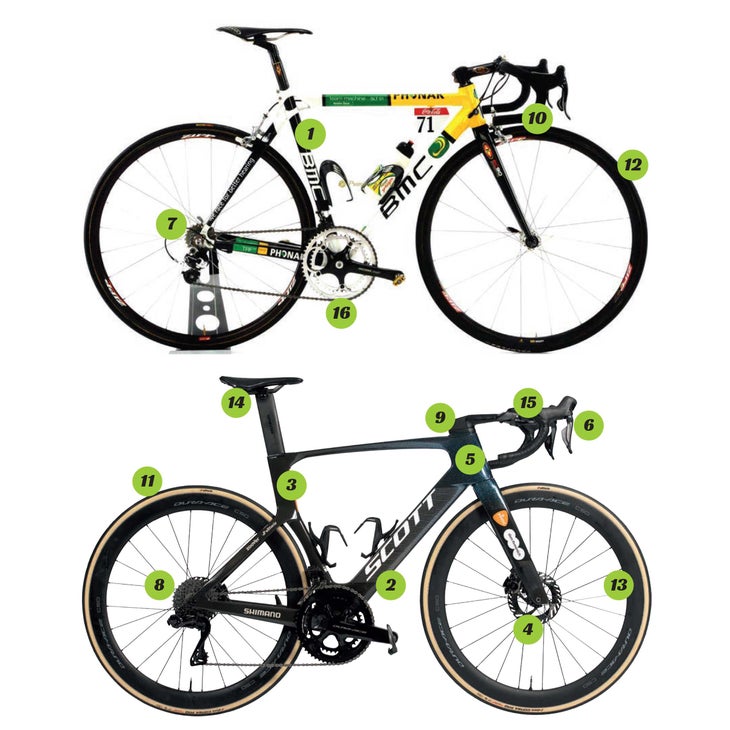
1. Carbon is the only way to go
Twenty years ago, carbon fiber had already begun to usurp aluminum, titanium and steel as the frame material of choice, but it was still early days. Many frames bonded carbon tubes to metal lugs. Nowadays, it’s all carbon, allowing for lighter, stiffer frames with tube shapes unattainable using metals.
2. Better carbon fiber
Not all carbon is made the same. Modern frames utilize higher quality composite materials that, coupled with better construction techniques, allow frames to achieve stiffness targets with less material.
3. Aerodynamic tube shapes
Everyone in cycling 20 years ago knew that aerodynamics mattered. But it hasn’t been until more recently that aero has become everything. Carbon fiber has allowed engineers to go wild creating precise tube shapes that cheat the wind — within UCI regulations of course. The more aerodynamic the rider and the bike, the less energy riders have to expend to go the same speed. That energy lost only compounds in importance for a three-week grand tour.
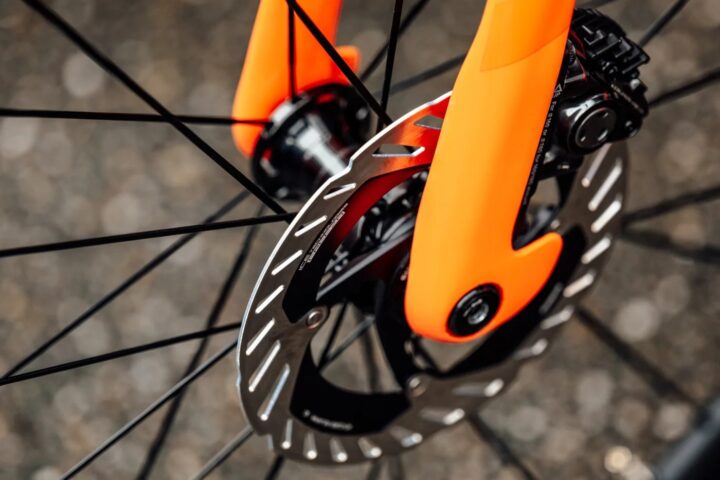
4. Disc brakes
Hydraulic disc brakes were already in use in mountain biking 20 years ago, but it took until about five years ago for them to be widely adopted in road cycling. The advantages are twofold: more consistent braking in all weather conditions and the ability to run wider tires by removing the tight clearance of brake calipers surrounding tires. Disc brakes come with a weight penalty, but that’s made up for by everything else becoming lighter in recent years.
5. Internal cable routing
Aero is everything, as they say. Hiding cables inside the frame removes one more thing interfering with airflow across a bike frame. Plus, hey, it looks cool
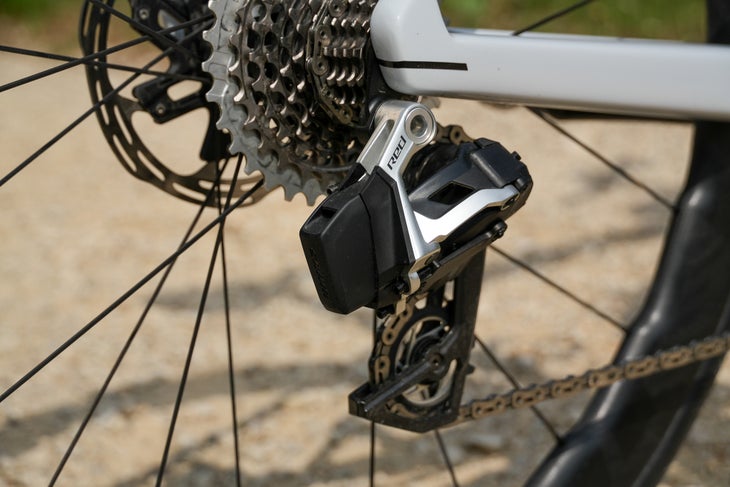
6. Electronic shifting
But what’s cooler than internal cables? Try no cables. Electronic shifting has been the norm in cycling for over a decade now, first with Shimano’s wired Di2 system and Campagnolo’s EPS, then SRAM took everything wireless with eTap AXS. The systems mean precision shifting every time — just remember to charge the batteries.
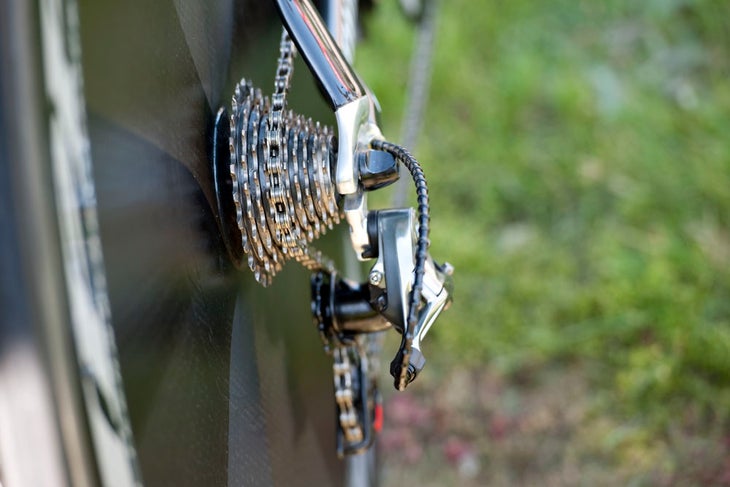
7. More gears
A cutting-edge bike in 2004 had a 10-speed cassette on the rear hub coupled with two chainrings on the crank for 20 gears total. Today, bikes have 12-speed cassettes for a total of 24 gears. Though sometimes, especially in time trials, teams will opt for just one chainring up front for a lighter, more aero setup.
8. Wider gear ranges
Cassettes of the past resembled a corn cob because they only increased gear size by one or two teeth with each gear. The easiest gear in the cassette would top out at 23 teeth. Machismo kept riders pushing large gears while climbing. Today, however, riders prefer to spin easier gears at higher cadences—a 30-tooth low gear has become normal, with 34 teeth (or more) being not unheard of—which often results in faster times up climbs.

9. Integrated cockpit
Modern-day road bikes don’t just have brake hoses hidden in the frame. Nowadays, they’re often hidden in the stems and handlebar as well. Brake hoses are routed through beautifully constructed one-piece handlebar-stem combinations made of carbon. Doing so creates a more aero front end of the bike, and, once again, it looks cool!
10. Handlebar profile
The shape of drop-bar handlebars has changed as well, with the traditional rounded profile of the handlebar drops giving way to a compact shape that provides easier access to the brakes and shifters. The tops are often an airfoil shape, again in the name of aerodynamics.
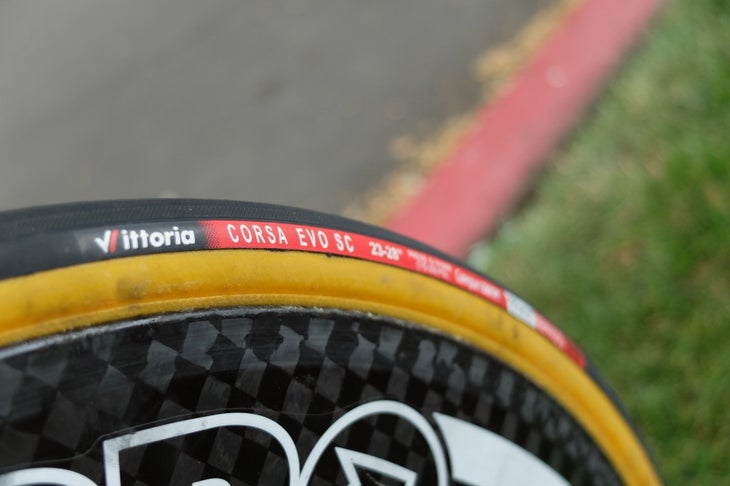
11. Wide tires at low pressures
We used to believe that skinny tires — 23mm or less in width — pumped up to 120 or even 140 psi were the fastest option out there. Now we know that that’s far from the case, with 28mm or even 30mm tires run at far lower tire pressures — sometimes in the 40 or 50 psi range — becoming the norm. They have less rolling resistance and are more comfortable, a win-win. You can thank disc brakes for this win-win, as rim brake bikes often struggled to fit tires quite this big.
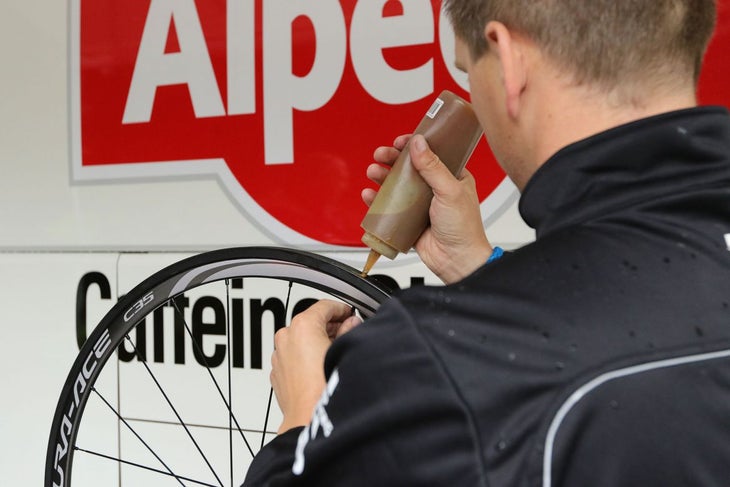
12. Tubeless tires — no more glue
Tubular tires glued on to rims were the prevailing norm for over a century in bike racing. Now teams are moving to tubeless tires because they offer lower rolling resistance. Though the old-fashioned ones have the added safety benefit of staying glued on when they go flat, that’s not always the case for tubeless tires.
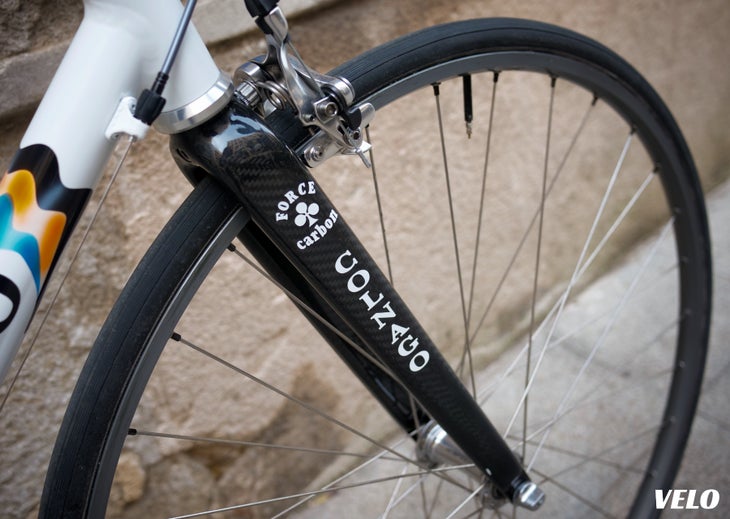
13. Carbon aero wheels with wider rims
Two decades ago, carbon aero wheels in the pro peloton were still the exception. Today, you won’t find a single bike without them. Wider rims have also come around to better accommodate today’s wider tires and make for a more aero transition from tire to rim.
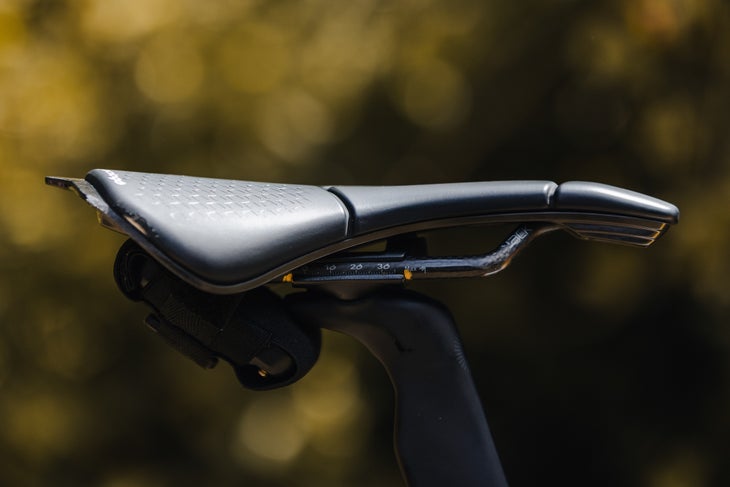
14. Saddles: shorter and wider
Saddles have gotten shorter and wider in recent years, spurred on by research showing that to be more comfortable and ultimately faster for many riders. Oh, and of course the rails are made of carbon now.
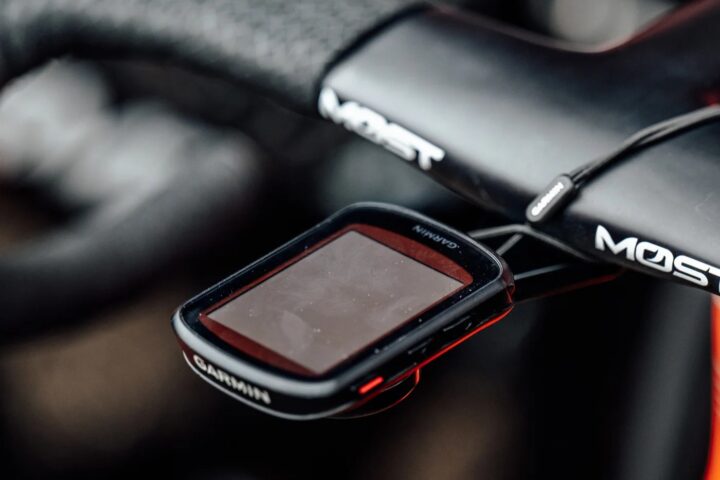
15. Bike computers
Bike computers used to simply count the revolutions of a magnet on the front wheel against a sensor on the fork to display speed and distance. Fancier ones could tap into power meters and heart rate monitors. Today’s computers are essentially smartphones without a call function, displaying a real-time map with GPS data, climb profiles, speed, distance, power, heart rate and a million more metrics that most of us wouldn’t understand.
16. Same weight, more features
Bikes are still mandated by the UCI, cycling’s governing body, to be a minimum of 6.8 kilograms (15 pounds). Bikes could be built much lighter than that, but the limit allows bike manufacturers to incorporate deeper, aero tube shapes and rim profiles, disc brakes and extras like bike computers and power meters while still reaching about the same weight as 20 years ago.
Popular on Velo
What’s it like to be an American cyclist living in France? Watch to get professional road cyclist Joe Dombrowski’s view.
Related content from the Outside Network
One way south, mountain bikers react to their first taste of non-alcoholic craft beer, video review: bmc urs 01 two gravel bike, kiel reijnen vuelta video diary: the painful decision to abandon.
Tour de France Winning Bikes by Year (1903 to 2023)
36 different bike brands won the Tour de France in 110 editions. In this article, cycling fan Alex Lee breaks down the top 12 bike brands that have won at least 3 times.
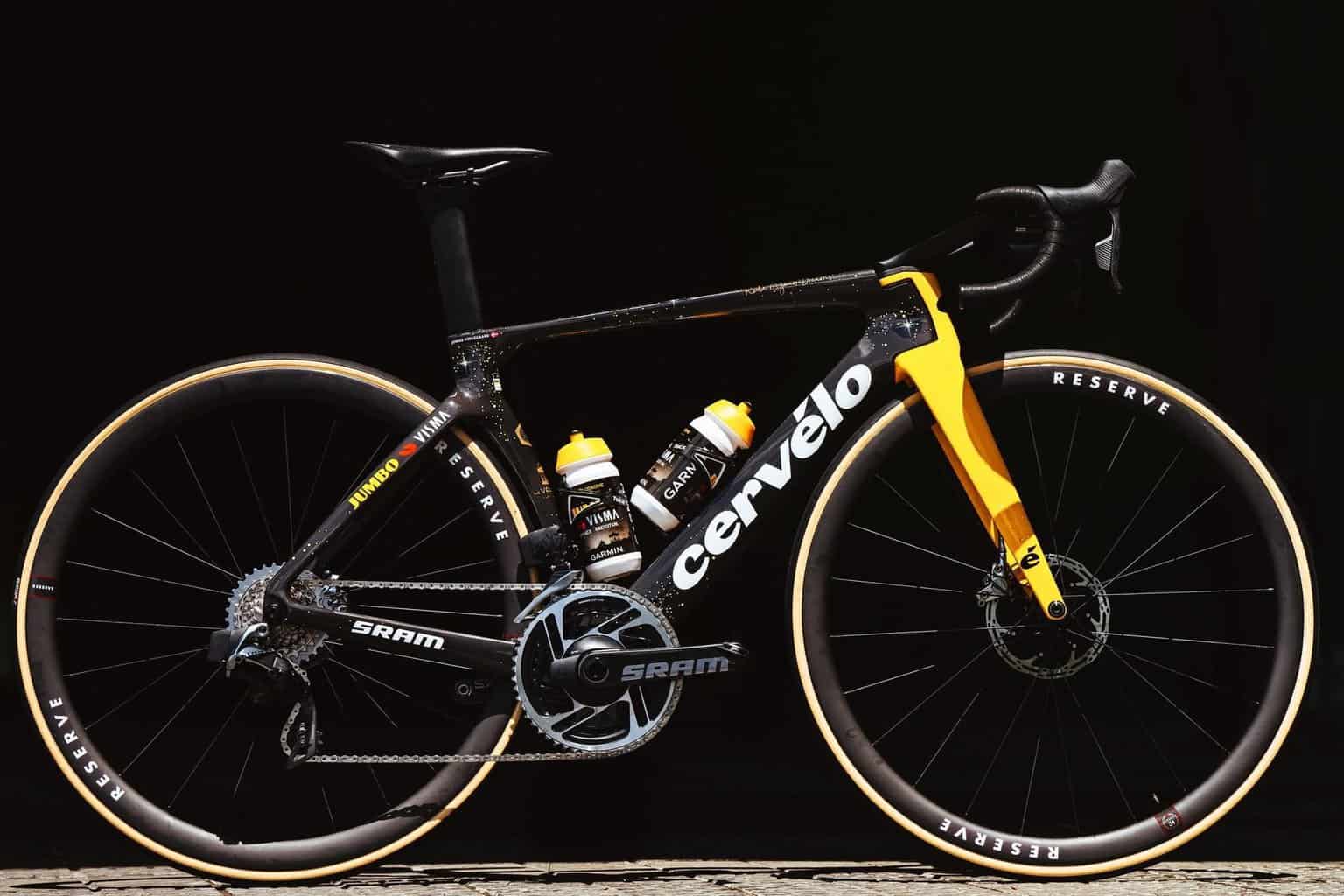
Jonas Vingegaard rode a Cervélo bike to his second Tour de France overall win in 2023 with SRAM Red eTap AXS electronic groupset and Reserve Wheels.
Depending on the stage profile, Jonas Vingegaard’s bike can be a Cervelo R5, S5, or P3.
- Cervélo R5 is an all-rounder, lightweight road race bike for the mountains.
- Cervélo S5 is an aero bike for the flat stages.
- Cervélo P5 is a time trial bike that Jonas rode to win the Stage 16 ITT.
Full specifications and setup of Jonas Vingegaard’s bike.
Cervelo bikes
2023 Cervelo R5 vs S5 vs Caledonia 5 vs Soloist
Cervelo S5 Frame Geometry (2018-2023)
Cervelo Soloist Frame Geometry (2022-2023)
Cervelo Caledonia Frame Geometry (2021-2023)
Cervelo Aspero Frame Geometry (2019-2023)
2023 Cervelo R5 Size Charts and Guide
Pinarello – 15 wins
L’auto – 10 wins, peugeot – 10 wins, gitane – 9 wins, trek – 10 wins, alcyon – 7 wins, eddy merckx – 5 wins, automoto – 4 wins, bianchi – 3 wins, colnago – 3 wins, helyett – 3 wins, la sportive – 3 wins, tour de france winning bikes by year.
Throughout 110 editions (up to 2023), the Tour de France has been won by 36 different bike brands . Many of these brands are unknown to cycling fans today. Few bike brands, such as Colnago, Pinarello , Specialized , and Trek , are synonymous with cycling fans today.
The road bike industry has undergone massive change and innovation in the past 20 years by introducing new technologies such as electronic shifting , carbon fiber frames, disc brakes, and tubeless tires .
This article will go back in history and explore all the Tour de France winning bikes .
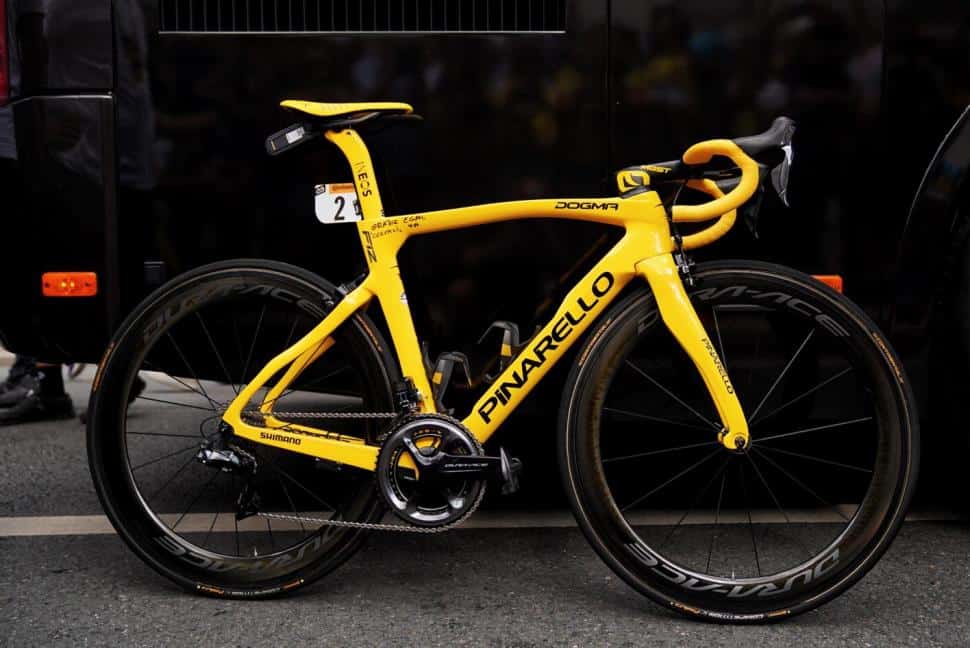
Pinarello has a long history in cycling, dating back to 19534, when it was founded by Giovanni Pinarello in Treviso, Italy. With 15 Tour de France wins, Pinarello is the most successful bike brand at the Tour de France.
Pinarello’s dominance at the Tour de France can be summed up in two eras.
- Mid-1990s. Miguel Indurain won four consecutive Tour de France from 1992 to 1995, followed by Bjarne Riis (1996) and Jan Ullrich (1997).
- Mid-2010s. Team Sky (Ineos-Grenadiers) won seven Tour de France with Bradley Wiggins (2012), Chris Froome (2013, 2015, 2016, 2017), Geraint Thomas (2018), and Egan Bernal (2019).
Today, Pinarello’s top-of-the-line bike is the Pinarello Dogma F .

L’Auto (now L’Equipe) is not a bike brand but the French newspaper that started the Tour de France in 1903.
From 1930 to 1939, Henri Desgrange, the newspaper’s owner, required all riders to paint their bikes’ downtube with L’Auto as part of the marketing campaign and publicity stunt to increase the race profile.
During that period, riders competed based on national teams, so there wasn’t any commercial conflict of interest.

Today, most of us know Peugeot as the French automotive brand. Peugeot started making bicycles way back in 1882 and won their first Tour de France with Louis Trousselier in 1905 and their last win came in 1977 with Bernard Thévenet.
In the past 50 years, the bicycle arm of Peugeot has gone through various ownership. Today it’s part of Cycleuope, which owns bike brands such as Bianchi and Gitane.
Here’s an interesting fact; Peugeot has a complete bike lineup from road to mountain, city, kids, and electric bikes.
2023 Tour de France Bikes and Gear
2023 Tour de France Sunglasses Brands and Models Guide
2023 Tour de France Helmets Brands and Models Guide
2023 Tour de France Bike Brands and Models Guide
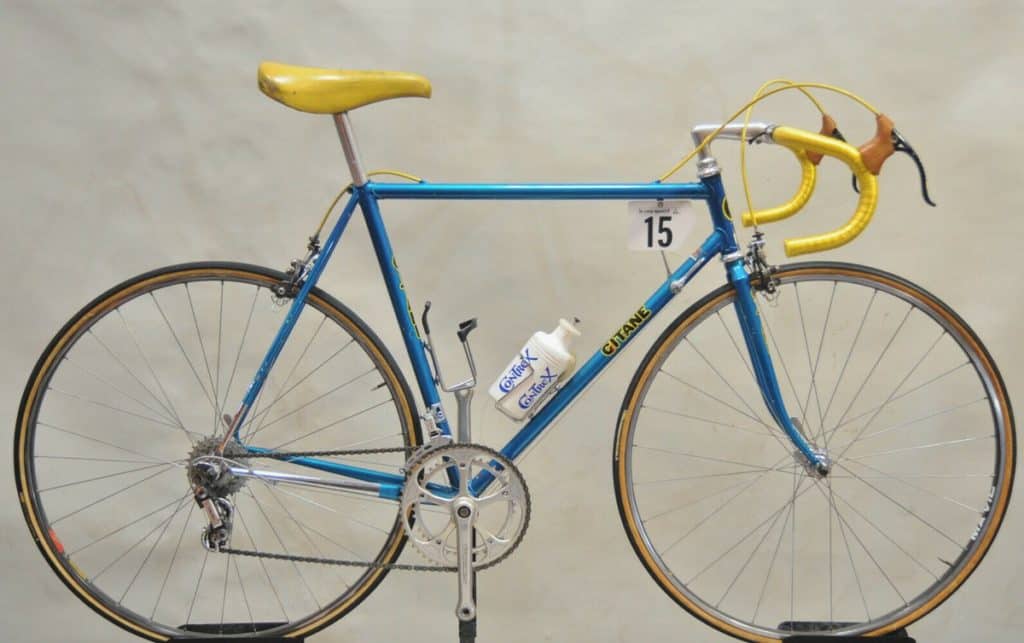
Gitane is a French bike brand synonymous with racing from the mid-1960s to the mid-1980s. All nine of Gitane’s Tour de France wins occurred during this period with legendary French riders such as Bernard Hinault (4), Jacques Anquetil (2), Laurent Fignon (2), and Belgian Lucien Van Impe (1).
Today, Gitane is part of Cycleuope, which owns the Bianchi and Peugeot bike brands. Gitane produces mostly city and mountain bikes today. They don’t have much presence outside of France.
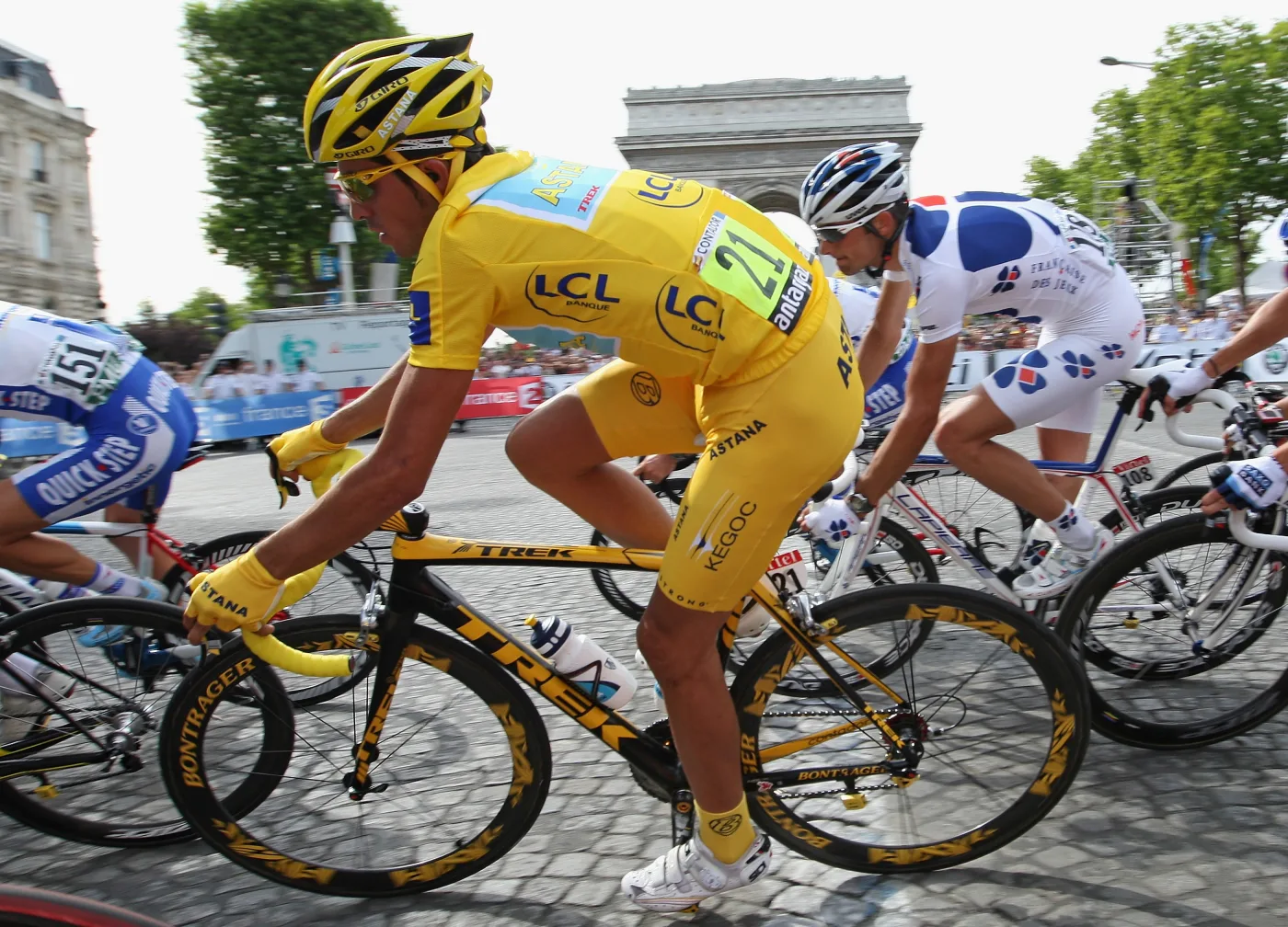
Founded in 1976, Trek is one of the leading bike brands today with its men’s and women’s World Tour teams.
Trek’s first Tour de France win was in 1999 by Lance Armstrong. For the next seven years until 2005, Lance Armstrong dominated the Tour de France, helping to raise Trek’s profile in the United States and worldwide. In 2012, all seven of Lance’s Tour de France wins were nulled.
Trek’s other three Tour de France wins were with Alberto Contador in 2007, 2009, and 2010 although the 2010 win was later nulled.
Trek offers the riders three types of road bikes; Trek Emonda (lightweight), Trek Madone (aero) and Trek Domane (endurance), and the Trek Speed Concept (TT).
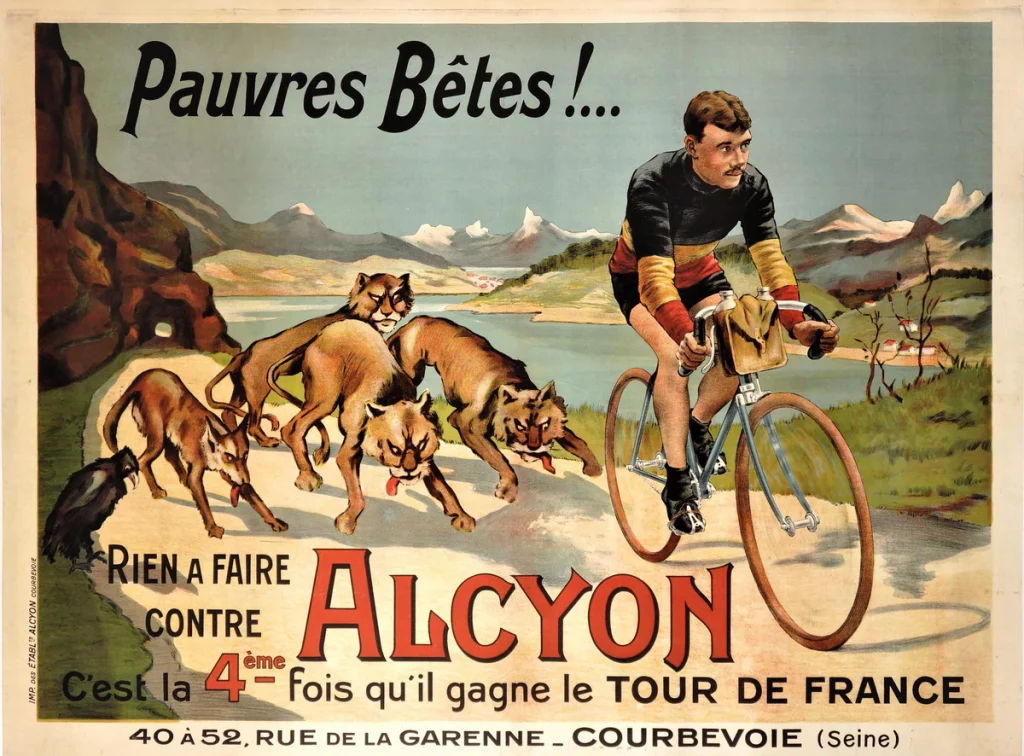
Alcyon was a French bicycle, motorcycle, and automotive brand active from 1903 to 1954. They sponsored their own cycling team from 1905 to 1959 under different names such as Alcyon-Dunlop, Alcyon-Soly, Alcyon-Armor, and Alcyon-Leroux
Their first Tour de France win was in 1909 with François Faber, a Luxembourgian rider. Their last win was in 1929 with Belgian Maurice De Waele. From 1930 onwards, the Tour de France organizers required the teams to paint their bikes’ downtube with L’Auto, the newspaper that started the Tour de France.
2023 Tour de France Riders’ Gear
Wout van Aert’s Red Bull Helmet at the 2023 Tour de France
Mark Cavendish’s Sunglasses at 2023 Tour de France
Mark Cavendish’s Shoes at 2023 Tour de France
Mark Cavendish’s Bike at 2023 Tour de France
Jasper Philipsen’s Bike at 2023 Tour de France
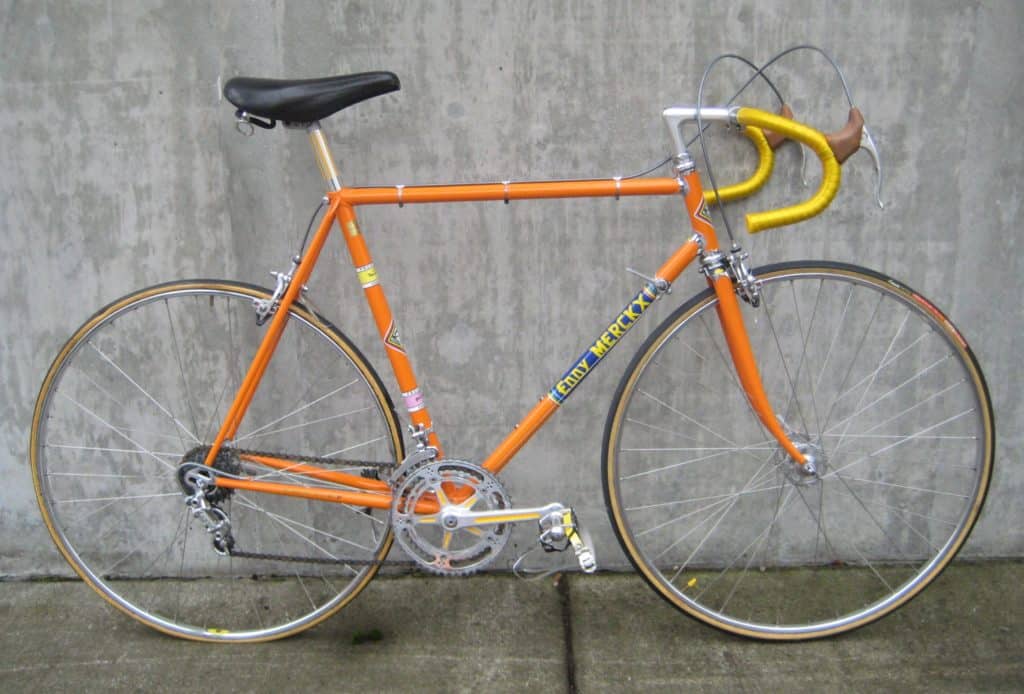
Eddy Merckx is no stranger to cycling fans. He’s widely known as the most successful cyclist of all time , winning the Tour de France (5 times), Giro d’ Italia (5 times), and 34 Tour de France stages .
The Eddy Merckx bike brand was only started in 1980 after he retired. Eddy Merckx was riding bikes built by Masi and Kessels with his name painted on the downtube for his five Tour de France wins.
In 2008, Eddy Merckx sold all his shares in the company to Sobradis, a Belgian holding company. In 2017, another Belgian company, Race Productions, which owns Ridley Bikes, took over Eddy Merckx after struggling with sales for the past decade.
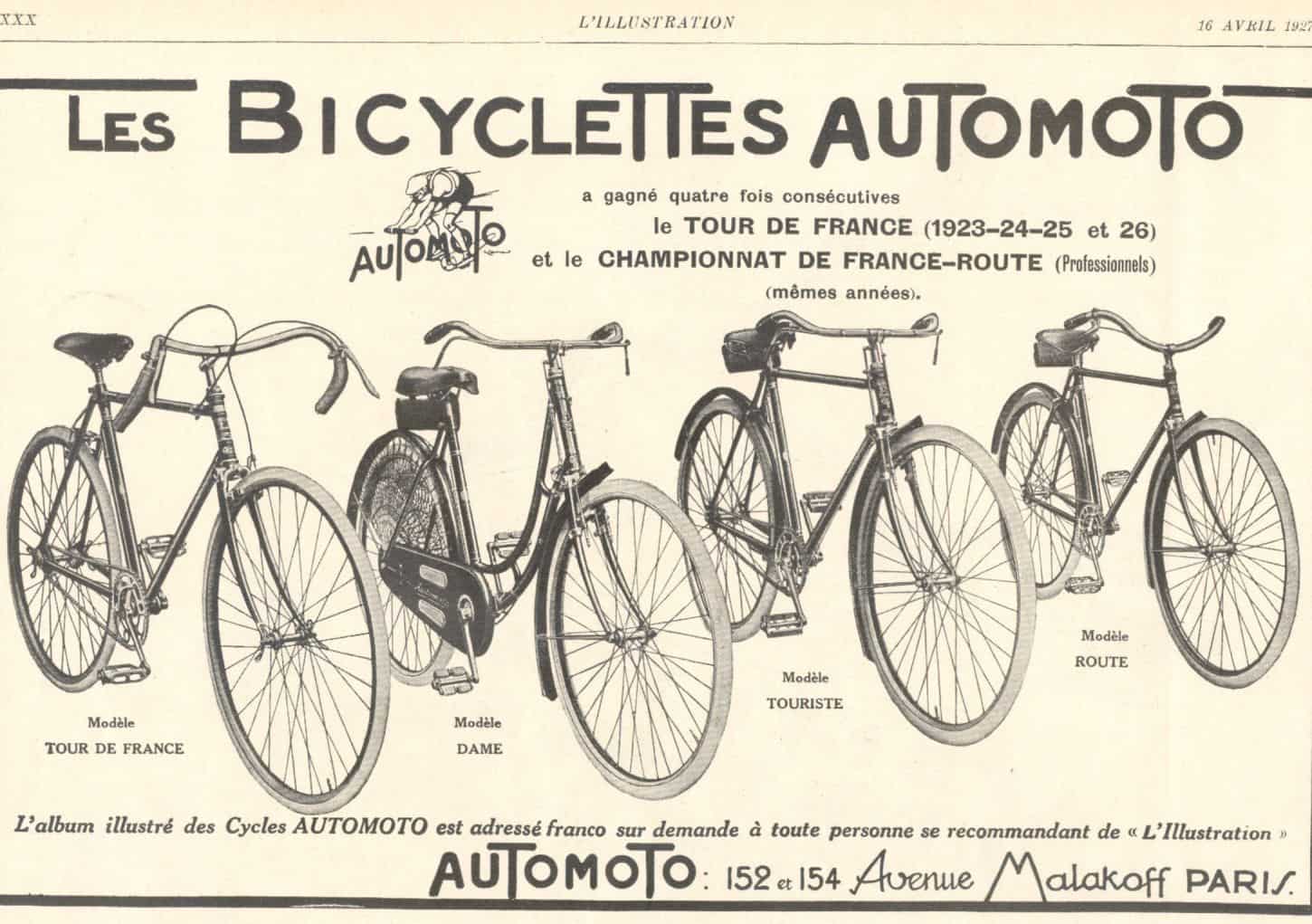
Automoto was a French bicycle and motorcycle manufacturer that started in 1902. It was the dominant bike brand in the mid-1920s, with four consecutive Tour de France wins from 1923 to 1923 with three different riders.
In 1930, it was bought by Peugeot and sadly discontinued in 1962.
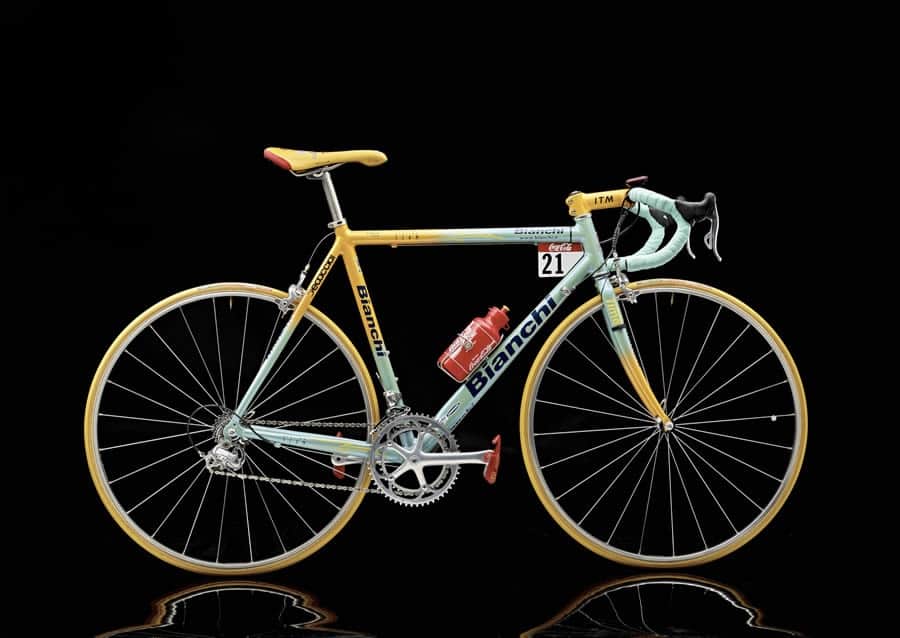
Bianchi is the oldest bicycle manufacturing company today. It was founded in Italy back in 1885 by Edoardo Bianchi who was a 21-year-old medical instrument maker.
All of Bianchi’s three Tour de France wins were achieved by Italian riders. Fausto Coppi won in 1949 and 1952 and Marco Pantini won in 1998. Bianchi was present at the World Tour with Team Jumbo-Visma (2014 to 2020) and Team BikeExchange (2021.
Team Arkea-Samsic will ride the Bianchi Oltre (aero) and Bianchi Specialissima (lightweight) at the 2023 Tour de France.
Today, Bianchi bikes are known for their Celeste color, also known as Bianchi Green.
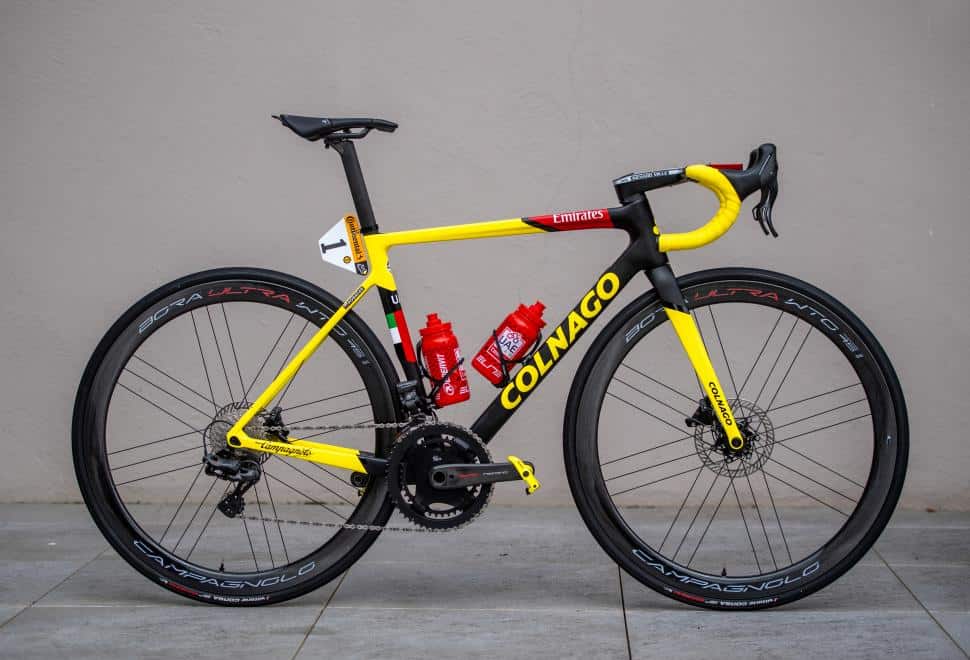
Colnago has a long history, dating back to 1952. It was founded by Ernesto Colnago near Milan, Italy. In May 2020, Chimera Investments LLC, based in the UAE, acquired a majority stake in Colnago.
Colnago’s first Tour de France win was in 1960 by Italian rider, Gastone Nencini. It was a long 60-year wait for their second win until Tadej Pogačar won two consecutive Tour de France in 2020 and 2021. He also won the Best Young Rider and Climber Classification in these two years riding the Colnago V3Rs .
In 2023, Tadej Pogačar will be riding the Colnago V4Rs in an attempt to win his third Tour de France General Classification .
Tour de France Race Guide
2023 Tour de France on TV Broadcasts Availability
2023 Tour de France Prize Money Breakdown
How is the 2023 Tour de France Time Limit Calculated?
What is the meaning of Tour de France Jersey Colors?
Why is the Tour de France So Popular?
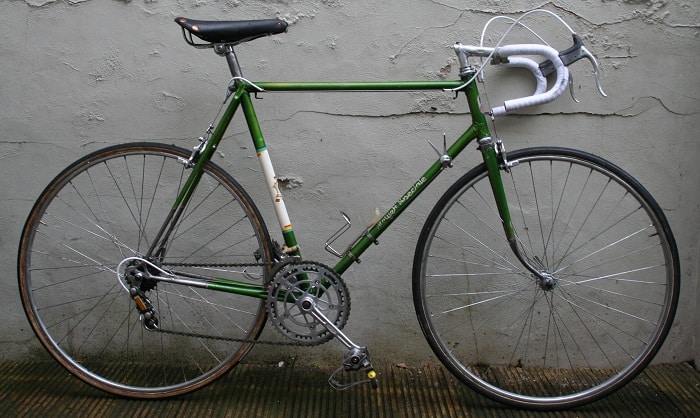
Helyett is a little-known French bicycle manufacturer started by the Picard brothers in 1926. It took its name from a lead character from a late 19th-century play, Miss Helyett, which is why the Helyett logo has a young women’s face on it.
Frenchman, Jacques Anquetil won three of his five Tour de France onboard a Helyett bike in 1957, 1961, and 1962.
La Sportive’s three Tour de France wins occurred right after World War 1, from 1919 to 1921. Right after the war, Europe was in bad shape and many bicycle manufacturers were either out of business or didn’t have the manufacturing capabilities.
The remaining brands include Alcyon, Armor, Automoto, Clément, La Française, Gladiator, Griffon, Hurtu, Labor, Liberator, Peugeot, and Thomann came together. They provided more than half the peloton with various bicycles and components so that the Tour de France can take place.
Once each brand recovered from the aftermath of World War 1, La Sportive disbanded in 1922.
Tour de France Records and Stats
How Many Rest Days in the 2023 Tour de France?
How Many Riders at the 2023 Tour de France?
How Many Stages in the 2023 Tour de France?
Tour de France Time Trial Winners’ Average Speed
What is the 2023 Tour de France Distance?
What is the Fastest Average Speed at the Tour de France?
Which Rider the Most Tour de France Appearances?

Alex Lee is the founder and editor-at-large of Mr. Mamil. Coming from a professional engineering background, he breaks down technical cycling nuances into an easy-to-understand and digestible format here.
He has been riding road bikes actively for the past 12 years and started racing competitively in the senior category during the summer recently.
Mr. Mamil's content is for educational and entertainment purposes only. The content is not a substitute for official or professional advice. Please do your own due diligence.
Mr. Mamil participates in the Amazon Services LLC Associates Program, an affiliate advertising program designed to provide a means for us to earn fees by linking to Amazon.com and affiliated sites. We also participate in various other affiliate programs, and at times we earn a commission through purchases made through links on this website.
Privacy Policy
Website Terms
© Mr. Mamil, 2023
- Help Center
- Chat with a Ride Guide
- 1-866-401-9636
- Retail Store
- Bike Services
Reset Password
We will send you an email to reset your password.
Don't have an account? Create an account
Create Account
Already have an account? Sign In
- Favorite your products & save them to your account
- Save a search & get notified when new products drop
- Be first to know about the latest events & promotions
Bike Finder
Results have arrived, the stage-winning bikes from the 2023 tour de france.
We are keeping track of which bikes win each stage of the 2023 Tour de France. We'll find out what bike manufacturers are dominant, and what drivetrains, wheels, and tires are regulars on the podium.
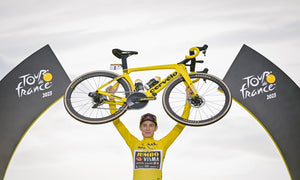
Written by: Bruce Lin
Published on: Jul 28, 2023
Posted in: Bikes
The Cervelo S5 may not have won any stages this year, but it helped Jonas Vingegaard take a much bigger prize: the Yellow Jersey. Photo: ASO/Pauline Ballet
The Tour de France is full of exciting race action, tragic defeats, and heroic moments. It's what makes the Tour so magical. But bike nerds like us are here for another reason: the bikes!
Riders, teams, and manufacturers all bring their best equipment to the Tour, so its the perfect place for us to geek out on new bikes, gear, and tech.
For the duration of this year's Tour, I'll be keeping track of what bikes are winning each stage. At the end, we'll have some fun data, and maybe some inspiration for how to equip our own bike quivers at home.
[button] Shop Road Bikes [/button]
2023 Tour de France - The Final Scores
The 2023 Tour de France is now done and dusted. After spending the first two weeks locked wheel to wheel with Tadej Pogacar, Jonas Vingegaard landed a couple killer blows on stages 16 and 17 to secure his second Tour victory. There were a lot of different winning bikes, and a few notable "losers." Let's review...

2023 Tour de France Jersey Winners
- General Classification - Jonas Vingegaard - Cervelo S5 / Cervelo R5
- Points Classification - Jasper Philipsen - Canyon Aeroad CFR
- Best young rider - Tadej Pogacar - Colnago V4Rs
- King of the Mountains - Guilio Ciccone - Trek Madone SLR / Trek Emonda SLR
The Yellow Jersey winner, Jonas Vingegaard, can be seen riding into Paris aboard his Cervelo S5 . This is the bike he used for the majority of this year's stages. He only switched to the lighter Cervelo R5 for the mountain stages, and it's what he rode on stage 17 when he took minutes out on Pogacar to essentially win the Tour.
Both Cervelo's have nabbed plenty of stage wins in the previous two years, but they came up short this year. The only Cervelo win was Vingegaard's Stage 16 TT win on the Cervelo P5 . But hey, winning the overall is a much bigger deal. One thing I want to point out is that Vingegaard rode many stages with a 1x drivetrain. Take a look at his S5 above, and you'll see the single chainring set-up. I've been preaching the gospel of 1x road for a while, and while Vingegaard did switch back to a 2x for the mountain stages, I do feel a bit validated!
The Green Jersey Winner, Jasper Philipsen and his Canyon Aeroad CFR were leagues ahead of everyone else. With 4 wins, they won the most stages this year and proved that they were the fastest combo on flat finishes.
The White Jersey winner, Tadej Pogacar, put up a brilliant fight on his Colnago V4Rs . Unlike Vingegaard, Pogacar used the same frame for every stage, opting only to swap to shallower ENVE SES 2.3 wheels on the hardest mountain stages.
The Polka-dot Jersey Winner, Guilio Ciccone, cleverly targeted the King of the Mountains and secured it late in the race on Stage 20. While he rode a polka-dot Trek Madone SLR into Paris, most of his KOM points were won on the lighter Trek Emonda SLR . Like Vingegaard, Ciccone had the option to switch between aero and all-rounder frames.
Stage-Winning Frames and Components

- Best Bike - Canyon Aeroad CFR - 4 wins
- Best Drivetrain - Shimano Dura-Ace Di2 - 18 wins
- Best Wheels - Shimano Dura-Ace C60 - 4 wins
- Best Tires - Continental Grand Prix 5000 S TR - 8 wins
Of course, since Jasper Philipsen got the most stage wins, so did his bike, the Canyon Aeroad CFR . But thanks to the efforts of Tadej Pogacar and Adam Yates, the Colnago V4Rs was a strong second with three wins.
Shimano Dura-Ace Di2 dominated most stages the Tour. It's not surprising since Shimano sponsors most of the teams. But even though Shimano groupsets won the majority of stages, it was SRAM AXS that took the overall. Interestingly, it looks like Vingegaard pairs Force AXS shifters with RED AXS drivetrains, likely because he likes the new revised hood shape . Also, I have to say it again — Vingegaard rode several stages on a 1x drivetrain. AWESOME.
Again, thanks to Philipsen, the Shimano Dura-Ace C60 wheels were the top wheel of the Tour with 4 wins, while Pogacar and Yates put the ENVE SES 4.5 into second with 3 wins. Interestingly, these wheels are close in depth, but Pogacar and Yates took their wins on hilly/mountain stages. It goes to show that deep aero wheels can win on climbs. Also, it's worth noting that Dura-Ace wheels took 2 additional wins with Ineos, but Kwiatkowski and Rodriguez rode the shallower Dura-Ace C36 to their two mountain stage wins.
The tubeless Continental Grand Prix 5000 S TR was the tire of the Tour with 8 wins. Again, like Shimano, Continental sponsors the most teams, so it's not that surprising. But independent rolling resistance testing has shown that the GP 5000 S TR is among the fastest of the fast. The tubeless Vittoria Corsa Pro TLR G2.0 , however, was the tire that took the overall under Vingegaard, and it did also win 4 stages thanks to Philipsen. We did see a few clinchers win (all the Specialized teams and Cofidis still use clinchers), and we did see Vingegaard bust out some tubulars in the early Basque stages. But the story of this Tour was one of tubeless domination.
The Formula for the Ultimate TdF Stage-Winning Bike
Frame: Canyon Aeroad CFR Drivetrain: Shimano Dura-Ace Di2 Wheels: Shimano Dura-Ace C60 Tires: Continental Grand Prix 5000 S TR
Aero bikes won more stages. Pair the most sucessful aero frame with a benchmark drivetrain, aero wheels, and the fastest tires, and maybe you can win more stages than Jasper Philipsen.
My Dream TdF Stage Winning Bike
Frame: Look Blade 795 RS Drivetrain: SRAM RED eTap AXS (1x) Wheels: ENVE SES 4.5 Tires: Vittoria Corsa Pro TLR G2.0
I just have to be different. I think the Look Blade 795 RS was the best looking new bike at the Tour, and I love that it finally broke the 15-year-long Cofidis win drought. Of course, me being a weirdo, it needs a 1x SRAM AXS drivetrain, just like Vingegaard used in many of the early stages this year. Then my favorite blingy wheels, the ENVE SES 4.5. Finally, I have to have bright, tanwall tires, so the Vittoria Corsa Pro is the pick for me.
Stage 01 Winner - Bilboa > Bilboa

Adam Yates (UAE Team Emirates) took the first Yellow Jersey of the race by beating his twin, Simon Yates (Team Jayco-AlUla), to the finish line after an extraordinary breakaway. This may be the first time a pair of twins have competed for a stage win at the Tour! Yates is riding the newly released Colnago V4Rs, which the UAE Team rode all of last year under the "Prototipo" guise. This year they also switched to Shimano drivetrains, ENVE wheels, and Continental tires.
Stage 02 Winner - Vitoria-Gasteiz > Saint-Sébastien

Victor Lafay (Cofidis) ended Cofidis' 15-year-long drought of Tour de France stage wins with a thrilling and powerful attack in the final meters of stage 2 to beat top favorites like Wout van Aert, Tadej Pogacar, and Tom Pidcock. He did it on Look's new Blade 795 RS. This French brand made the first carbon bike to win the Tour de France way back in 1986, and they brought us the first clipless pedals. Cofidis' Blade 795 RS is painted in Look's iconic Mondrian colors for the Tour.
Stage 03 Winner - Amorebieta-Etxano > Bayonne
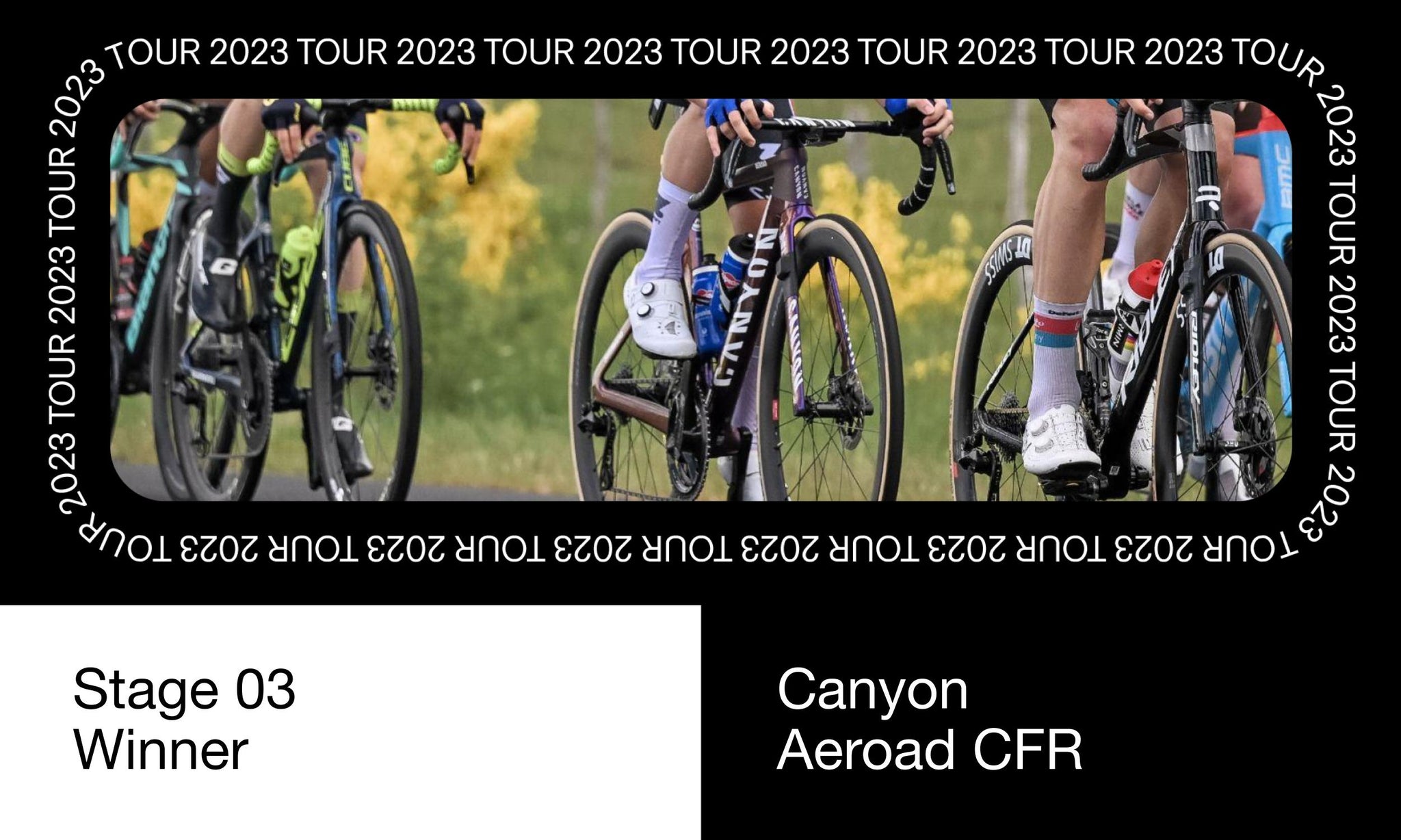
Jasper Philipsen (Alpecin-Deceuninck) took advantage of a monster leadout from Mathieu van der Poel to beat Phil Bauhaus (Bahrain-Victorious) and Caleb Ewan (Lotto-Dstny) to the line, proving that he is the sprinter to watch out for in this year's Tour. He did box out Wout van Aert (Team Jumbo-Visma) against the barrieers before the finish but was cleared by the race jury. Philipsen is riding Canyon's super fast and recently updated Aeroad CFR, which has a revised seatpost to reduce slips and squeaks. This is the same bike van der Poel used to win Milan-San Remo and Paris-Roubaix this spring so it's already a proven winner.
Stage 04 Winner - Dax > Nogaro
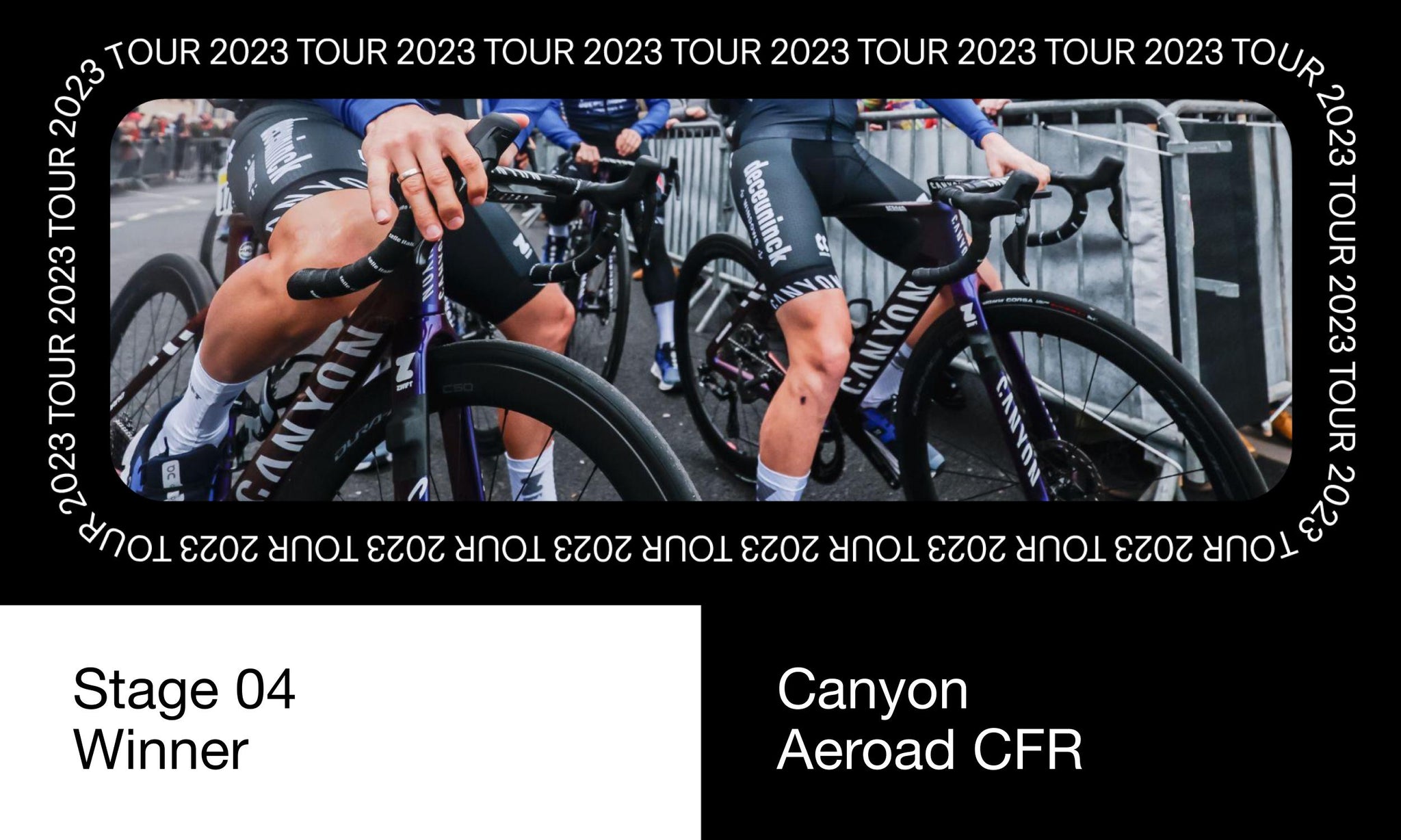
Jasper Philipsen (Alpecin-Deceuninck) has now won two stages in a row, beating Caleb Ewan (Lotto-Dstny) to the line once again and showing that he and Mathieu van der Poel might be the most potent sprinter/lead-out combo in the peloton. The finish was marred by several crashes, but Philipsen kept his Canyon Aeroad CFR safely ahead of all the chaos to take the win.
Stage 05 Winner - Pau > Laruns
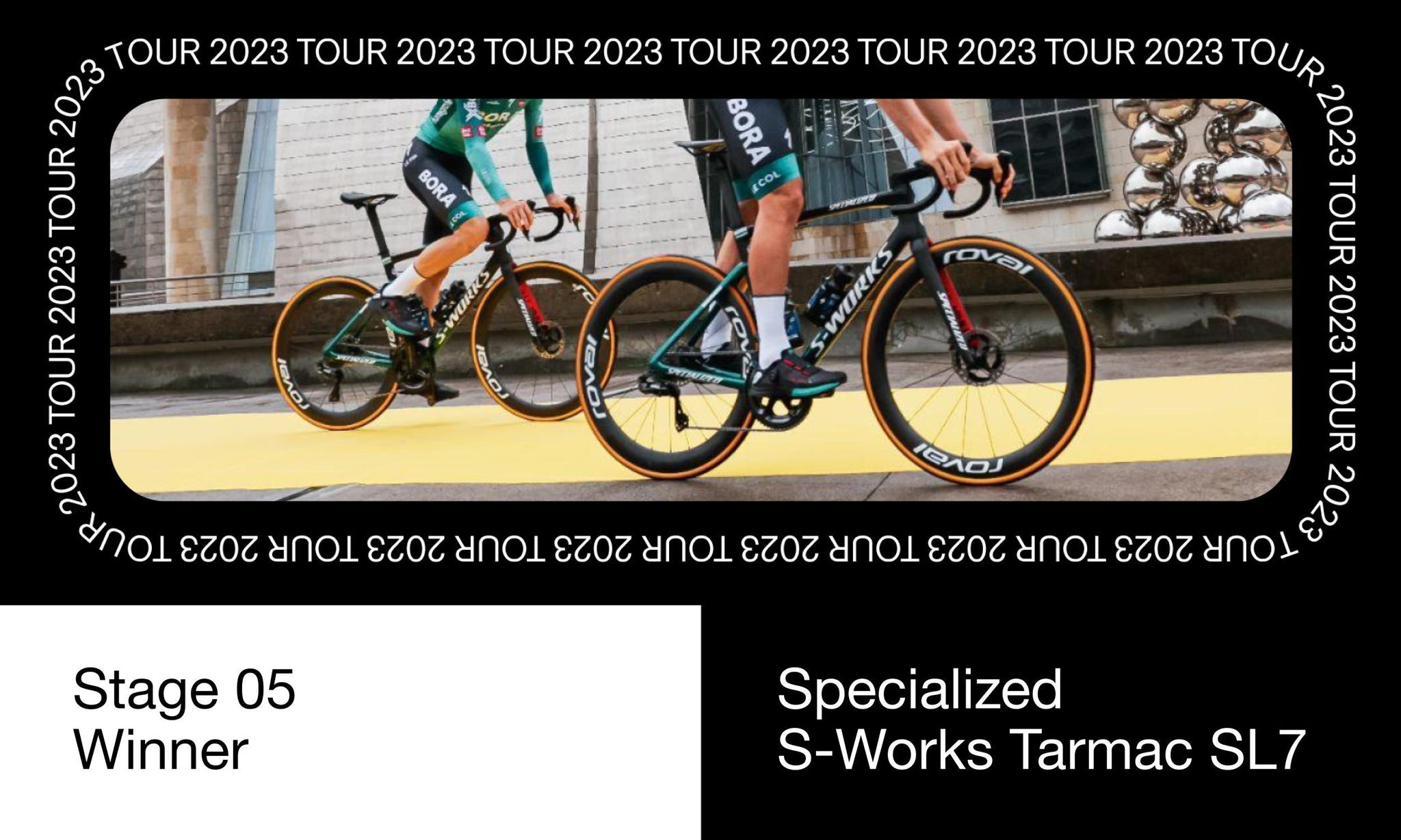
Jai Hindley (Bora-Hansgrohe) snuck into a large breakaway group to win the Tour's first mountain stage and snatch the Yellow jersey. Not only did the established favorites get caught out, but Adam Yates and two-time winner, Tadej Pogacar (UAE Team Emirates), lost significant time to last year's winner, Jonas Vingegaard ( Team Jumbo-Visma ), who moved into second. Hindley performed his coup on the Specialized S-Works Tarmac SL7, one of the most popular modern road racing bikes. Introduced in 2020, it combined Venge-killing aerodynamic efficiency with the Tarmac's agility and light weight to create a do-it-all racer that's super fast on flat and mountainous terrain. Interestingly, Bora, as well as the other two Specialized teams, are actually running still the old S-Works Turbo Cotton clincher tire, even though there's a new tubeless version of the Turbo available. Bora has stated that it does switch to the tubeless version for wet stages.
Stage 06 Winner - Tarbes > Cauterets-Cambasque

Tadej Pogacar (UAE Team Emirates) struck back after losing time to his main rival, Jonas Vingegaard (Team Jumbo-Visma) yesterday. Attacking on the final climb, Vingegaard was unable to follow, and Pogacar took the stage win, 24 seconds, as well as 10 bonus seconds. Vingegaard, however, is now in the Yellow Jersey, but the gap between the two is only 25 seconds. It's looks like it's going to be a big fight in the mountains. Pogacar has a much better kick, and might take a few more stage wins on his Colnago V4Rs. Fun fact: while Ernesto Colnago had been building Tour-winning bikes for decades, when Pogacar won his first Tour back in 2020, it was actually the first Tour win for a Colnago-branded bike.
Stage 07 Winner - Mont-de-Marsan > Bordeaux
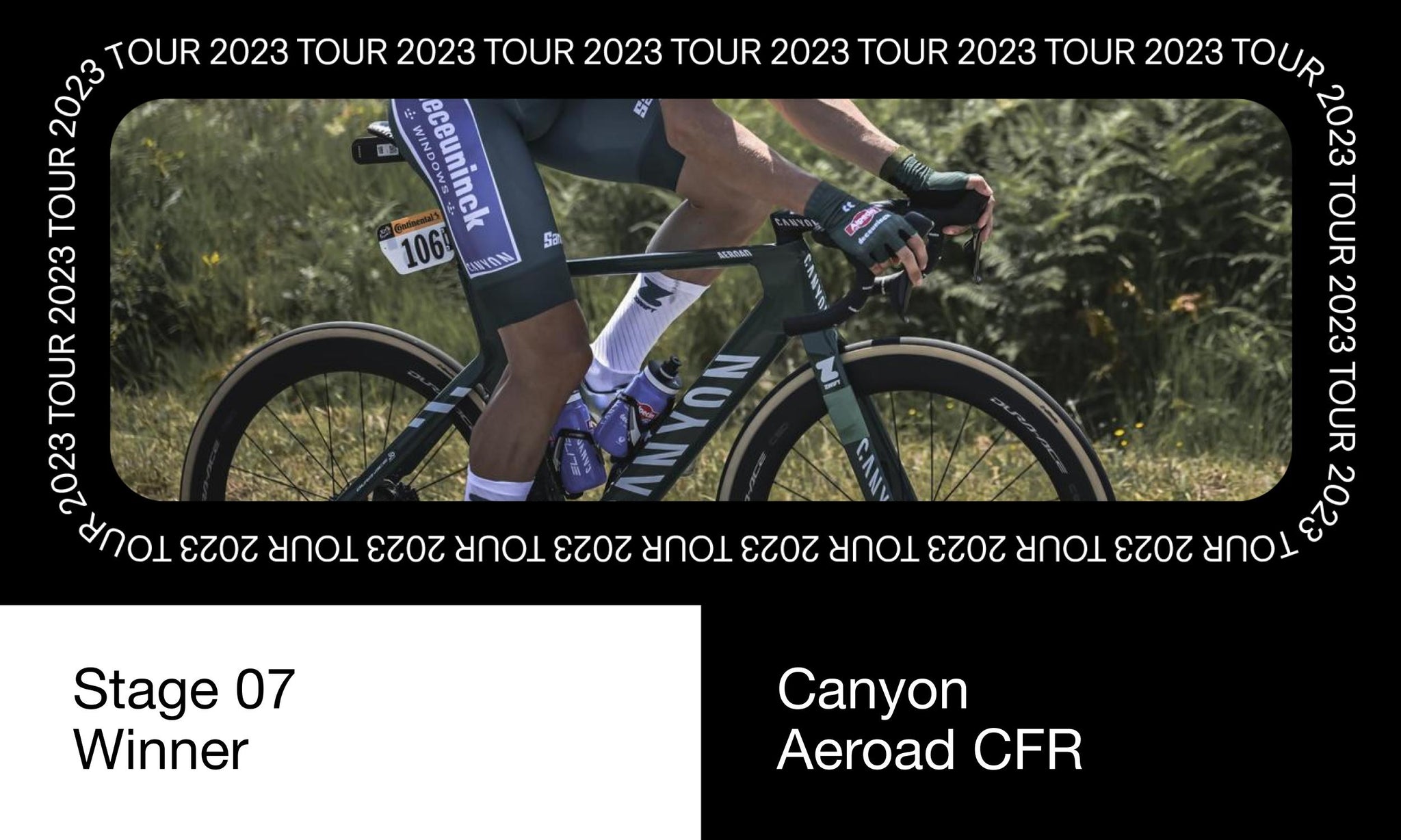
After three sprint stages, Jasper Philipsen (Alpecin-Deceuninck) and his Canyon Aeroad CFR have scored a hat trick of wins. He really is the fastest sprinter this year, and with three more flat stages in this year's Tour, there's a very good chance we'll see Philipsen and the Aeroad CFR take the top step again. Of note, Mark Cavendish (Astana Qazaqstan Team), took second, and looked oh so close to beating the Tour stage win record. The next chance for the sprinters will be stage 11, so we'll hopefully get a few different riders and bikes in the mix soon!
Stage 08 Winner - Libourne > Limoges
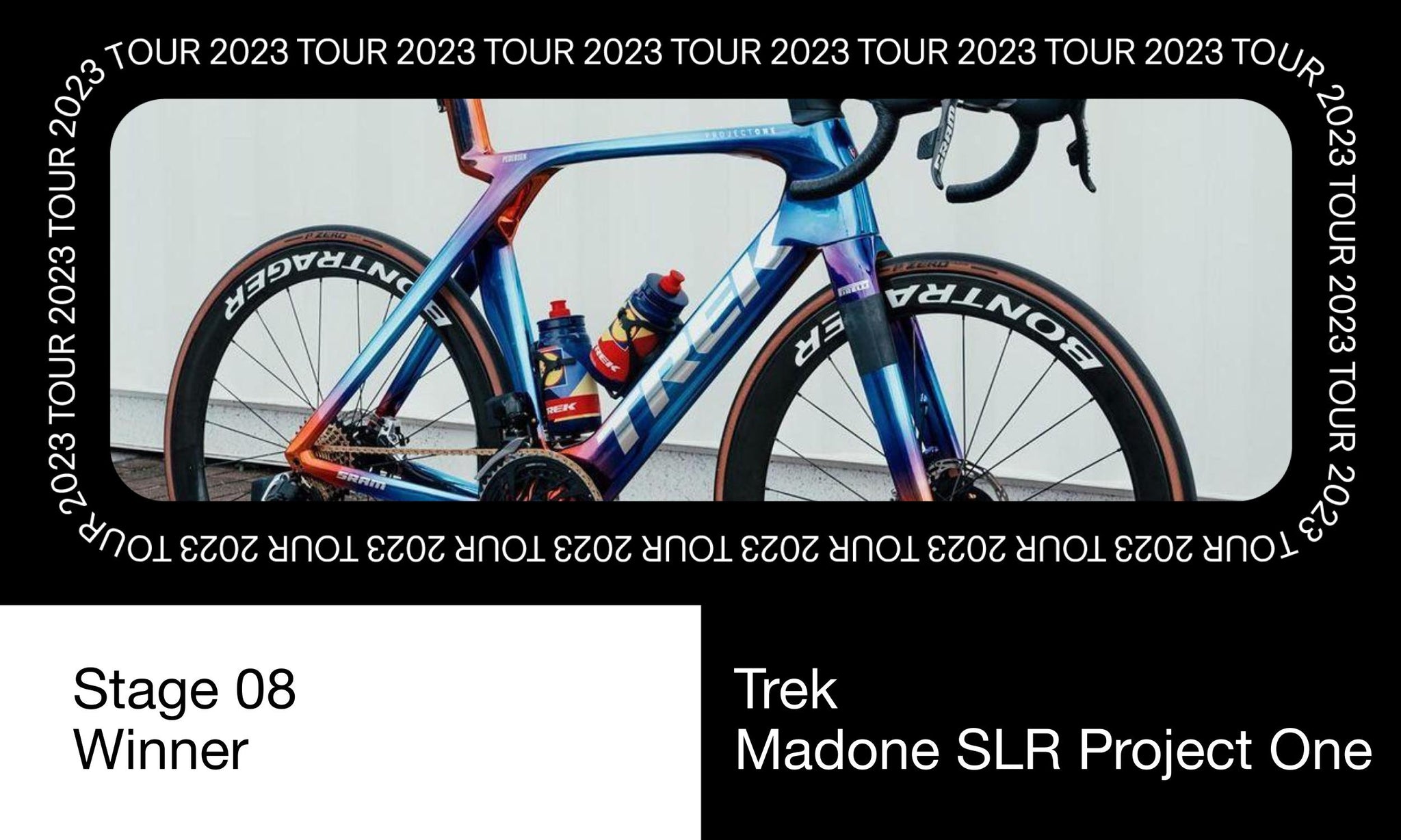
Mads Pedersen (Lidl-Trek), finally broke Jasper Philipsen's winning streak in Limoges. The story of the day, however, was Mark Cavendish's crash and subsequent abandonment due to a broken collarbone. Pedersen is aboard the new Trek Madone SLR Project One. The Madone received a major update for 2023 with an "IsoFlow" opening in the seattube to enhance aerodynamics and improve comfort. It is also the first SRAM-equipped bike to win a stage. Pedersen's bike features a custom oil-slick Project One paint job for the Tour. Interestingly, he runs a massive 56-tooth outer chainring plus a gold Flattop chain, which SRAM reserves for world champions like himself.
Stage 09 Winner - Saint-Léonard-de-Noblat > Puy de Dôme

In the GC fight, Pogacar has now closed to 17 seconds behind Vingegaard, but it was the breakaway that won the day. Michael Woods (Israel-Premier Tech) judged his effort perfectly to take one of, if not the biggest win of his career. Woods overhauled a fading Matteo Jorgenson (Movistar Team) in the final meters of Puy de Dome aboard his Factor OSTRO VAM. Factor is a small British brand and the OSTRO VAM is its latest aero all-rounder. Since Israel-Premier Tech is also sponsored by FSA, this is one of the few bikes to run a mixed drivetrain, with Shimano components paired with an FSA carbon crankset.
Now that was an exciting opening 9 stages! We're witnessing an incredible battle between the two favorites — Jonas Vingegaard and Tadej Pogacar — and it's not clear (yet) who will be the strongest in the final week.
While everyone catches their breath on the first rest day, here are some quick hit stats:
Most Wins - Canyon Aeroad CFR
With three wins, the new Canyon Aeroad CFR has been the king of the first half of the Tour. This is entirely down to Jasper Philipsen's domination of the sprint stages. So far, the Colnago V4Rs is the only other bike with multiple stage wins (2).
Shimano vs. SRAM
Shimano holds a strong 8-1 lead over SRAM. It's not too surprising since SRAM only sponsors 2 of the 22 teams at the Tour. Campagnolo sponsors one (AG2R) and the rest are running Shimano. However, since SRAM sponsors Jumbo-Visma, I think we can expect some more stage wins as the Tour continues.
Tubeless vs. Clincher
I'll have to do some deeper investigating to be sure (many teams use a mix of tubeless, clincher, and tubular wheels), but it appears that 7 out of 9 stages so far have been won on tubeless tires. This shift started a few years ago, and at this point, all the top teams have the option to run tubeless set-ups. Victor Lafay and Jai Hindley are the only stage winners riding clinchers. The Cofidis team do also have wheels and bikes set up with tubulars, and Bora says it uses tubeless tires for wet stages or poor conditions. But it seems that most of the time they still prefer the clincher, probably with latex tubes.
Stage 10 Winner - Vulcania > Issoire
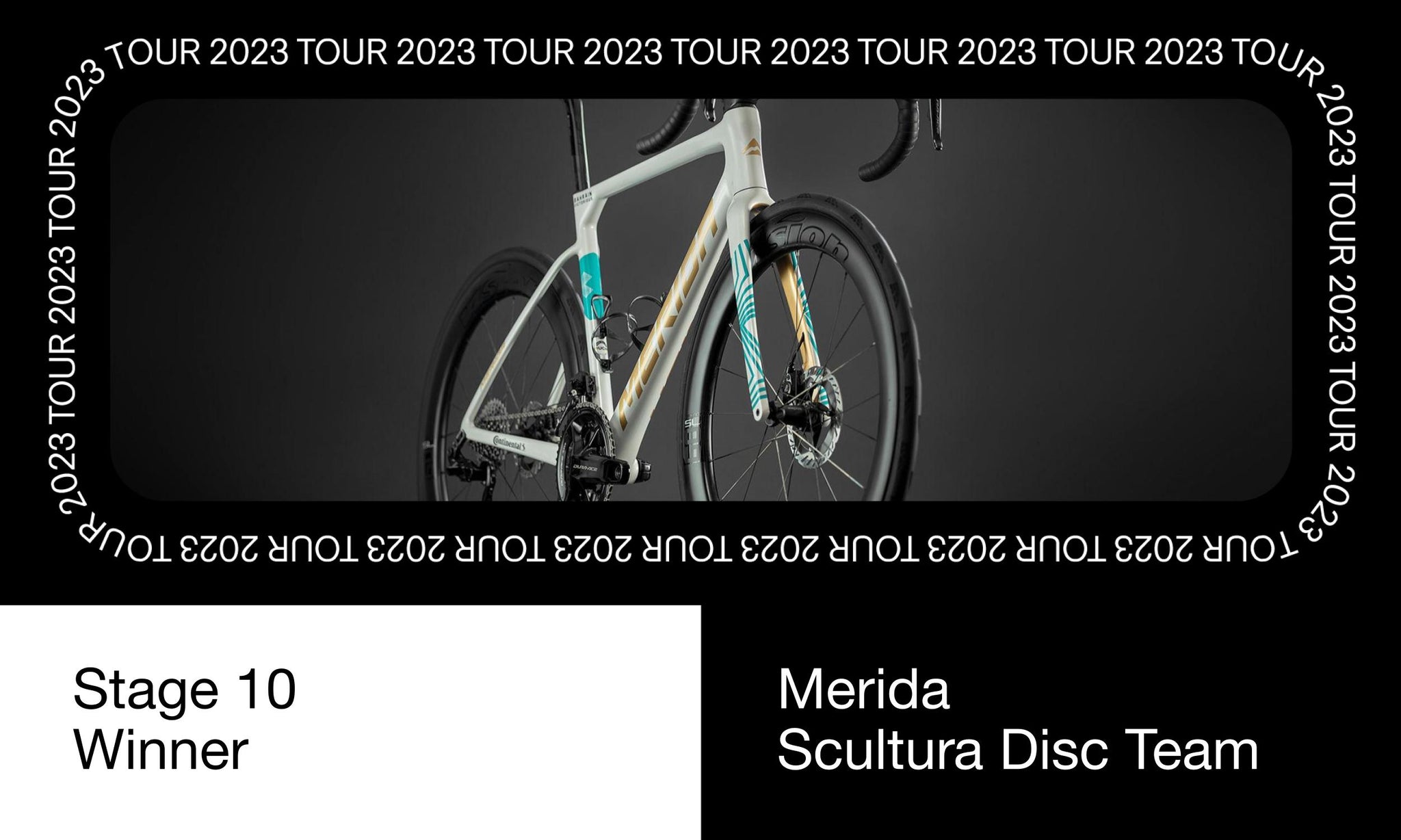
The breakaway was expected to prevail today, and Pello Bilbao (Team Bahrain Victorious) came out on top in the final sprint. He dedicated his first Tour stage win to his late friend and teammate, Gino Mäder, who tragically passed away after a crash during this year's Tour de Suisse. In Gino's memory, Bilbao has promised to plant trees in deforested areas, an obsession of Mäder's. Bilboa has been donating €1 to Mäder’s charity for every rider he beats in each stage, and promised to donate double if he won a stage.

As for the bike, Bilboa rode a Merida Scultura Disc Team. Merida is a Taiwanese manufacturer, who like Giant, actually manufactures frames for many other brands as well. The fifth-generation Scultura was released at the end of 2021 and incorporated new aero touches from Merida's Reacto aero bike. Team Bahrain brought frames with "Pearl-inspired" white paint, but Bilboa is riding a black bike, likely to commemorate Mäder.
Stage 11 Winner - Mont-de-Marsan > Bordeaux

Jasper " Disaster the Master" Philipsen (Alpecin-Deceuninck) and his Canyon Aeroad CFR are looking unbeatable this year with 4 wins now. Philipsen didn't even need a leadout from Mathieu van der Poel this time. He jumped on the wheel of Dylan Groenewegen (Jayco–AlUla) in the final meters and steamed past. Philipsen clearly has the power and the positioning. Maybe his new aero bike is just that much more slippery than everyone else's.
Stage 12 Winner - Roanne > Belleville-en-Beaujolais
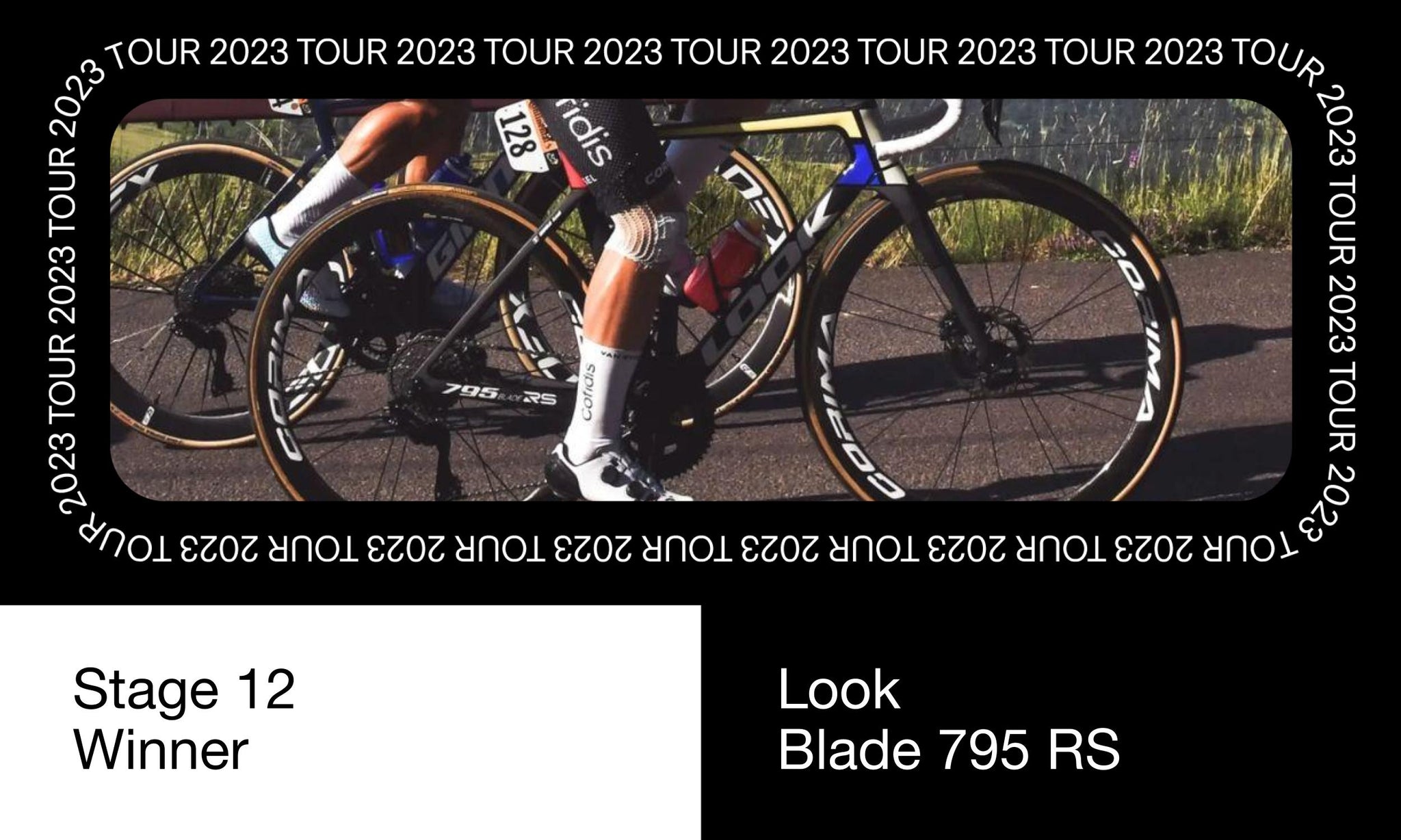
Rider: Ion Izagirre Insausti Bike: Look Blade 795 RS Drivetrain: Shimano Dura-Ace Di2 Wheels: Corima WS EVO 47 Tires: Michelin Power Cup Competition Line Bike Type: Aero/All-Rounder Stage Type: Hilly

Ion Izagirre Insausti (Cofidis) took advantage of a chaotic day to go off the front alone and secure a second stage win for Cofidis. This is the French team's best performance in over a decade after a 15-year-long drought of Tour de France stage wins, and it's Izagirre's second Tour stage win after he took his first seven years ago. Interestingly, like his teammate and Stage 2 winner, Victor Lafay, Izagirre appears to be riding the Corima WS EVO 47 wheels with clinchers (instead of tubulars) rather than the higher-end Corima MCC EVO 47 wheels. Also, after seeing it again, I am starting to thing that Look's new Blade 795 RS in the iconic Mondrian colors might be the best looking bike at this year's Tour.
Stage 13 Winner - Châtillon-sur-Chalaronne > Grand Colombier
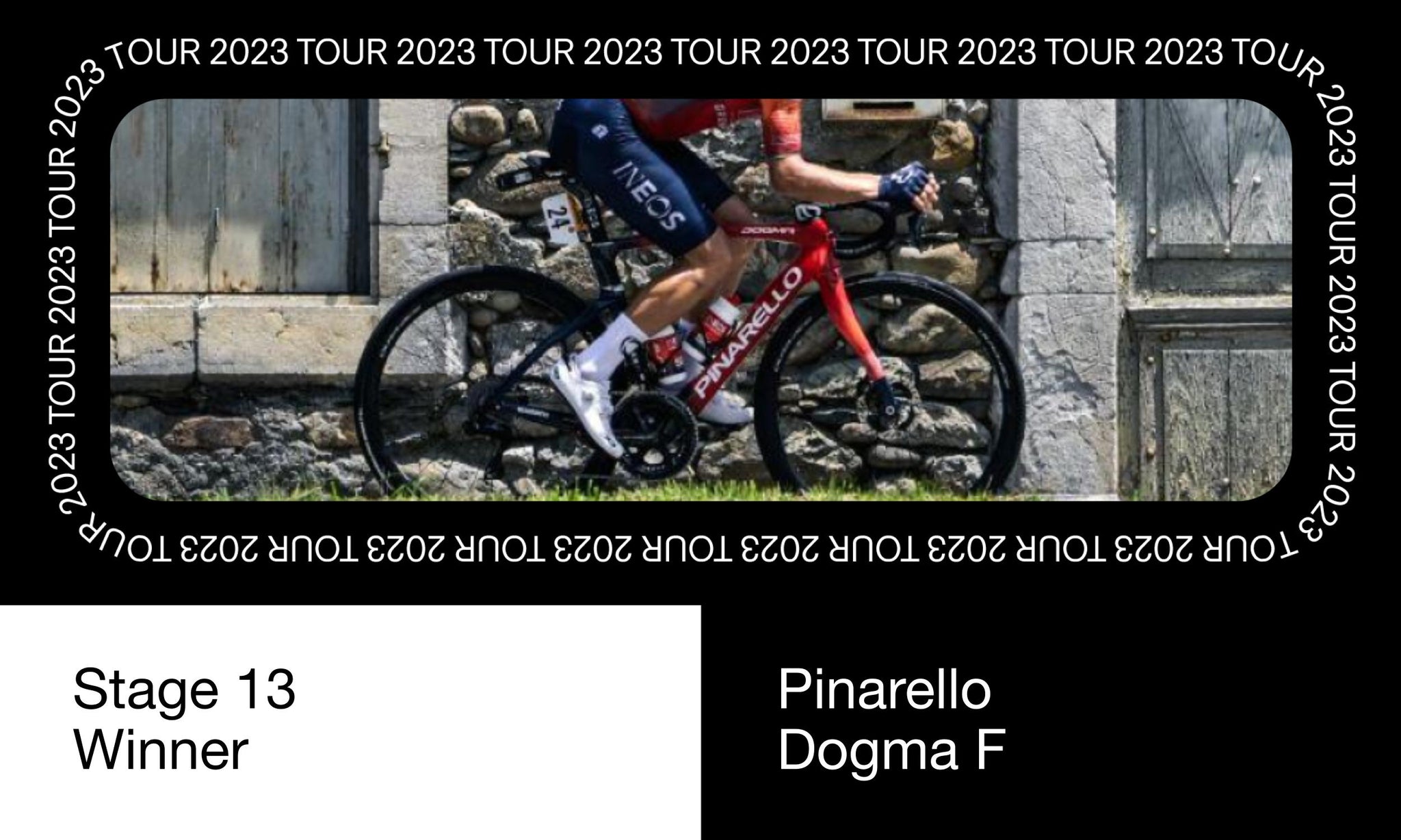
Rider: Michal Kwiatkowski Bike: Pinarello Dogma F Drivetrain: Shimano Dura-Ace Di2 Wheels: Shimano Dura-Ace C36 Tires: Continental Grand Prix 5000 S TR Bike Type: Aero/All-Rounder Stage Type: Mountain
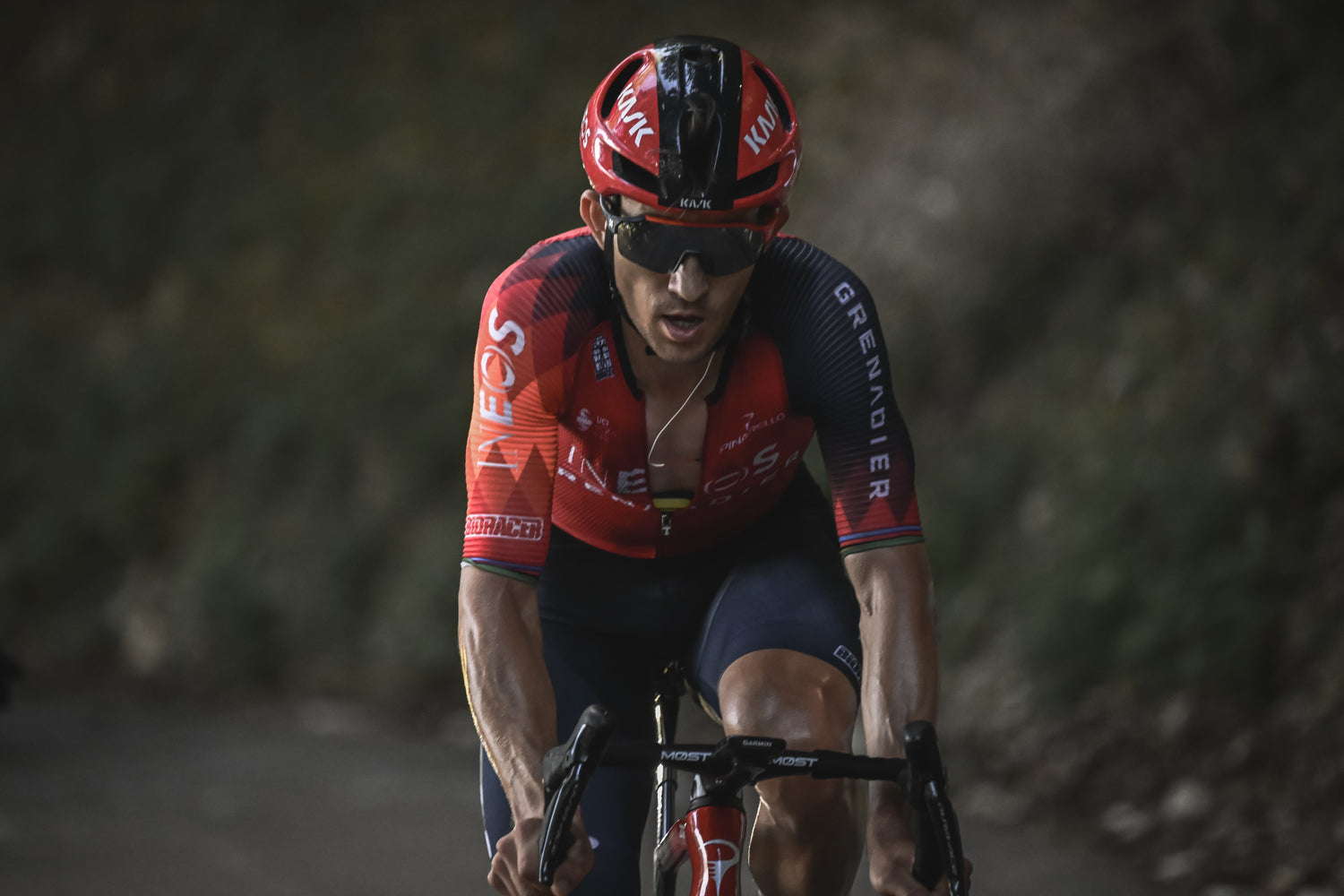
Former world champion, Michal Kwiatkowski (Ineos Grenadiers) dropped the breakaway to take the summit finish of the Grand Colombier. Pogacar also managed to take another 8 seconds on Vingegaard with a late burst. Ineos (formerly Team Sky) has been riding the Pinarello Dogma for over a decade. The current Dogma F replaced the Dogma 12 in 2021. It continues to use Pinarello's trademark asymmetric frame design, but I'm always sad that the current Onda fork and rear stay design don't use the quirky wavy carbon the Dogma used to be so well-known for.
Stage 14 Winner - Annemasse > Morzine Les Portes du Soleil

Rider: Carlos Rodriguez Bike: Pinarello Dogma F Drivetrain: Shimano Dura-Ace Di2 Wheels: Shimano Dura-Ace C36 Tires: Continental Grand Prix 5000 S TR Bike Type: Aero/All-Rounder Stage Type: Mountain
Carlos Rodriguez makes it two stages in a row for the Ineos Grenadiers and the Pinarello Dogma F. He paced his effort perfectly to bridge back to the front after getting dropped on the final climb and went alone to the win on the descent. He's now taken third in the GC away from Jai Hindley, but the two are separated by a single second. Likewise, the battle for first between Vingegaard and Pogacar remains a battle for seconds as the two remained glued together. With time gaps this close, maybe the podium in Paris will be determined by whose bike is slightly more aero...
Stage 15 Winner - Les Gets les Portes du Soleil > Saint-Gervais Mont Blanc

Another brutal day in the mountains and Wout Poels (Team Bahrain Victorious) took the win to give his team its second stage of this year's Tour. When he launched an attack on his Merida Scultura Disc Team, the other Wout (van Aert) didn't respond. He took the win nearly 3 minutes up on van Aert. Once again, there's nothing separating Vingegaard and Pogacar, the GC leaders, who came in several minutes behind Poels. Like his Bahrain Victorious teammate, Pello Bilbao, who won stage 10, Poels is riding the lightweight Merida Scultura for this tough and mountainous stage. He also switched to shallower 45mm Vision wheels.
The GC race between Jonas Vingegaard and Tadej Pogacar is still incredibly tight. They've been stuck to each other on every stage, which has allowed several opportunists to sneak away and steal stage wins as the Jumbo and UAE teams spend all their time and energy marking at each other.
Double Stage Winners
Several teams and bikes have had a relatively good Tour so far, winning two (or more) stages:
- Alpecin-Deceuninck - Canyon Aeroad CFR - 4 wins!
- UAE Team Emirates - Colnago V4Rs - 2 wins
- Cofidis - Look Blade 795 RS - 2 wins
- Team Bahrain Victorious - Merida Scultura Disc Team - 2 wins
- Ineos Grenadiers - Pinarello Dogma F - 2 wins
Of these multi-stage winners, the biggest surprise has to be the Look Blade 795 RS of Cofidis. After 15 years without a Tour stage win, to take two on a brand new bike makes the new Blade 795 RS look very promising. I also think it might be the best looking bike in the Tour right now.
What Bikes Are Underperforming?
Of course, it's riders who win, not bikes, but sometimes, you expect certain bikes to win because they're ridden by exceptional teams and riders. Personally, I'm surprised that Specialized and Cervelo haven't taken more wins.
Specialized sponsors 3 teams at the Tour, all with high-power riders capable of winning stages. The Tarmac SL7 was also hailed upon its release as the king of aero all-rounders. But this year it's only taken a single stage with Jai Hindley.
Cervelo is sponsoring Jumbo-Visma and Wout van Aert, a team and rider that have won multiple stages at the Tour over the last few years. But with a major focus on keeping Jonas Vingegaard in yellow, van Aert and the team perhaps don't as much freedom to chase stage wins this year, though van Aert has come very close on several occasions.
What's Coming Up Next?
The next stage is the first and only time trial of this year's Tour. The winning rider will need a lot of horsepower, but also a very slippery bike. When seconds matter, reducing aerodynamic drag to save a few watts can be the difference.
I also expect to see some serious fireworks between Jonas Vingegaard and Tadej Pogacar in the time trial and the final couple of mountain stages. Maybe Cervelo will finally nab a stage win? Even if they don't, making it to Paris in the Yellow jersey is perhaps the bigger prize.
Stage 16 Winner - Les Gets les Portes du Soleil > Saint-Gervais Mont Blanc
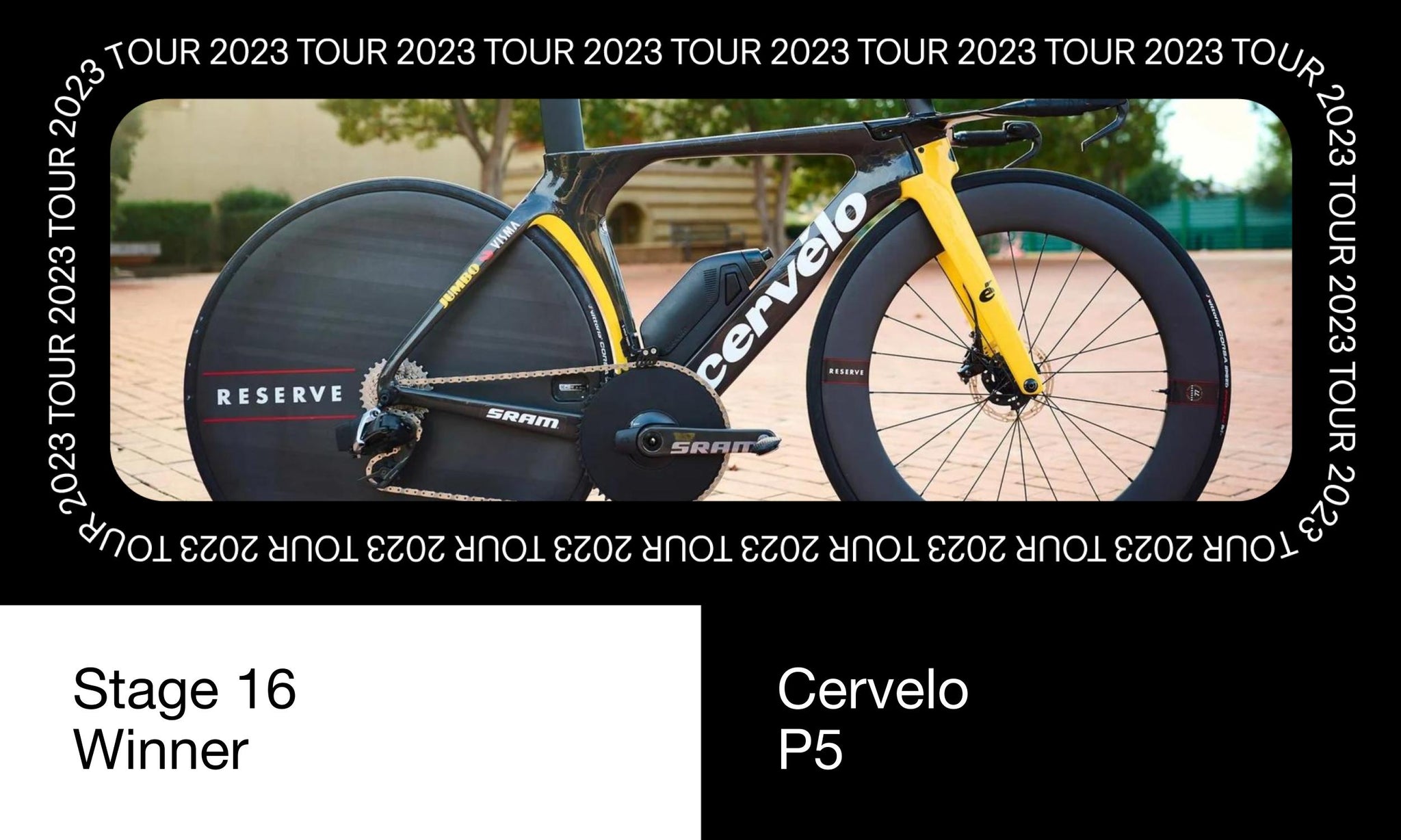
I thought Jonas Vingegaard (Team Jumbo-Visma) might make it all the way to Paris without a stage win, but he had the TT of his life today, taking a commanding win and pulling out an additional 1 min 38 sec over Tadej Pogacar (who chose to switch to a road bike for the final climb of the TT). Cervelo is well-known for its class-leading aero bikes, and the P5 TT bike has definitely shown itself to be very fast since Vingegaard's teammate, Wout van Aert, rounded out the podium. It's equipped with a 1x wireless SRAM RED AXS drivetrain, with a massive aero chainring, a full rear disc from Reserve, and Vittoria's Corsa Speed G+ 2.0 TLR tires which are among the fastest road tires ever tested.
Stage 17 Winner - Saint-Gervais Mont-Blanc > Courchevel

While the big news is that Jonas Vingegaard increased his lead over Tadej Pogacar to a massive 7 minutes and 35 seconds, it was Felix Gall (AG2R Citroën Team) who took the Queen stage win aboard his BMC Teammachine SLR 01. The Teammachine is BMC's high-tech aero all-rounder, but it's particularly unique because it's the only bike in the peloton equipped with Campagnolo. AG2R are running the recently released Super Record EPS electronic groupset, which the team help develop and test. The latest Super Record group is a big shift for the legendary Italian component maker as it's a wireless disc-brake-only group which also does away with Campy's iconic thumb shifters. At $5,399 for a complete group, it's also absurdly expensive!
Stage 18 Winner - Moûtiers > Bourg-en-Bresse
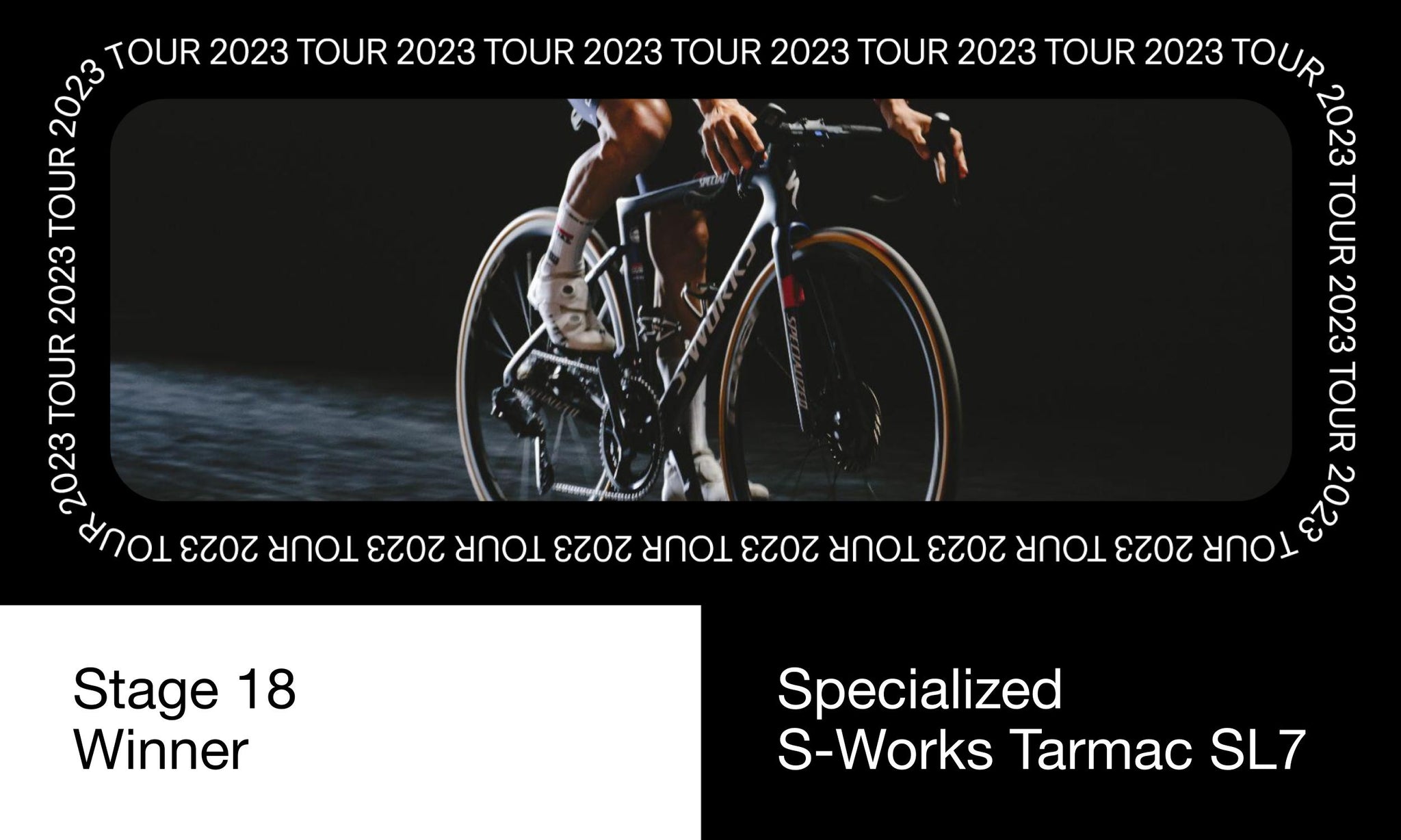
Kasper Asgreen (Soudal Quick-Step) got into a four-man breakaway that displayed exceptional teamwork to hold the peloton at bay and disappoint the sprinters in a thrilling finish. It's the second stage win for the Specialized S-works Tarmac SL7. Asgreen's bike is essentially the same as the bike Jai Hindley used to win stage 4, with one notable exception. It seems that like the other two Specialized teams — Bora and Team TotalEnergies — riders at Quick-Step are still using the older Specialized S-Works Turbo Cotton clincher tire, in some cases with the older Roval Rapide CLX wheels instead of the Rapide CLX II. A possible explanation is that the older clincher set-up is a bit lighter (around 100 grams) than the newer tubeless wheel and tire combo. He may also prefer the tubular-like ride quality of the Turbo Cotton tires. Either way, it's a proven winner since Asgreen won Tour of Flanders in 2021 on this exact set-up.
Stage 19 Winner - Moirans-en-Montagne > Poligny
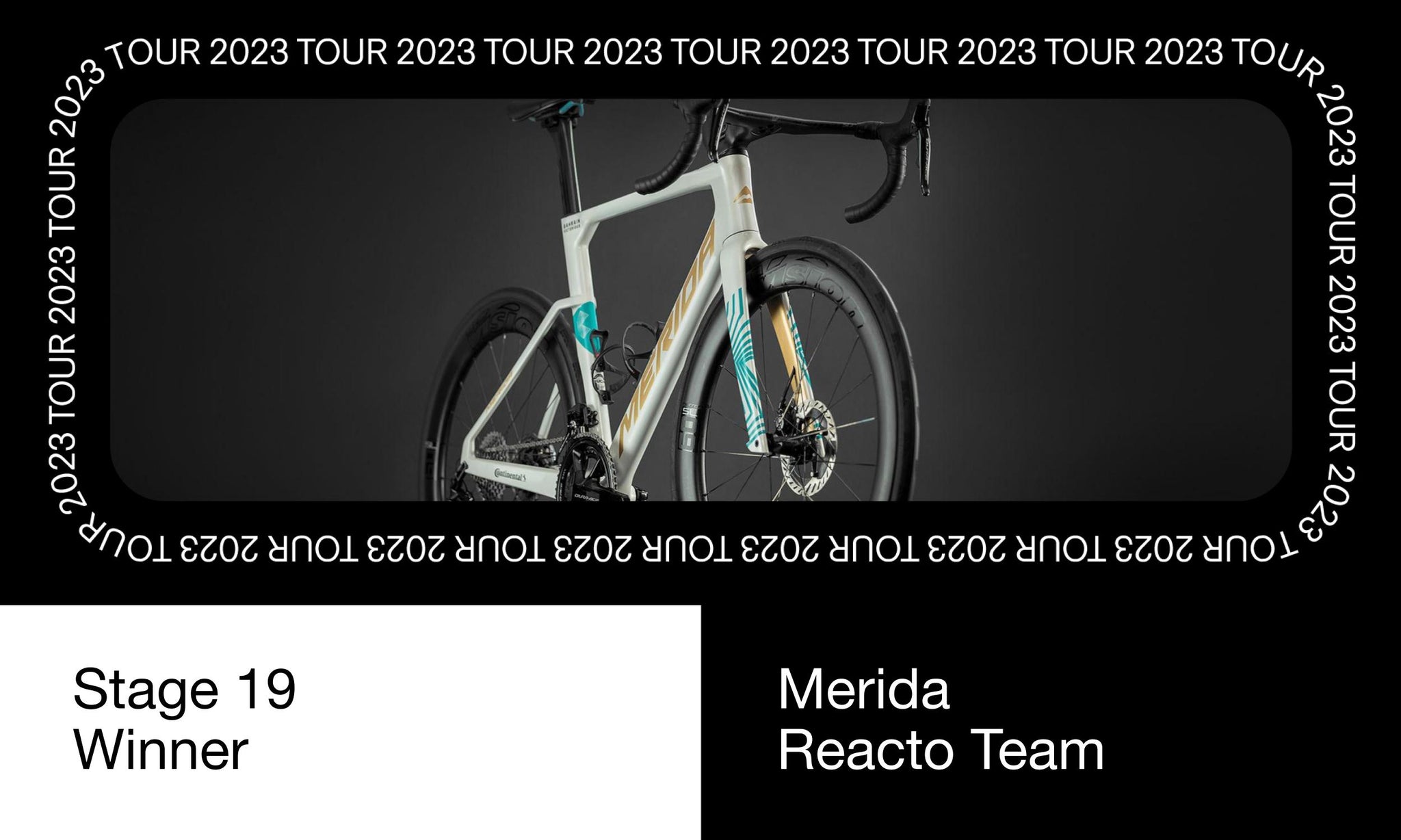
Stage 20 Winner - Belfort > Le Markstein Fellering

Rider: Tadej Pogacar Bike: Colnago V4Rs Drivetrain: Shimano Dura-Ace Di2 Wheels: ENVE SES 4.5 Tires: Continental Grand Prix 5000 S TR Bike Type: Aero/All-Rounder Stage Type: Mountain

The Tour de France overall was essentially decided on stage 17 when Jonas Vingegaard gained minutes on Tadej Pogacar on the final climb. In his post-race interview, Pogacar expressed a desire to win stage 20, the final mountain stage, a small but important consolation prize for his efforts this year. Of course, Pogacar being the animal that he is, delivered the win. It may not be the Tour finish he hoped for, but he and the UAE team were able to take 3 stages this year on their brand-new Colnago V4Rs. Despite winning the overall, Jumbo Visma and Cervelo had a much quieter Tour. Only the Cervelo P5 TT bike won a stage, while the S5 and R5 came up a bit short (though Wout van Aert came very close several times). The overall is the bigger prize though, so while Colnago won more battles, Cervelo won the war.
Stage 21 Winner - Saint-Quentin-en-Yvelines > Paris Champs Elysées

Jonas Vingegaard has wrapped up GC, so the final parade into Paris ends with one last chance for the sprinters on the famed Champs Elysées. The expected favorites — Jasper Philipsen, Dylan Groenewegen, and Mads Pedersen — were all there at the final sprint. But it was an amazing upset by Jordi Meeus (BORA - hansgrohe) who beat everyone to the line by mere centimeters. It is a great finish and a bit of redemption for Meeus, who struggled to make in impact in the early stages. It also gives the Specialized S-Works Tarmac SL7 its third win, putting it on terms with the Colnago V4Rs, and it also means that clincher tires were able to pip all the tubeless tires one last time.

Bikes, Features, Gravel, Latest Aug 16, 2024
Lynskey GR300: How Gravel Bikes Can Be Whatever You Want

Bikes, Features, Fun, Latest Aug 15, 2024
The Green Journey: Crossing the U.S. on Solar-Power Bikes

Bikes, Latest, Road, Tech Jul 22, 2024
The Stage-Winning Bikes from the 2024 Tour de France

Bikes, Features, Latest, MTB Jul 19, 2024
Our Specialized Epic EVO Race Bikes for the Leadville Trail 100 MTB

Bikes, Features, Guides, Inside, Latest Jul 12, 2024
Mid-Year Check-in: The Best-Selling Bikes of 2024 (So Far)

Bikes, Features, Fun, Latest, Road Jul 11, 2024
To Hell With Tradition: The Cannondale SuperSix EVO Tour de Future

Bikes, Features, Latest, Tech, Vintage Jul 1, 2024
Winning the Tour de France by 8 Seconds: Greg LeMond's 1989 Bottecchia TT Bike

Bikes, Features, Fun, Latest, Road Jun 27, 2024
My Cervelo Soloist a.k.a. How I'll "Win" My Weekly Lunch Ride

Bikes, Features, Latest, Road Jun 24, 2024
The Fat Chance Slim Chance Road Bike Keeps '90s Style Alive

Bikes, Features, Fun, Latest, Road Jun 14, 2024

Specialized Tarmac SL7 Marbled Lagoon: Beautiful? Or Too Much?

Bikes, Features, Fun, Latest, Road Jun 7, 2024
This Custom Mosaic RT-1 Is a Beautiful Mystery
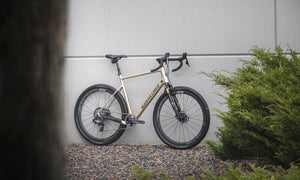
Bikes, Features, Gravel, Latest May 6, 2024
This Santa Cruz Stigmata + Fox 32 Taper-Cast Was Too Cool To Sell (As Is)
New arrivals.
Labor Day Deal

Certified Pre-Owned
Trek Remedy 9.8 Mountain Bike - 2019, X-Large

Trek Checkpoint SL 5 Gravel Bike - 2021, 54cm
$2,110.99 $2,599.99

Cervélo Áspero-5 Red XPLR eTap AXS 1 Gravel Bike - 2022, 48cm

Cervélo Caledonia-5 Ultegra Di2 Road Bike - 2022, 61cm
$4,548.99 $5,599.99

Revel Bikes Rail29 X01 Eagle Mountain Bike - 2023, X-Large

Lynskey R500 Road Bike - 2021, X-Large
$2,435.99 $2,999.99

Quintana Roo V-PR Dura-Ace Di2 Triathlon Bike - 2022, 50cm

Specialized S-Works Diverge Gravel Bike - 2021, 54cm
$5,603.99 $6,899.99

Orbea WILD FS M10 Mountain E-Bike - 2020, X-Large

Trek Émonda ALR Force AXS Road Bike - 2024, 58cm

Specialized S-Works Roubaix SRAM eTap Road Bike - 2018, 58cm
$3,492.99 $4,299.99

Ibis Ripmo AF GX Mountain Bike - 2021, X-Large
$1,745.99 $2,149.99
- MAGAZINE OFFERS
- BIKE INSURANCE
- Best Products
- Maintenance
- Accessories
- Long-Term Reviews
- First Look Friday
- Bike of the Week
- Tech Features
- Routes and Rides
- Bike Galleries
- BikeRadar Bargains
- Buyer's Guides
- Fitness & Training
- Sizing & Fit
- Mountain Biking UK
- Cycling Plus
- BikeRadar Podcast
Our 8 favourite Tour de France bikes | The coolest Tour bikes, according to BikeRadar
The BikeRadar team makes its nominations for the best bikes in Tour de France history
Tim de Waele/Getty Images
George Scott
The Tour de France is the pinnacle of the sport, not just for riders vying for the yellow jersey but manufacturers putting their wares in front of an audience of millions.
In fact, we love the Tour almost as much for its tech as we do for the exploits of riders on the road.
Here, the BikeRadar team shares its favourite Tour de France bikes from years gone by – machines that paved the way for future Tour tech or, quite simply, looked damn cool.
Our choices focus on the modern-ish era because that's where we've seen many of the innovations that characterise today's bikes (or they're bikes we have first-hand memories of).
What's your favourite Tour de France bike? Let us know in the comments at the bottom of the article.
Greg LeMond’s 1989 Bottecchia with aero bars
George scott | editor-in-chief.

To describe a tech moment as game-changing is perhaps a cliché but Greg Lemond’s equipment choices at the 1989 race undoubtedly started a new era for Tour de France tech.
LeMond’s decision to use aero bars – a first at the Tour de France – in the race’s two time trials not only brought aerodynamics to the fore in professional cycling, but effectively won him the race.
Having won the first time trial in the race, the American famously overturned Laurent Fignon’s 50-second advantage on the final stage – another race against the clock – to take the title by eight seconds.
LeMond rode a steel Bottecchia on the Champs-Élysées course, hunkered down on its U-shaped bar (except when sprinting out of the saddle) to cheat the wind and secure the second of three Tour de France wins.
While today's time trial bikes are a far cry from LeMond's Bottecchia, aerodynamics now influence almost every equipment choice in the pro peloton, from frames and components to clothing and helmets.
Chris Boardman’s 1994 Lotus 110
Simon bromley | technical writer.
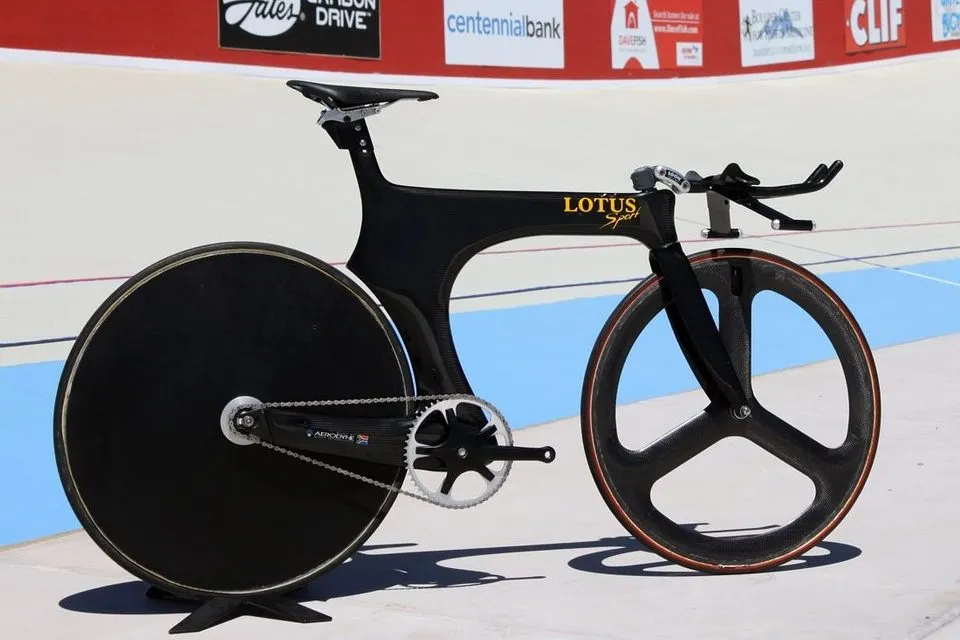
Perhaps the most iconic time trial bike in the history of road cycling, Chris Boardman’s Lotus 110 still has the power to wow.
A road version of Boardman’s famous Lotus 108 track bike, the 110’s carbon monocoque frameset was so advanced that you could drop it into today’s Tour and it would still look like something wild from the future.
The only issue would be that today’s chunky wheels and tyres wouldn’t fit in it.
Of course, part of what makes it so iconic – especially to us Brits – is that Boardman used it to take the yellow jersey by annihilating the field in the prologue time trial at the 1994 Tour de France.
Covering the 7.2km distance at a record average speed of 55.152kph (which stood until 2015), Boardman even caught his minute man, Luc Leblanc – who, deliciously, had previously belittled Boardman’s 1993 hour record.
A plethora of bold designs spawned in response to the efforts of Lotus, Boardman, Graeme Obree and the like, until the UCI introduced the Lugano Charter in 2000 and spoiled the party.
But, in this writer’s opinion, the Lotus 110 remains the most elegant and iconic bike of that era.
Miguel Indurain's 1995 Pinarello
Stan portus | digital writer.
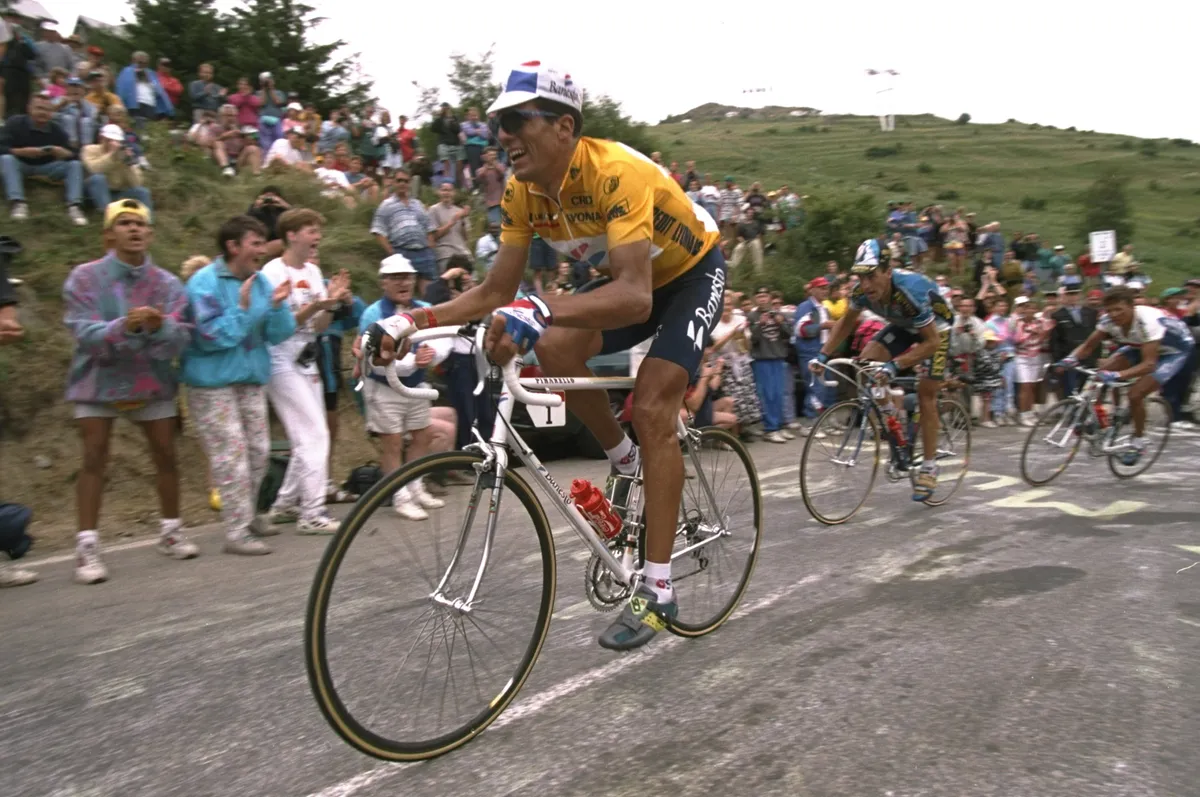
Many bikes that are considered cool can be classified as exceptions to a particular rule. They are often machines that break the status quo and mark the beginning of a new period of cycling tech, regardless of whether the bike itself actually sticks around.
Miguel Indurain’s 1995 Pinarello doesn’t follow this pattern. In fact, its coolness comes from the fact that it was the last of its kind: the final steel road bike to win the Tour de France.
Indurain dominated the world of professional cycling in the first half of the nineties, winning every edition of the Tour from 1991 to 1995.
While his style of riding – winning the time trials and defending the yellow jersey in the mountains – feels like a prelude to modern Grand Tour racing, his bike feels like the perfect coda to a period of cycling that we’ll never see again.
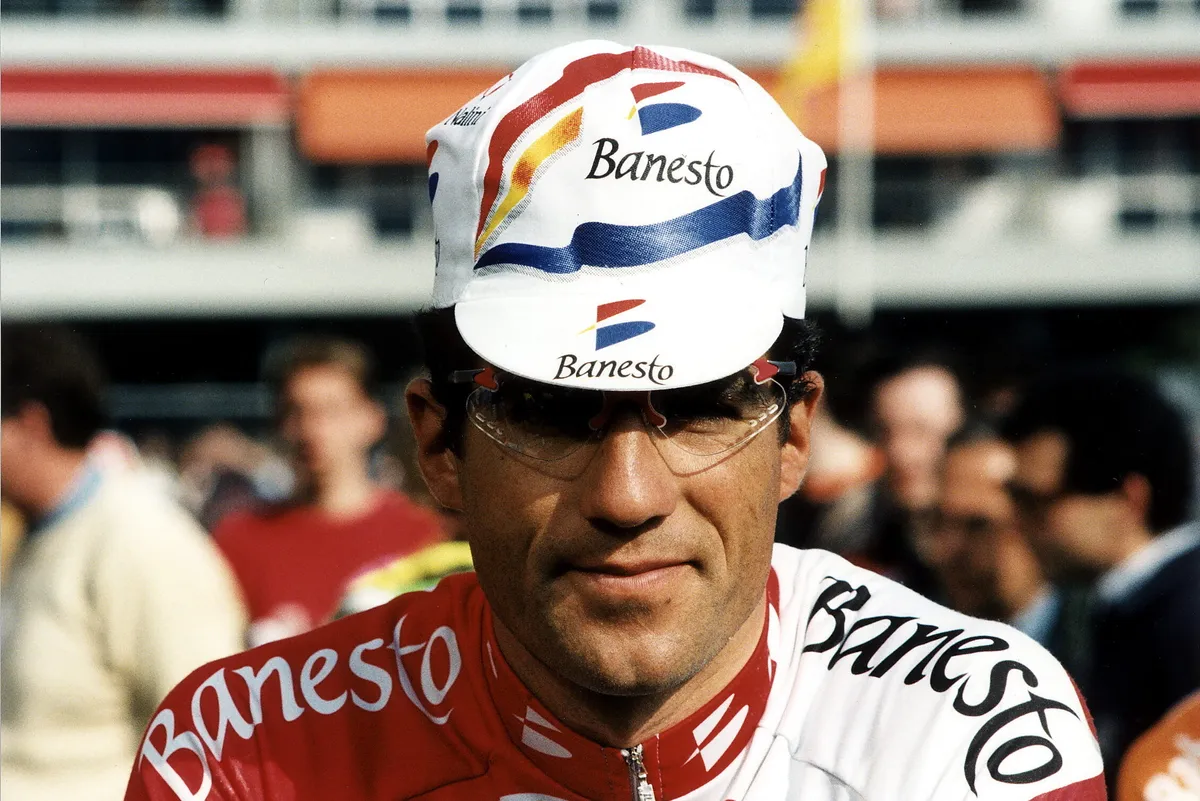
His Pinarello is claimed to have been custom-built by the legendary Dario Pegoretti in Italy, with a TIG-welded frame that matched Indurain’s tall stature.
Kitted out with a full Campagnolo groupset , Indurain typically ran 53-39 chainrings paired with an 11-23 cassette on the back – a gear ratio that, today, might inspire dread and admiration in equal measure.
When it comes to looks, Indurain’s bike had the Team Banesto colours running across the tubing in that classic '90s effect, a gradient.
The decade might be associated with garish colourways and louder than loud patterns, but Indurain’s bike is a fine example of how nineties styling could be playful yet refined.
There might be little carryover from Indurain’s bike to the pro bikes we see today (except maybe the integrated shifters), but if one thing could persist, in this writer’s eyes, it’s what we can learn from that paintwork.
Mario Cipollini’s 1999 Cannondale CAAD4
Warren rossiter | senior technical editor.

The Saeco-era Cannondales, with their bright tomato red livery and yellow graphics, were iconic in their own right, but for the '99 Tour Mario Cipollini had a custom white and gold edition, on which he set records with four back-to-back stage wins.
In anticipation of Cipo’s success, Cannondale even provided mitts with the company's logo emblazoned on the palm, so no one would forget what bike he was riding when Cipollini held his arms aloft.
The reason for the new colour? To celebrate Julius Caesar’s birthday (12 July) – Cipollini even dressed as the Roman emperor, replete with toga and a golden laurel wreath on his head, during the race and the team wore a limited-edition white and gold kit on stage nine.
The bike was Cannondale’s own blend of aluminium (based on 6061 T6) for the CAAD4 and it ran on Campagnolo’s 9-speed Record titanium groupset.
The Magic Motorcycle cranks (branded CODA) are the precursor to Cannondale’s superlight SiSL2 cranks of today, and Cipollini ran Stronglight chainrings in a big 53/42t pairing.
Upfront, there was a Cinelli Integralter one-piece bar and stem.

The Cannondale Saeco team used wheels from both Spinergy and Mavic at the time and, for this bike, Cipollini chose first-generation Mavic Cosmic Carbone tubulars.
Super Mario rode this bike for the first seven stages, winning four in the process (and posting the then-fastest ever Tour stage in the process) ahead of the individual time trial. Cipollini quit the race and headed for the beach when the mountains arrived on stage nine.
Aside from what was a stunning bike, I think this CAAD4 shows what the modern Tour has been missing: proper personalities, theatre to match the drama of racing and proper special-edition bikes for publicity and grabbing headlines.
Cipollini wasn’t just a masterful sprinter, he was the ultimate showman and this bike matched his showmanship.
Lance Armstrong’s original Trek Madone
Matthew loveridge | senior writer.
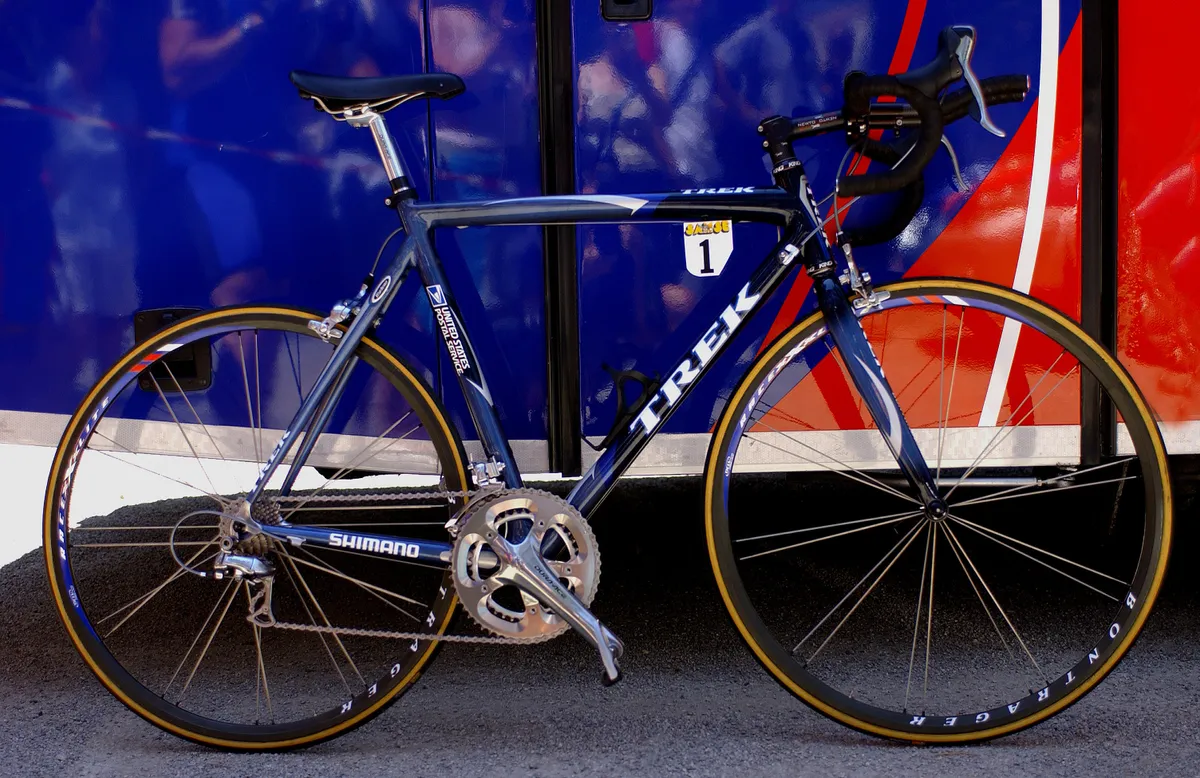
Following on from the Trek 5000-series that Lance Armstrong took his (heavily-asterisked) first Tour victories on, the Madone is arguably the most famous bike of the last two decades.
It'd be a stretch to call it my favourite Tour bike, but I don’t think there’s a machine that epitomises mid-2000s pro cycling better than a Trek in U.S. Postal Service colours.
The original Madone 5.9 debuted at the 2003 Tour and it was more of a refinement of its predecessor, the 5900, than an all-new bike.
It was named for the Col de la Madone in France – not a climb used in races, but rather one that Armstrong favoured to test his form.
Compared to today’s bikes, and even the more curvaceous second-gen Madone that followed, the OG bike is relatively traditional looking, with a horizontal top tube and external headset.

At the same time, it sported Bontrager carbon tubular wheels (albeit super-skinny, low-profile ones) and then brand-new Shimano Dura-Ace 7800 components.
The eagle-eyed will note that this isn’t actually Armstrong’s Tour bike, it’s one set up for a mountain time trial in the 2004 Critérium du Dauphiné, hence the aero bars.
If you look really closely, there’s also a weight-shaving down tube shifter for the front derailleur – a favourite Armstrong mod if you believe the lore.
For such a lightweight bike, it’s one with a lot of baggage…
Frank Schleck’s 2006 Cervélo Soloist SL-C SL
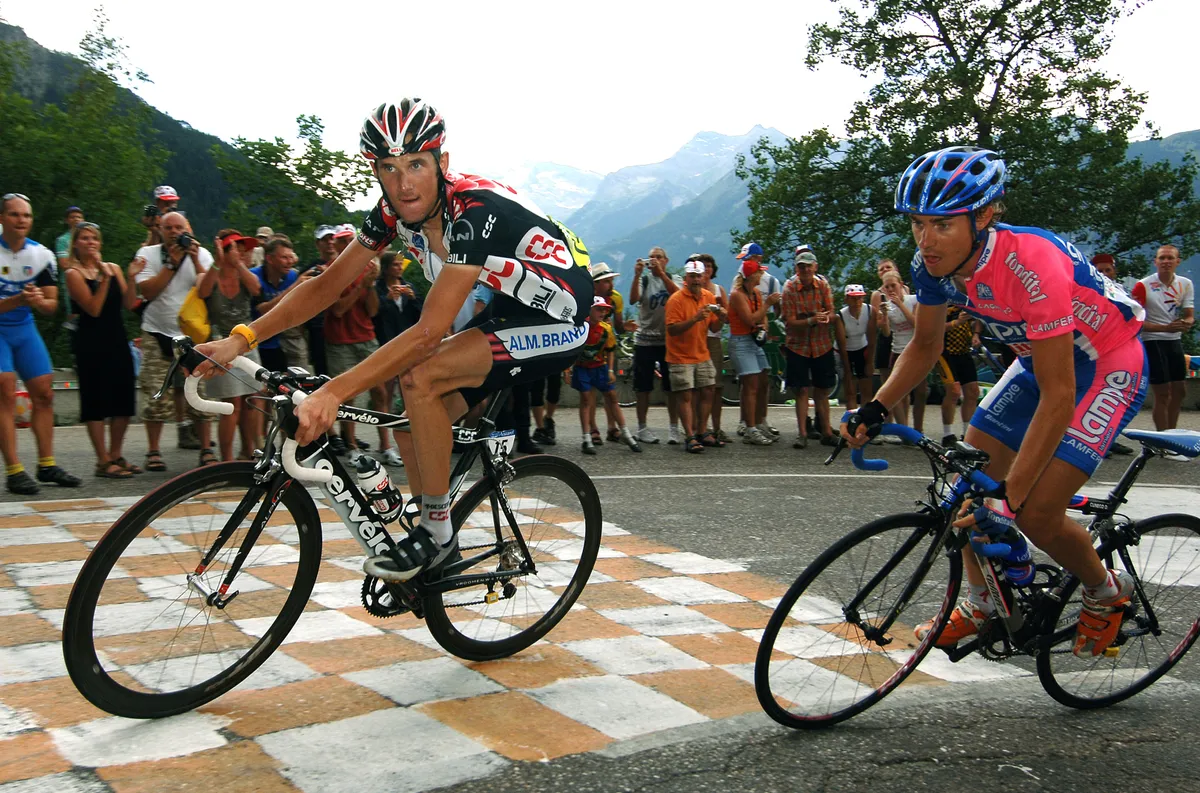
Okay, I'm cheating here with two entries but Cervélo basically invented the aero-road bike so, as well as Mario Cipollini's Cannondale CAAD4, I'm nominating Frank Schleck's 2006 Soloist SL-C SL.
Sure, brands like Cinelli had the Laser much earlier but that was aero-styled rather than scientifically engineered to be aerodynamic.
In the aluminium era, aero tubes were more like round tubes ‘squashed’ into an aero shape. Cervélo, with the original Soloist, used NACA profiles to define the shape, and when it came to carbon, the Canadian brand adapted the Soloist design brilliantly.
By the time Team CSC and Frank Schleck got to ride the SL-C SL, Cervélo had managed to extract more than 200g from the standard SL-C (when we tested the frame back in 2007 it weighed a still-impressive 994g in a 58cm).
That made it not only the most aerodynamic bike in the 2006 Tour, but also one of the lightest (it tipped the scales at 6.9kg complete, just 100g over the UCI limit).
On stage 15, Schleck and his Soloist went head-to-head with Danielo Cunego through the 21 hairpins of Alpe d'Huez. When Schleck attacked 3km from the finish I’d like to think that the added aero of the Soloist gave him the edge, especially when he could have chosen the lighter Cervélo R3 for the mountain stages.
The Team CSC bikes used Shimano Dura-Ace with FSA K-Force chainsets, along with FSA bars and stems, Zipp aero wheels and True Temper’s Alpha Q fork. Remember when bikes used forks that weren’t specific to the frame?
Vincenzo Nibali’s 2016 S-Works Tarmac
Jack luke | deputy editor.
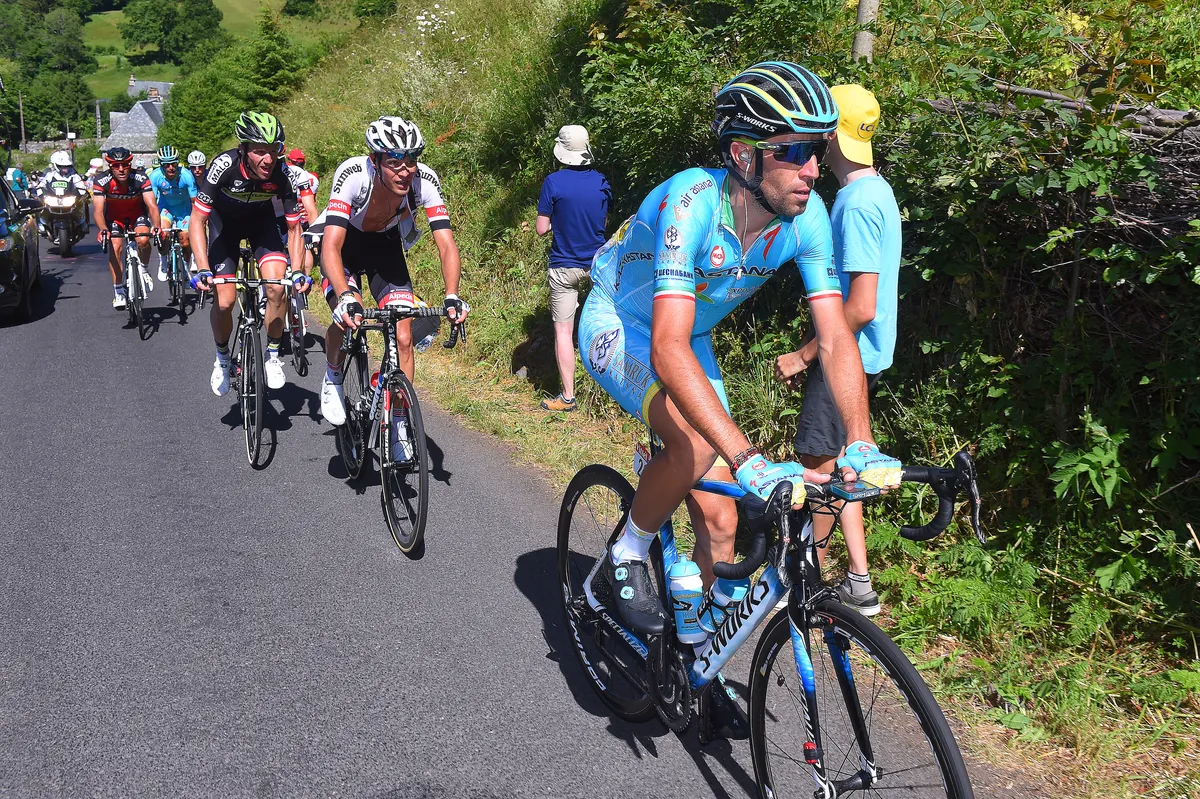
In a time dominated by dropped seatstays, aero-formed everything and total integration, I find myself bored senseless by the homogeneity of modern road bike design.
That last point is probably the key culprit for the remarkable sameness of pro bikes these days – in-house brands and proprietary components tie riders and teams to a very narrow selection of components, leaving little room for quirky customisation (though that seems to be changing , particularly in regards to wheels).
Seemingly hodge-podge builds largely died off with the end of the traditional triple triangle era and, as a professional bicycle tech nerd, I mourn the loss of this time.
For me, the Specialized Tarmac SL5 defines the latter part of that era and, in particular, I fondly remember Vincenzo Nibali’s 2016 Tour de France bike .
A full gallery of this bike was published just before I started working at BikeRadar – a time when I was studiously reading everything published on the site, earning it a special place in my heart.
With a mad kinda-naff-kinda-cool paint job, a full Campagnolo Super Record (mechanical!) 11-speed groupset, Corima S+ wheels and dreadful custom-painted FSA finishing kit, the bike is totally unlike anything we would see today, and just a few years later.
RIP, weird bikes of the Tour de France.
Marianne Vos’s 2019 Liv Langma Advanced SL
Helen cousins | operations manager.
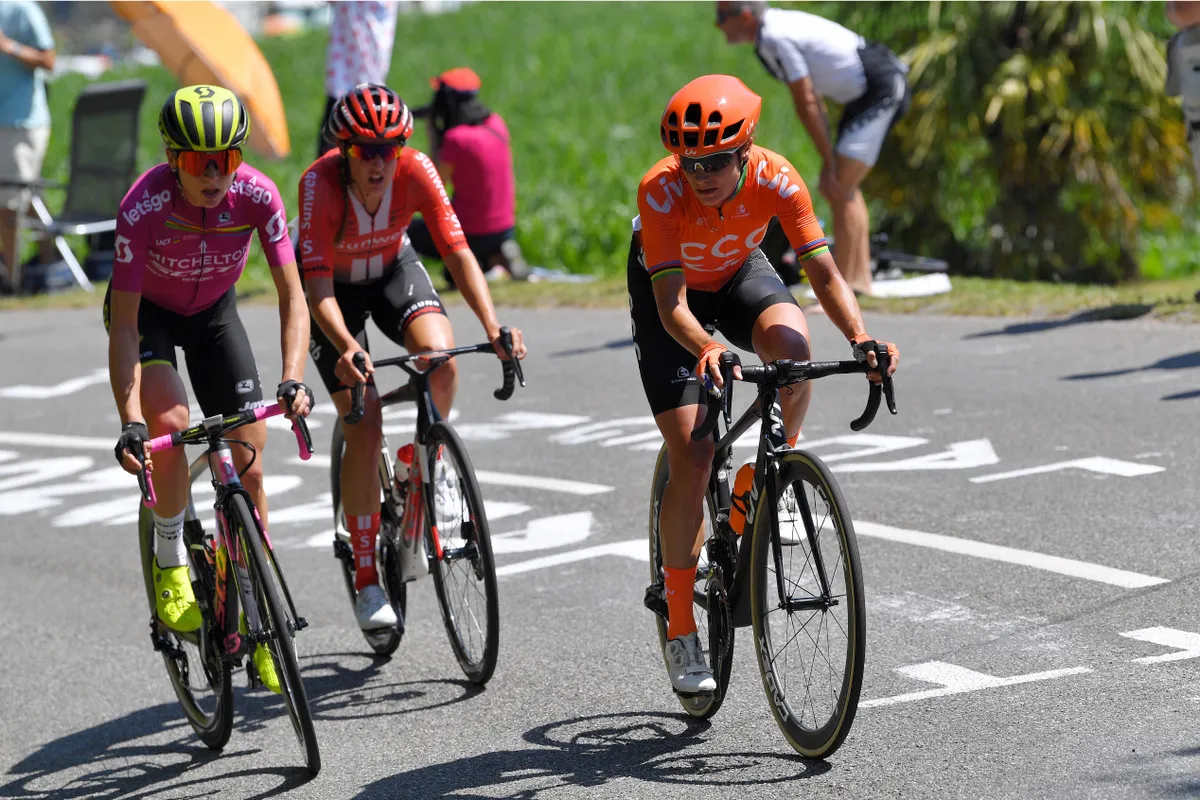
As a two-time winner of La Course, in 2014 and 2019, and undeniable GOAT of the sport, my pick would be Marianne Vos’s 2019 winning Liv Langma Advanced SL. At the time, it was Giant and Liv’s lightest frameset, making it a good option for the rather hilly La Course route that year, rather than the team’s aero EnviLiv Advanced option.
Starting and finishing in Pau, the five-lap 121km course featured four climbs of la Côte de Gelos and then finished on a steep 17 per cent ramp inside the final 500m.
Vos's Team CCC-Liv bike was built around SRAM’s RED AXS 12-speed wireless rim brake groupset, and this was the last season Vos raced on rim brakes, switching to discs for the 2020 season onwards.
Her bike also featured some lightweight Cadex wheels, which looked to be a Vos-only spec choice for the race, with the rest of the team riding Giant branded wheelsets.
A classic looking bike and one that's still impressing us; now with disc brakes, we recently scored the Liv Langma Advanced SL Disc 4.5 stars out of 5.
Share this article

Editor-in-Chief

- Terms & Conditions
- Subscribe to our magazines
- Manage preferences
- off.road.cc
- Dealclincher
- Fantasy Cycling
Support road.cc
Like this site? Help us to make it better.
- Sportive and endurance bikes
- Gravel and adventure bikes
- Urban and hybrid bikes
- Touring bikes
- Cyclocross bikes
- Electric bikes
- Folding bikes
- Fixed & singlespeed bikes
- Children's bikes
- Time trial bikes
- Accessories - misc
- Computer mounts
- Bike bags & cases
- Bottle cages
- Child seats
- Lights - front
- Lights - rear
- Lights - sets
- Pumps & CO2 inflators
- Puncture kits
- Reflectives
- Smart watches
- Stands and racks
- Arm & leg warmers
- Base layers
- Gloves - full finger
- Gloves - mitts
- Jerseys - casual
- Jerseys - long sleeve
- Jerseys - short sleeve
- Shorts & 3/4s
- Tights & longs
- Bar tape & grips
- Bottom brackets
- Brake & gear cables
- Brake & STI levers
- Brake pads & spares
- Cassettes & freewheels
- Chainsets & chainrings
- Derailleurs - front
- Derailleurs - rear
- Gear levers & shifters
- Handlebars & extensions
- Inner tubes
- Quick releases & skewers
- Energy & recovery bars
- Energy & recovery drinks
- Energy & recovery gels
- Heart rate monitors
- Hydration products
- Hydration systems
- Indoor trainers
- Power measurement
- Skincare & embrocation
- Training - misc
- Cleaning products
- Lubrication
- Tools - multitools
- Tools - Portable
- Tools - workshop
- Books, Maps & DVDs
- Camping and outdoor equipment
- Gifts & misc
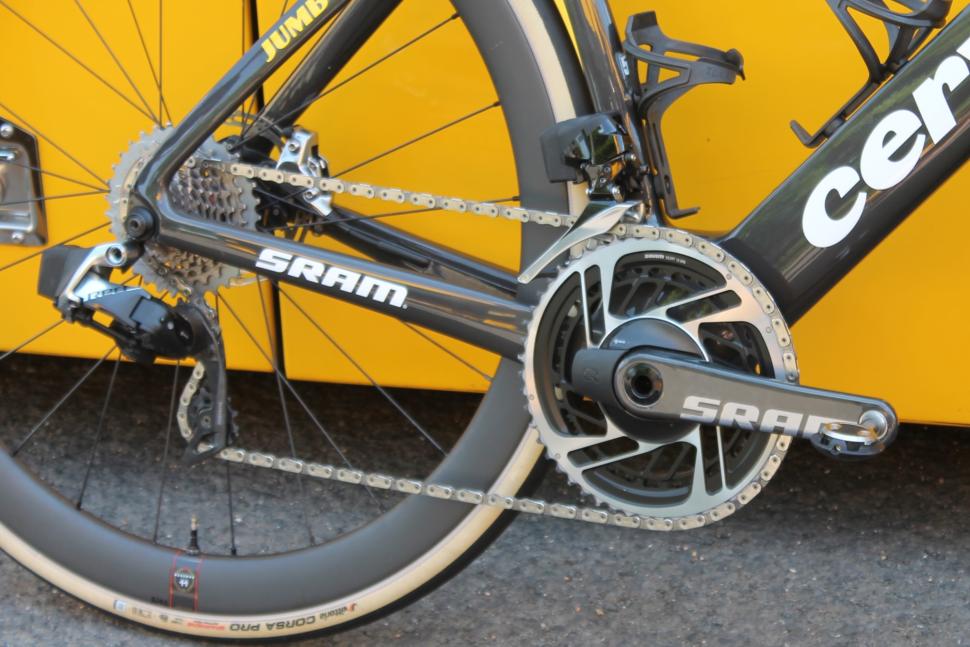
All the gear? Check out the gearing choices of the pros at the Tour de France
First Published Jul 5, 2023
Gearing choice in the Tour used to be easy, a standard chainset was the only way to go and cassette choices were limited at best. However, these days, with 12-speed options from Shimano, SRAM and Campagnolo all represented in the peloton, there's more choice than ever. We've had a nosey at the pros' bikes to see what they're using this year.
> Suffering on the hills? Find out how to get lower gears to make climbing easier
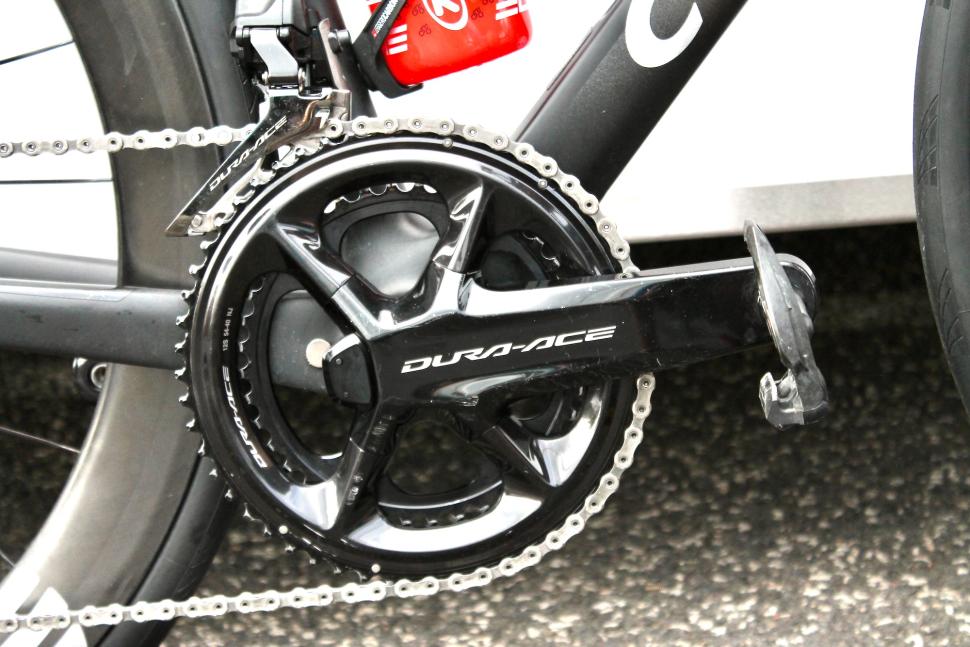
The peloton's gearing choices differ from many consumer bikes simply because the riders race at very high speeds and therefore need bigger gears to keep a comfortable cadence. Whereas most bikes you can buy come specced with 50/34t compact or 52/36t chainset, (or 48/35t and 46/33t on SRAM 12-speed groupsets paired with 10-tooth start cassettes) you'll typically find the peloton powering along on chainsets with larger chainrings.
Check out this article for a primer on the basics of gears and all the lingo
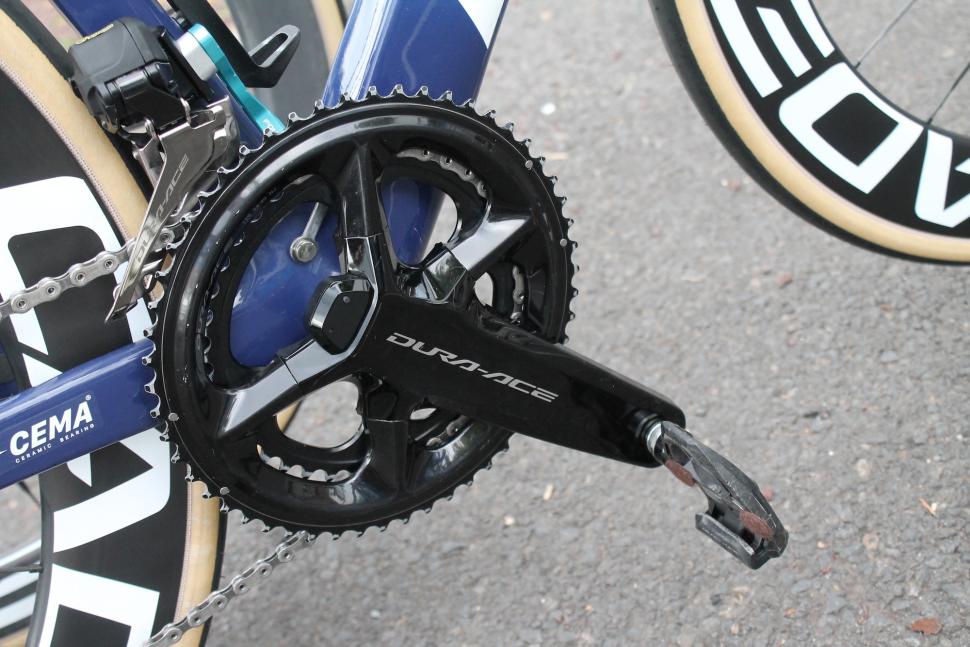
The most common chainset size in the pro peloton on normal stages is 54/40t. That's a standard Shimano Dura-Ace option, and most teams racing in the Tour de France use this groupset. This is the chainset from Dylan Groenewegen's Giant Propel (above), for example.
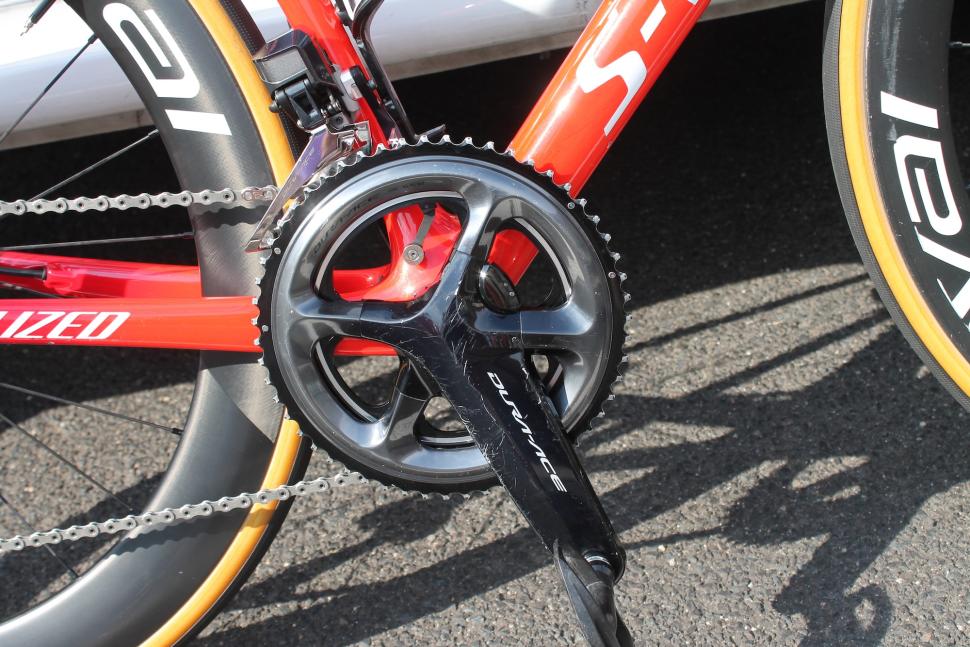
There are plenty of other choices, though. We spotted Edvald Boasson Hagen of Team TotalEnergies using this 55/42t chainset (above) which comes from the days when Shimano Dura-Ace was an 11-speed system.
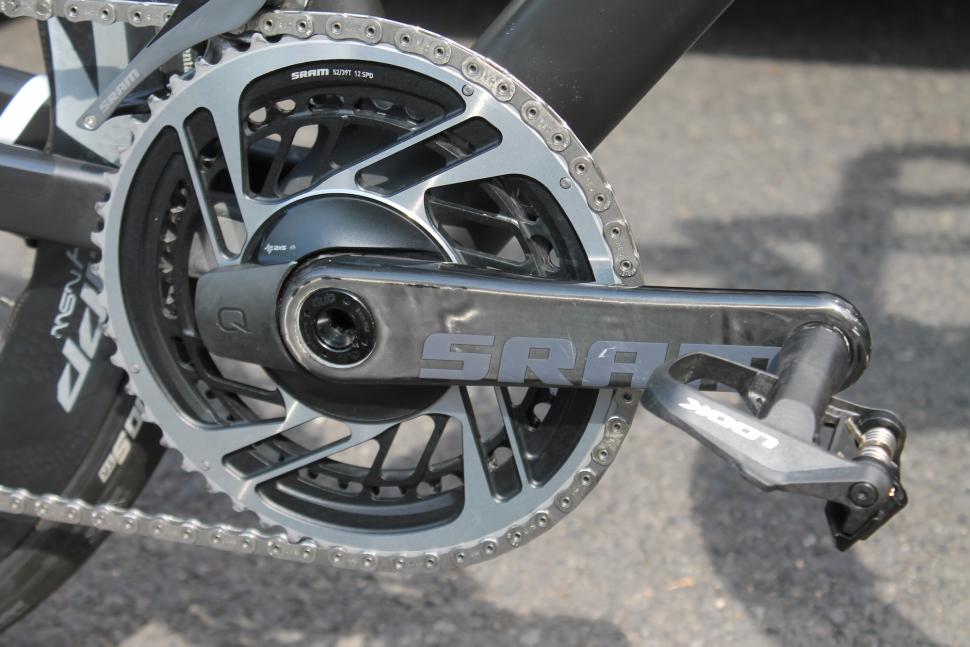
Enric Mas, who had to withdraw from this year's Tour after sustaining an injury during the first stage, was using a 52/39t SRAM chainset (above).
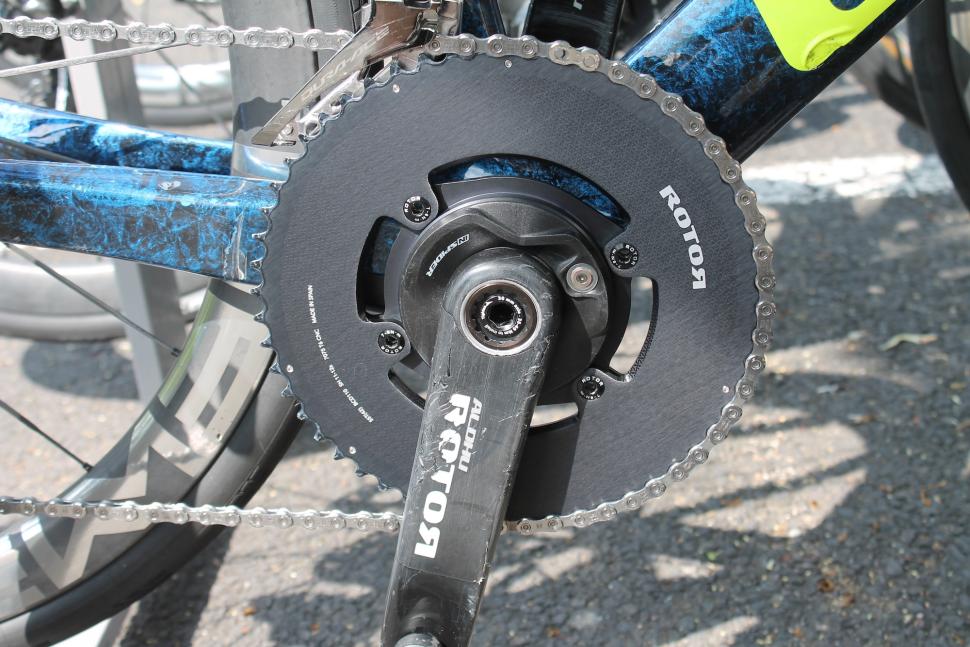
Intermarché - Circus - Wanty's Georg Zimmermann uses this 55/42T Rotor setup on his Cube Litening Aero.
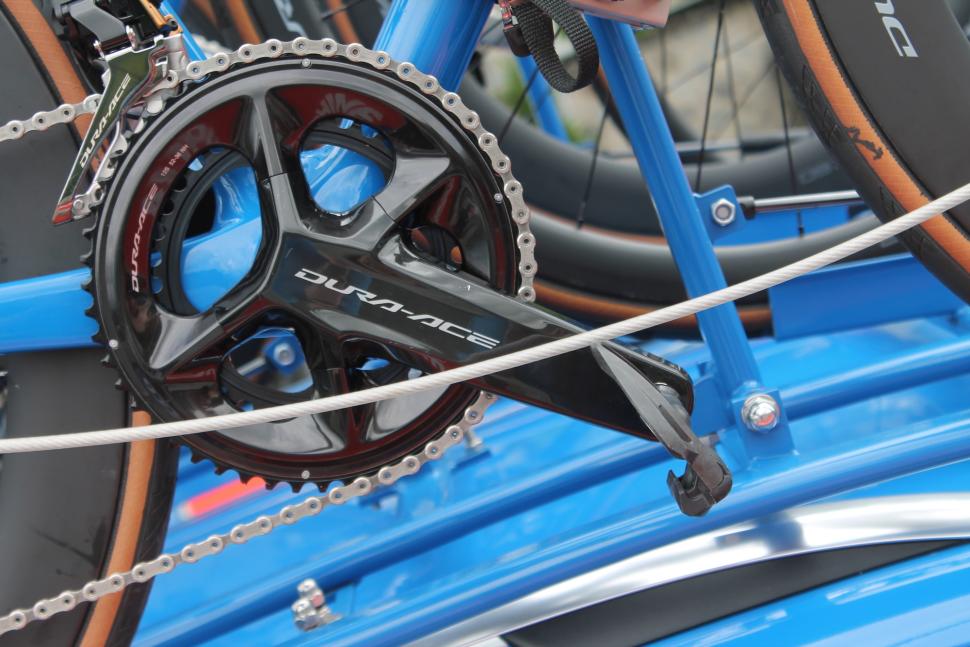
The Shimano neutral service bikes are fitted with 52/36T chainsets that give a broad spread of gear options for any rider who is unfortunate enough to require one.
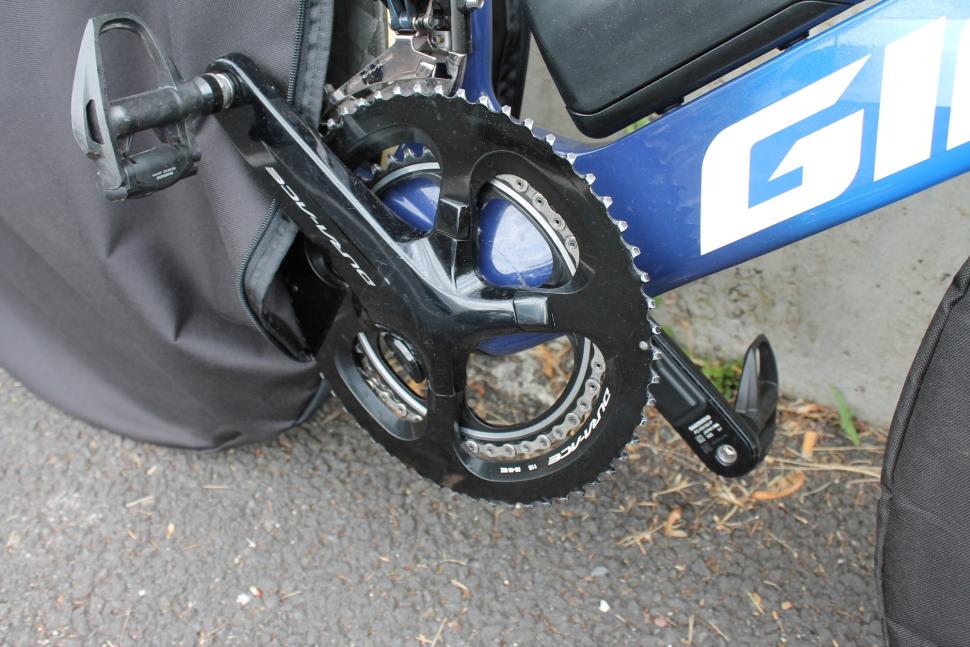
You'll find larger chainrings during the time-trial stages when riders are consistently moving at high speeds. For example, this (above) is Luke Durbridge's TT bike with 58/46t chainrings fitted.
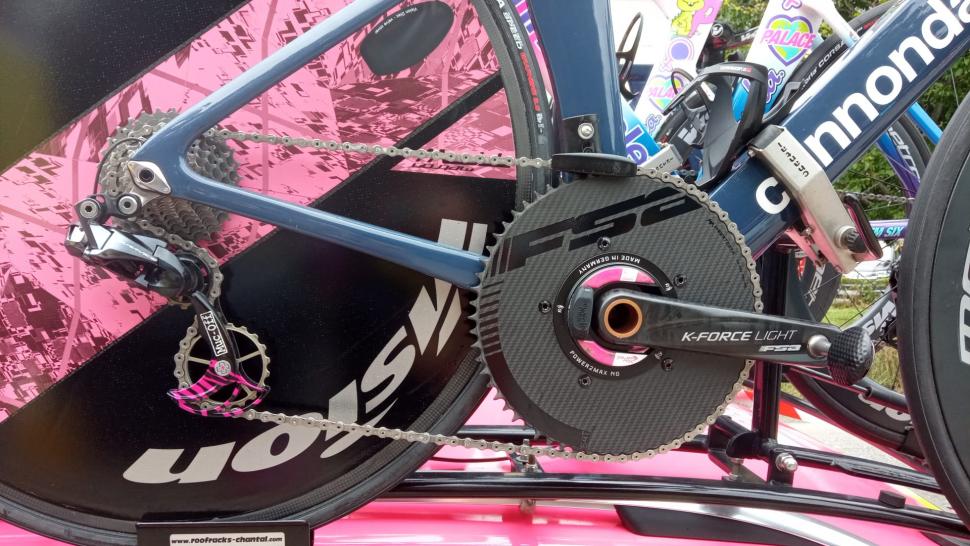
During last year's Tour de France, Stefan Bissegger was spotted using this 64 tooth chainring that is not available to the public.
Cassettes have varied much more over the years, largely as a consequence of the steady increase in gears, from the old days of 5-speed and 6-speed to the 12-speed setups that are currently used in the pro peloton.
As the number of gears has increased, so too has the range, with larger cassettes increasingly common, partly as a response to race routes that are getting ever harder as race organisers attempt to find even more cruelly savage mountains to send racers up.
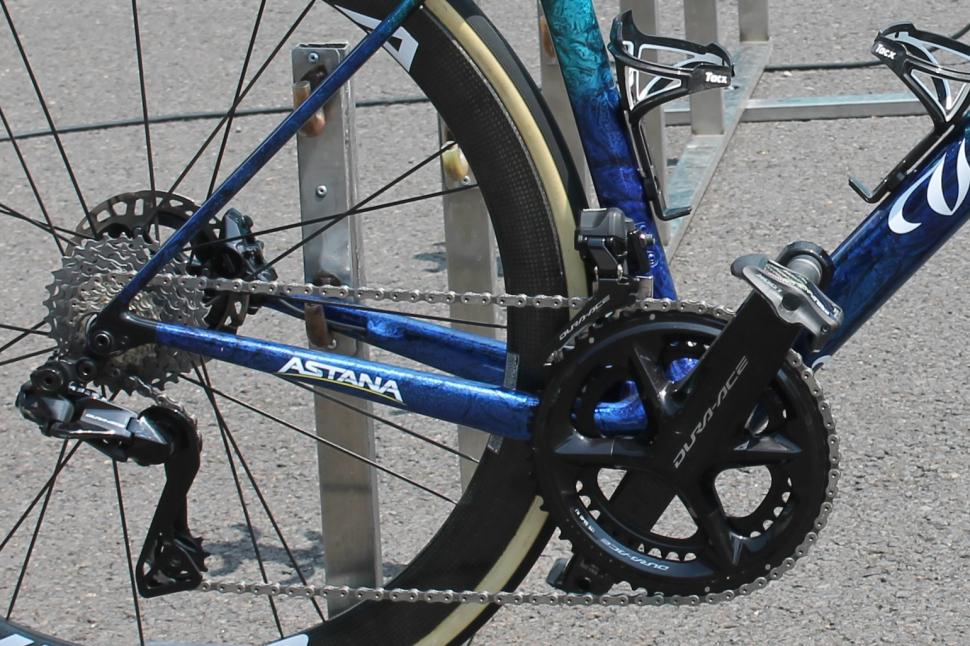
The increase in the number of gears also means that riders can cover those larger ranges with smaller jumps between sprocket sizes. This helps them keep a more even cadence as they move across the cassette.
When we visited the Critérium du Dauphiné recently, loads of pro bikes were fiitted with 11-30t and 11-32t cassettes. These are positively humongous compared with a few decades ago when you'd get an 11-21t cassette and, if you were lucky, 11-23t for the mountains.
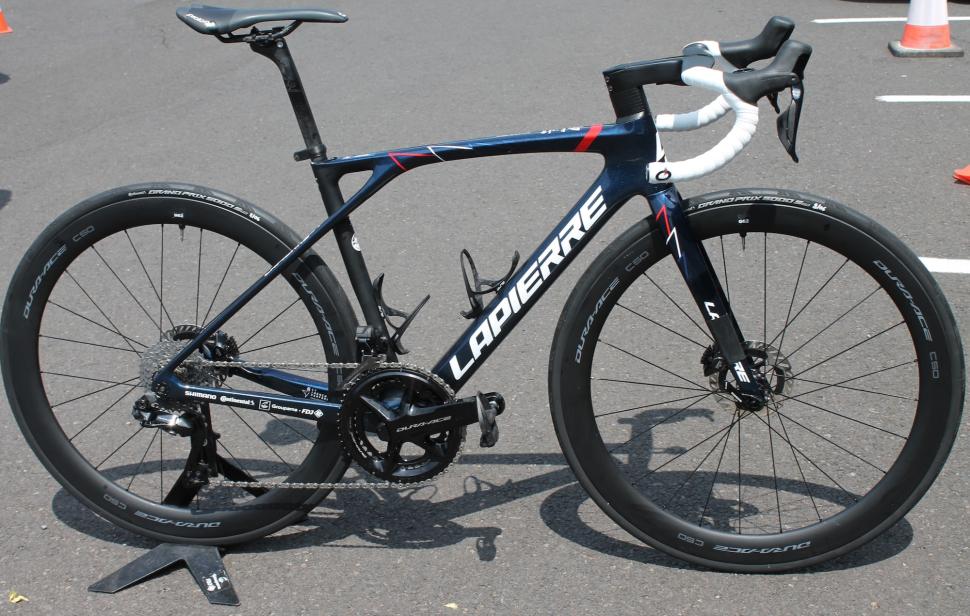
We saw quite a lot of 11-34t cassettes too, and that surprised us. David Gaudu's Lapierre Xelius SL (above), for example, was fitted with a 54/40t chainset and an 11-34t cassette. With a 40t inner chainring now more common than a 39t, it looks like more riders want a larger cassette to compensate on hillier roads.
Campagnolo has just updated its Super Record EPS groupset and now the cassettes come with a 10t smallest sprocket. The standard options are 10-25t, 10-27t and 10-29t.
> Campagnolo ditches iconic thumb shifter and goes wireless with new Super Record Wireless electronic groupset... and it'll cost you £4.5k
The largest sprockets on those cassettes might seem pretty small but at the same time Campagnolo has altered the size of its chainsets to compensate. They're available in 50/34t, 48/32t and 45x29t options.
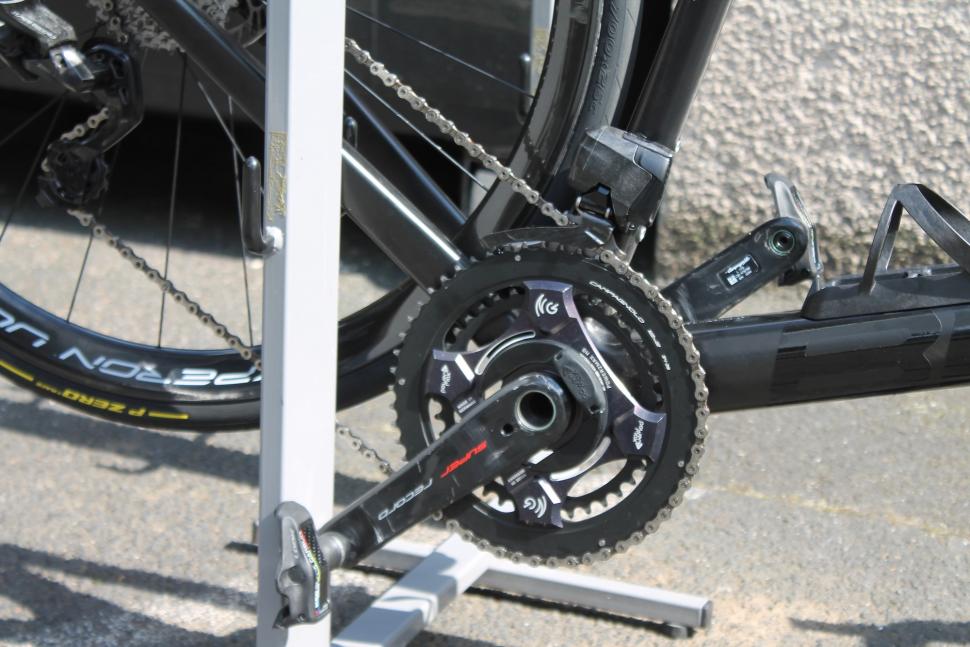
That said, we saw Ben O'Connor's BMC Teammachine (above) at the Dauphine fitted with new Campagnolo Super Record EPS shifters and derailleurs, with a 54/39t chainset and a larger cassette than any of those listed above.
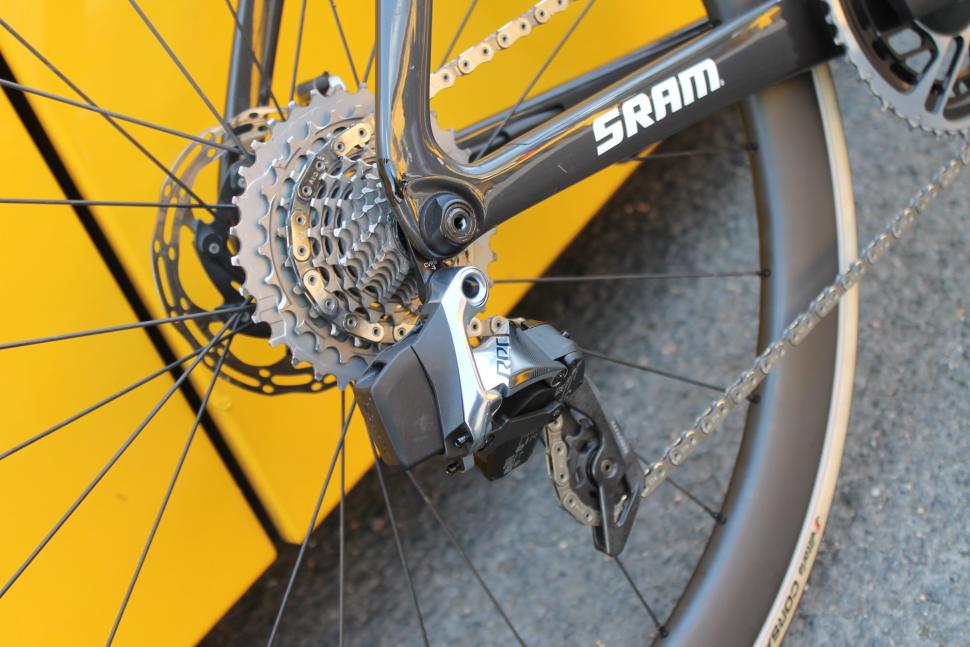
SRAM offers a 10-33t cassette for Red eTap AXS, and that's what we saw fitted to one of Jonas Vingegaard's bikes ahead of the Dauphiné, matched to a 52/39t chainset.
> Which chainset is right for you?
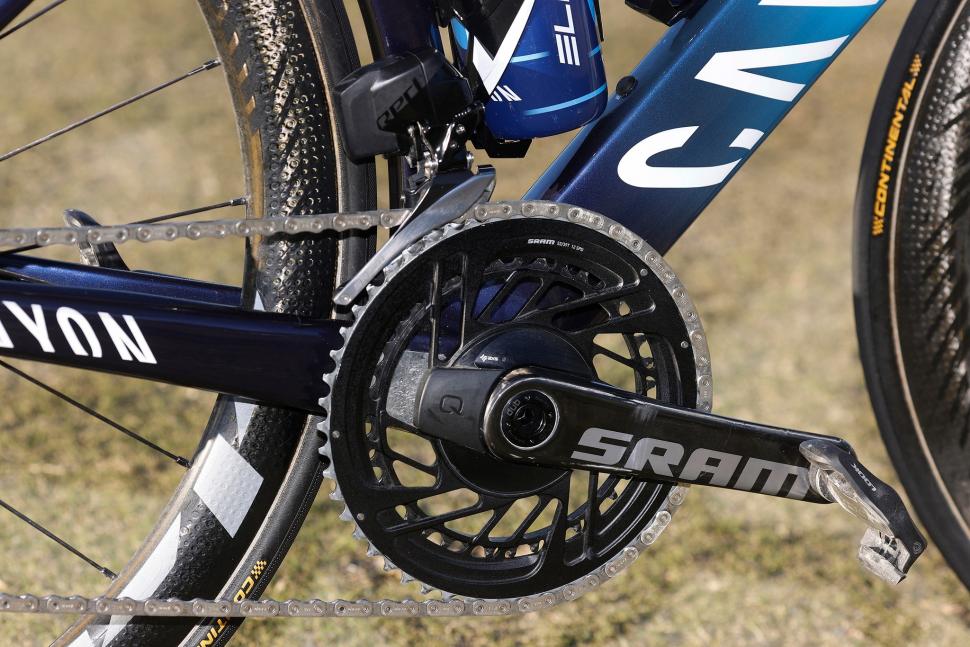
The use of that 10t sprocket means that SRAM chainsets don't need to be as large as Shimano's to achieve the same gear ratios (Shimano's smallest cog is 11t). However, as well as the 52/39t chainset Vingegaard was using, SRAM now offers 54/41t and 56/43t options.
What about 1x?
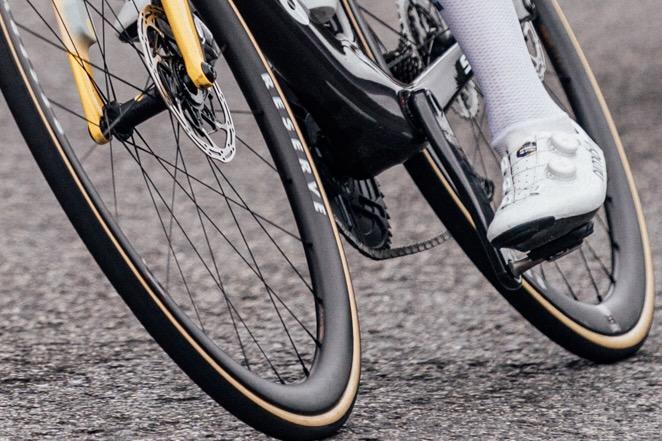
Pic: © Zac WiLLIAMS SWpix.com (t-a Photography Hub Ltd)
Jumbo-Visma switched from Shimano to SRAM for this season and we first saw Vingegaard experimenting with 1x at the Dauphiné.
> Jonas Vingegaard uses 1x gearing for Tour de France opening stages
A few riders have dabbled with 1x, with varying levels of success, and of course, there was the ill-fated Aqua Sport Blue team which solely used 1x drivetrains on 3T Strada bikes. The team boss at the time was quite scathing about either the drivetrain or the bike, or perhaps both.
There are benefits to a 1x system. There’s no duplication of gears – which is something you get with 2x groupsets – it can be lighter and more aerodynamic, and the lack of a front derailleur means there's one less component to fail.
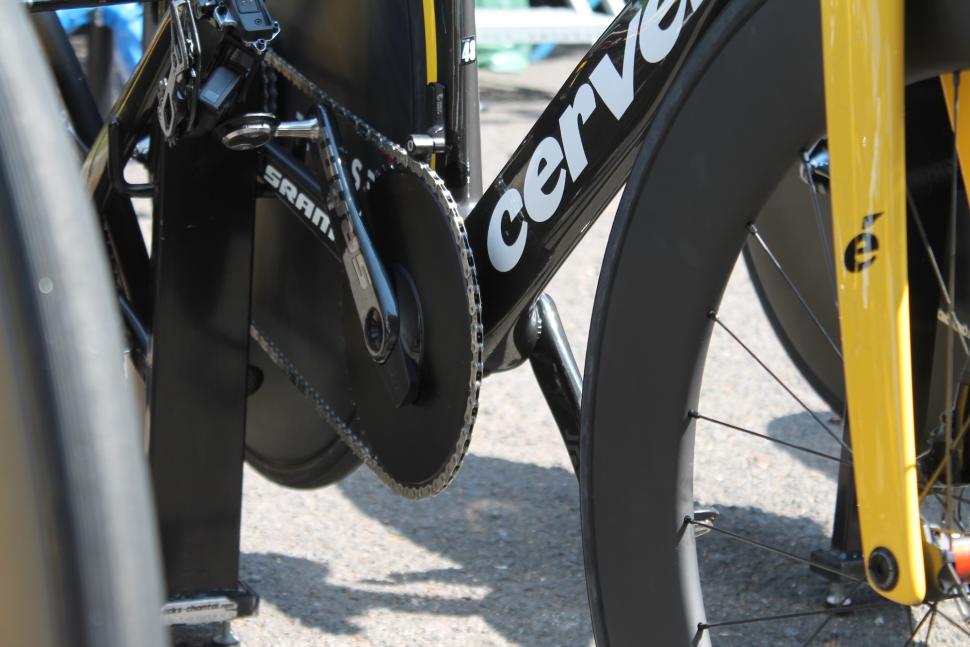
Jumbo-Visma uses single chainring setups on its time trial bikes (above) when it doesn't need a huge spread of gears.
However, Vingegaard and Van Aert have also used 1x for normal road stages with a Wolf Tooth LoneWolf Aero chainguide fitted to help keep the chain in place.
It's not as if Jumbo-Visma has chosen to give 1x a go just for flat courses; the first two stages of this year's Tour were pretty hilly. It'll be interesting to see if the team sticks with the tech throughout the race and, if not, the circumstances in which it turns to 1x.
SRAM insists that Jumbo-Visma's use of 1x isn't a marketing exercise, by the way. It's down to the team and the individual riders which of SRAM's components they decide to use.
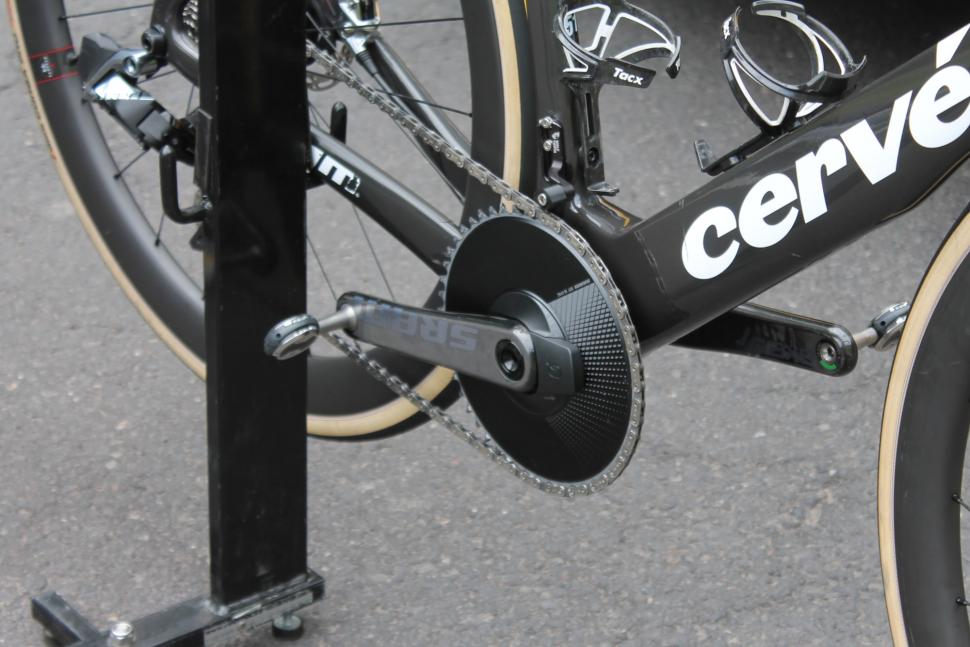
One issue with 1x is that you can still get some fairly sizeable jumps between the gears. A possible solution to this is the Classified system which basically moves the function of the front mech into the rear hub.
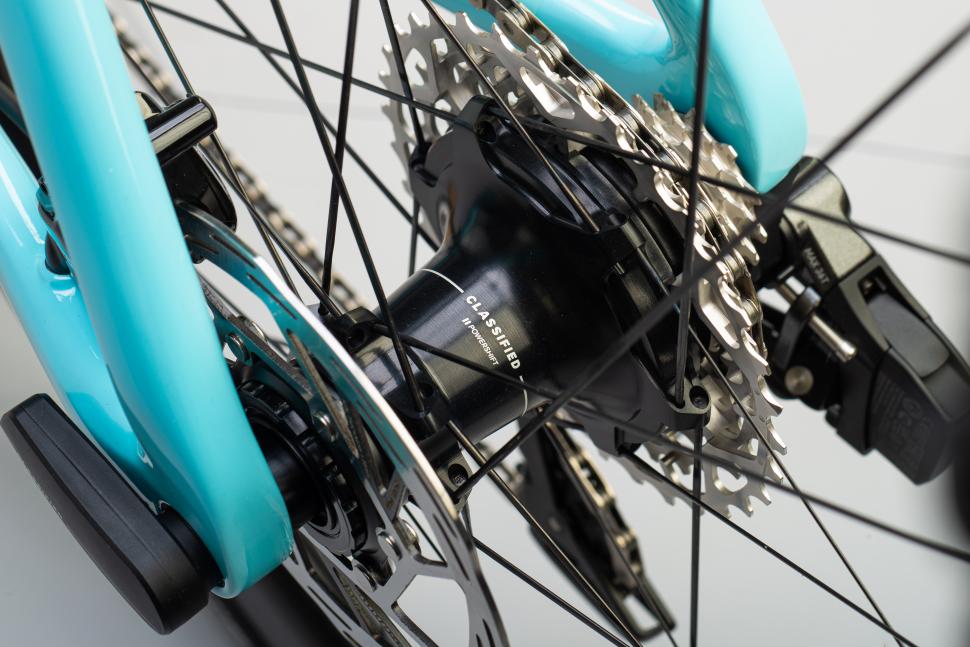
Classified's tech could also bring aero benefits and it has been used by a few teams. Uno X has tried it out in competition, for example, and Lotto-Dstny's Victor Campenaerts rode this year's Omloop Het Nieuwsblad with a Classified system on his bike.
The system raises some questions about wheel changes but could it be something we see in the Tour de France in the future?
> Check out Classified's innovative Powershift drivetrain
What about the rest of us?
Today’s pro road racers are provided with equipment vastly superior to 10-20 years ago, but it’s the range of gears that has been the most interesting trend as the groupsets have evolved. As the number of sprockets has increased, the gear range has increased. Are riders getting soft, are courses getting harder, or is the higher number of gears making it possible?
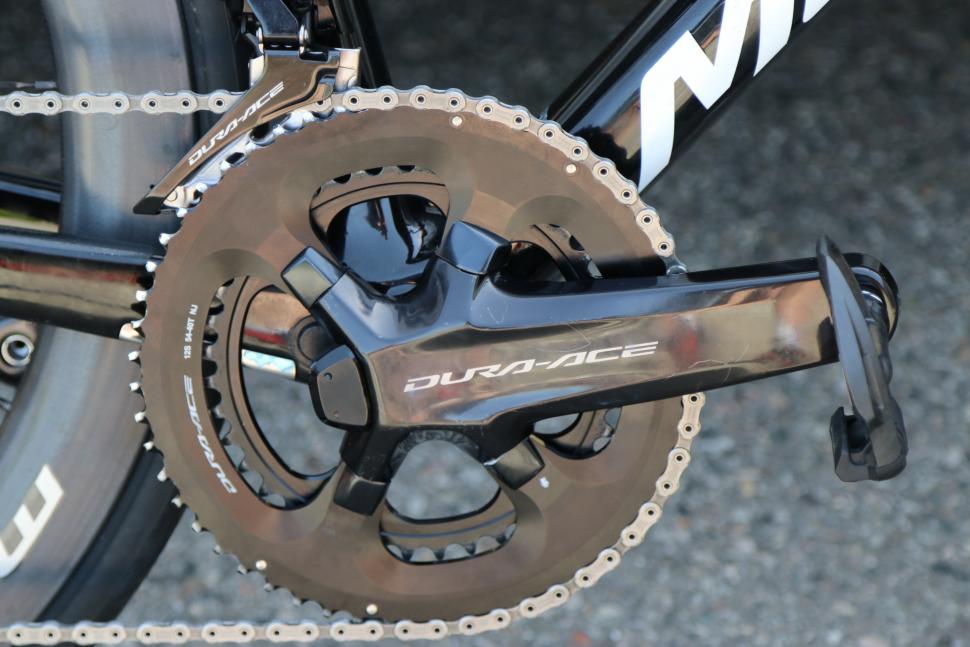
The three big groupset manufacturers are still focused on the needs of the pro racers and delivering groupsets to meet their needs, and then selling them to the public, but there just aren’t many normal people that need a 54-11 gear. The requirements of the pros are very different to people like you and me.
This is slowly changing though. Outside of the pro peloton, we're starting to see a shift in focus from the equipent manufacturers to meet the growing diversity of modern cyclists that are less influenced by pro racers and more by their riding, whether long-distance road rides or adventure and gravel bikepacking.
Largely thanks to adventure riding, we're now seeing much wider range groupsets with more realistically usable gear ratios for the many people that don't go racing every Sunday, but want gears to help them out on challenging terrain and let them conquer every hill.
Help us to fund our site
We’ve noticed you’re using an ad blocker. If you like road.cc, but you don’t like ads, please consider subscribing to the site to support us directly. As a subscriber you can read road.cc ad-free, from as little as £1.99.
If you don’t want to subscribe, please turn your ad blocker off. The revenue from adverts helps to fund our site.
Help us to bring you the best cycling content
If you’ve enjoyed this article, then please consider subscribing to road.cc from as little as £1.99. Our mission is to bring you all the news that’s relevant to you as a cyclist, independent reviews, impartial buying advice and more. Your subscription will help us to do more.
Jamie has been riding bikes since a tender age but really caught the bug for racing and reviewing whilst studying towards a master's in Mechanical engineering at Swansea University. Having graduated, he decided he really quite liked working with bikes and is now a full-time addition to the road.cc team. When not writing about tech news or working on the Youtube channel, you can still find him racing local crits trying to cling on to his cat 2 licence...and missing every break going...
Add new comment
23 comments.
No one other than a professional racing cyclist or an amateur of the very highest level needs an 11 tooth or even a 12 tooth sprocket, unless their big chainring is a 44 rather than a 50 or 52.
People tell themselves that they do because they want to pedal really fast down hill. But it's likely that their pedalling at the low wattages of ordinary cyclists merely increases their drag from the air, downhill; so they go slower than they would if they stopped pedalling, tucked in their knees to the frame and crouched in an elbows-in aero position.
As to the idea that a double or triple chainring giving duplicated gear ratios is somehow a disadvantage .... this too is an unthinking analysis.
The point of a double or triple chainring is to provide, from the same cassette, two or three gear ranges that are close enough to enable the rider to find the ideal cadence, whether for generally slowish ascents, mid-speed undulations or flats agin' the wind, or fast riding when the road is smooth & flat with the wind behind. It isn't to provide more gears but rather to provide better gear ranges for different terrains/speed ranges.
But our culture encourages sales of high end racey bike parts by seeming to promise the buyer of high-geared stuff that they too can be just as fast as them riders in the TdF by having a Dura-Ace 53/39 chainset and an 11-25 cassette. This is just a-one o' them daft "dreams" they install in the heads of folk far too blase about having their wallets emptied whilst paying no attention to the reality of their actual cycling abilities.
The annoying part for those wanting more realistic gears is that it's often very hard to find them. Because road bike frames tend to come with front braze-on fitting to suit chainrings from 48 - 56, rather than 44 - 50, you'r stuck with a 48 or (more probably) the 50 that the bike comes with. But can you buy a 14-34 cassette? Not really - you have to buy an 11- 34 cassette plus three Shimano cogs of 14, 15and 16 (to replace the 11, 13 & 15). This becomes expensive - and difficult to do as only SJS cycles seems to sell spare Shimano sprockets in Blighty, these days.
My own preferred and favourite gear range is a 50/39/30 chainset with a 15 - 36 cassette of 10 cogs. It goes as fast as I can go pedalling (without a significant downhill) in 50/15 (30 mph, briefly) but also allows a twiddle in a very low gear. Each chainring provides relatively close-ratio gears from the cassette, since there's only usable cogs and no wasted 11, 12, 13 or 14 that would never get used.
- Log in or register to post comments

I'm a very ordinary (and I mean very very very ordinary) 54-year-old cyclist and I use my 50/12 as my standard flat no wind gear to ride at around 23mph, on the bike that has a 52/11 I can certainly get a higher speed downhill than just tucking in until the speed starts to approach 50mph. Pardon me saying so but you seem to be rather solipsistic in your belief that what suits you is what should suit anybody and that anyone who disagrees is just a mug falling for marketing hype. We are all different, you know.
Rendel Harris wrote: I'm a very ordinary (and I mean very very very ordinary) 54-year-old cyclist and I use my 50/12 as my standard flat no wind gear to ride at around 23mph, on the bike that has a 52/11 I can certainly get a higher speed downhill than just tucking in until the speed starts to approach 50mph. Pardon me saying so but you seem to be rather solipsistic in your belief that what suits you is what should suit anybody and that anyone who disagrees is just a mug falling for marketing hype. We are all different, you know.
At 23 mph in 50/12 you'll be revving at mid-60s rpm. That's a hard way to pedal unless you're a body builder.
At 120rpm in 50/11, you'd only be doing 44mph, so you must have very whizzable legs to get to 50mph whilst pedaling!
Perhaps you need to practice tucking in a bit if you can't increase speed quite dramatically by getting more aero? To increase downhill speed above around 30mph just by pedalling harder, you'd have to be inputting a rather large number of watts - certainly more than those of "a very very ordinary" cyclist.
You can call hard facts about gearing, aero positions and so forth "solipsistic" but facts are uncaring of our mere opinions, seeing as how they're quite hard to avoid or change.
Cugel wrote: At 23 mph in 50/12 you'll be revving at mid-60s rpm. That's a hard way to pedal unless you're a body builder.
As a result of a lot of leg weight work as a rugby player I do have rather large pins - think Chris Hoy rather than Froome, though without an ounce of the talent of either - and I find 65-70 a comfortable cadence at that speed. Which just goes to prove what I said, we're all different and it's nonsense to issue blanket statements like "No one other than a professional racing cyclist or an amateur of the very highest level needs an 11 tooth or even a 12 tooth sprocket."
Cugel wrote: At 120rpm in 50/11, you'd only be doing 44mph, so you must have very whizzable legs to get to 50mph whilst pedaling!
If you look again I said that was on the bike with 52/11 and I get close to 130rpm before spinning out on a downhill, which I don't think is terribly unusual or "whizzable".
Cugel wrote: facts are uncaring of our mere opinions
That is very true, but most of what you wrote was opinion based on what you think is an ideal way to ride.
Rendel Harris wrote: Cugel wrote: At 23 mph in 50/12 you'll be revving at mid-60s rpm. That's a hard way to pedal unless you're a body builder.
Fact-based based on my experience, that of many others and that forced on anyone who employs various gear ratios and positions on a bike, I think you'll find.
But a mental experiment is also available. Consider the gearing of professional cyclists able to output 400 watts continuously then work out what gearing might, scaled, be appropriate for everyday cyclists with power output capbilities more between 100 and 200 watts.
Will the latter somehow be able to emulate the 400 watters just by having the same gear ratios? Some think so, going by their claims. This is not so much "just a different opinion" as "magical thinking".
Rendel Harris wrote: Cugel wrote: facts are uncaring of our mere opinions
Let's face it, the reason why most go about with cassettes starting with 11 teeth (soon to be 10 or even 9!) is that its very, very difficult to buy anything else. And nearly every road, gravel, touring or audax bike sold as such comes with such a cassette.
You can buy a 14-28 cassette from Mr Shimano. But no 14 - 34 cassette - you have to make your own franken-cassette from a 14-28 plus an 11-34; or buy individual alternative cogs. This is costly.
In short, the reason most have 11- summick cassettes is because of marketing, driven by the fashions of professional racing (also determined by marketing). "Reasons" given by ordinary cyclists to justify their 11 toofers seem, to me, to be "rationalisations after the fact" (of being caught by a fashion-net).
It reminds me of the highly successful marketing trick concerning cycling helmets - no decent proof they achieve anything but a lot of profits for manufacturers (not to mention the polluting landfill) and increased "accidents" due to risk compensation thinking .... but millions buy, wear and defend them.
I knew it wouldn't be long before we got back on to those dark forces of the global commerce conspiracy and their evil plan to reprogram the worker drones with their "marketing".
This is simply drivel and your determination to say that anyone who disagrees with your opinion as to the correct gear ratio is falling for a marketing ploy is risible. What is the marketing advantage to Shimano of selling 11 toothed smallest ring cassettes? Do you think they are making a few bob on the micrograms of metal saved?
If you want a 14-34 11sp cassette, buy a Miche Primato and stop telling everybody else that they are wrong and falling for a sucker punch by The Man just because they prefer a different gear ratio to you.
I commute with 11-34 and 50/34 and usually average about 75rpm. My speed averages out about 25kph (according to Garmin) I moved to that setup because it was the cheapest option that I knew would fit on my bike. It is commuting, so I do the same route every day and don't move out of the 50. I am able to drop to the 11 when the headwind isn't too strong, but usually I don't get down there. My cadence tops out about 105 on some of the uphill sections. I am in exercise clothing, arrive sweaty and very much treat it as my daily exercise routine. I am not a pro.
I commute on 52/36 chainrings with an 11-28t cassette and I'm usually in the 52/11 on the flat if the road is clear. And I'm just a 48-year old hobby cyclist.
CumbrianDynamo wrote: I commute on 52/36 chainrings with an 11-28t cassette and I'm usually in the 52/11 on the flat if the road is clear. And I'm just a 48-year old hobby cyclist.
What speed are you doing and, as a result, what's your cadence, in that gear?
When I were a lad, 382 years ago, even professionals like that Merckx, had 52 X 13 as their top gear. They still managed to race at speeds not that much slower than today's professionals.
When I raced, often in races on the flat that averaged 27mph+, I managed to do so on a 52X14 or even 15 top gear. This didn't win me any sprints but it got me to the finish only a few seconds behind those who did sprint to victory.
Of course, I don't mind if you want to go about in 52 X 11 at 55rpm cadence but when it means I can't buy the cassette I want because all the fellows with "all the gear" only want to have the same gears as the bloke wot won Le Tour, it gets a bit tedious.
About 45km/h, cadence about 80. Is that acceptable to you?
CumbrianDynamo wrote: About 45km/h, cadence about 80. Is that acceptable to you?
Your flat road commuting pace equates to about 21m30s minutes for a 10 mile TT. That's pretty fast (particularly as I don't suppose you commute on tri-bars, TT wheels, etc.)
As I'm commuting it's not a speed I sustain for particularly long distance thanks to the hazards you might expect on a city rush hour journey, but I need the 11 when I have enough clear and flat bus lane to be able to get to around 30mph. Wouldn't know about riding TT as I've never done one, but on a good commuting day on my sub-8kg carbon bike it'll take me about 30 mins to travel about 9 miles in London traffic with a couple of hundred metres of ascent.
www.bikecalc.com/gear_speed may be of interest here.
80rpm in 52/11 is almost 50kph.
Recent hour record breaking bikes had around the equivalent of a 52x11 gear, pedalled at about 100rpm. I guess MAMILs are more likely to be in the 80-90rpm range - much less over any distance doesn't seem very efficient.
Dnnnnnn wrote: www.bikecalc.com/gear_speed may be of interest here.
Cugel wrote: My own preferred and favourite gear range is a 50/39/30 chainset with a 15 - 36 cassette of 10 cogs. It goes as fast as I can go pedalling (without a significant downhill) in 50/15 (30 mph, briefly) but also allows a twiddle in a very low gear. Each chainring provides relatively close-ratio gears from the cassette, since there's only usable cogs and no wasted 11, 12, 13 or 14 that would never get used.
In my opinion, nce the gear ratio goes much below 1:1 then you can't pedal any mr beause the front wheel keeps lifting off the ground.
wycombewheeler wrote: Cugel wrote: My own preferred and favourite gear range is a 50/39/30 chainset with a 15 - 36 cassette of 10 cogs. It goes as fast as I can go pedalling (without a significant downhill) in 50/15 (30 mph, briefly) but also allows a twiddle in a very low gear. Each chainring provides relatively close-ratio gears from the cassette, since there's only usable cogs and no wasted 11, 12, 13 or 14 that would never get used.
Is that a bald opinion (one with no experience-hair), a potted opinion from a cycling website or one based on your own experience?
My own experience is that gears below 1:1 are very good at enabling a pedal up those very long and steep ascents to be found in many locations across Blighterdom. This also seems to be the experience of tens of thousands of touring cyclists, over the years, including me on my many cross-Pennine trips with rear panniers but no front 'uns.
I've not yet seen a tourist or any other slow-twiddler o' the hills go tit-over-arse from the bike whilst twiddling up the steeps (and I've frequented many such steeps) despite their 24 ring and 34 cog.
As a 50 year old 77kg 3.8w/kg rider, as far as I'm concerned my 11 & 12 tooth sprockets are effectively spacers that help with my chain line. I run 11-28 and 11-30 11 speed cassettes (with 50/34 or 36 front) but would happily give up the 11 tooth for tighter mid-gear ratios.
On my gravel bike I've got 46/30 at the front and 11-34t at the rear. I find this suits me very well cycling on the road. I can comfortably ride at any speed from walking pace up to 35 mph.
My cadence is usually around 90 though, if it was lower then I'd want a higher top gear.
Reminder that unless you are putting out 5.5 watts per kg you shouldn't be making gearing decisions based on what the pros are riding.
To be fair, the article says that.
Indeed it does, hard to overstate though. You see so many ordinary people who wholeheartedly believe that they need gearing to pedal at 40mph and sacrifice an enjoyable ride to get it.
Latest Comments
It is better for them to be hit by a drunk cyclist than a drunk driver.
The road should be reduced to 20.
Hope these disgusting far right thugs get arrested and jailed soon. Bet they drove their diesel cars to cause trouble too!
Probably another break tomorrow now that Visma will not chase.
My first adult bike had 160mm cranks AFAIR. It was my father's, which he got just after or just before the War. 26" wheels, 4-speed Sturmey-Archer...
My partner and her daughter were at the horse trials in Pitlochry the other week. Again, roads closed for horses. No one gives a flying f
External cable—I think they look just fine. Some others may differ, but they are definitely much easier to maintain and adjust on the fly. You can...
Not if you've kept an eye on the chain stretch. If it's within the limits of a stock stretch checking tool, there shouldn't be a need for a new...
It should be possible to put "sticky feet" on the buttons, with a blob of Superglue if necessary....
How much does a Tour de France bike cost?
WorldTour riders get the very best bikes and kit, but just how much would it cost to ride the same bikes?
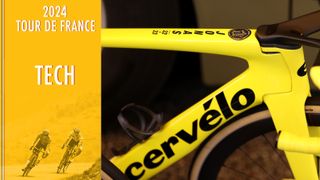
Riders in the Tour de France race on the very best bikes available. One of the perks of being a professional cyclist is getting to ride the best road bikes in the world and have them maintained to perfection by professional mechanics.
Top-end road bikes cost a lot these days, but just how expensive are they? While we tackle the broader question here, you can read our Tour de France bikes guide to see a breakdown of each squad's full equipment package if you want to know more about one team's equipment. If you want to know more about the teams in general, check our our Tour de France team guide for this year.
Naturally, the cost of different team bikes varies. Some teams ride off the peg bikes and componentry that, stock-depending, you could add to an online shopping basket and order tomorrow. This may be a dangerous proposition if you are fired up after watching an afternoon's racing and feel like treating yourself. Then there's the prototype and pro-only componentry that is issued to some teams, here things get a little trickier to work out.
Within the 2024 Tour de France, there are 19 different bike brands, each will have a slightly different pricing structure for its range of bikes. There are also three teams that ride the same brand of bikes. Those brands are Canyon, Specialized and Wilier Triestina who all supply frames to two different teams each.
If you're after a ballpark figure for the bikes being raced in the Tour. The cost of a team race bike is in the region of £9,000 - £14,000 / €10k - €15k / $11k - $16k / AU$17k - $22k.
But let's take a deeper dive into the cost of some specific Tour de France bikes, including the super expensive time trial bike class. We'll also look at who exactly pays for the bikes, whether riders get to keep their own bike, and how many bikes a team will take to the race.
Tour de France bike cost breakdown
Firstly, it's important to recognise that a bike is made up of various components. Starting with the frame and fork, there is then a groupset (or gear and brake system), wheels, tyres, cockpit components such as the handlebar and stem, and the finishing kit such as the saddle, bar tape and pedals. There are then the small parts such as the bolts, bearings, inner tubes or tubeless sealant, lubricants, and even the paint. To quantify the cost of the bike as a whole, you need to calculate the sum of its parts.
Get The Leadout Newsletter
The latest race content, interviews, features, reviews and expert buying guides, direct to your inbox!
It's also worth remembering that depending on the terrain of the stage ahead, riders will often ride different frames or use different components to improve the bike's suitability to the course. Lighter wheels might be swapped in for mountainous stages; more aerodynamic wheels will be used for flatter days, and more puncture-proof tyres might get used if there are cobbled roads or poor road surfaces during a particular stage.
To calculate the true retail cost of a Tour de France bike, we've picked a few bikes being used this year and broken down the cost of each. We've looked at some of the most well-known and popular bikes in the race, as well as a newcomer to the WorldTour peloton this year, that to a degree, bucks the hyper-expensive trend.

Soudal-QuickStep's Specialized S-Works Tarmac SL8
Belgian squad Soudal-QuickStep or the 'Wolfpack' as they like to be known due to their fighting team spirit race on the Specialized Tarmac S-Works SL8. A bike which launched at last year's World Championships. It's fairly easy to work out the team bike cost as a lot of the components come from Specialized themselves or its subsidiary brand Roval and are easily available to purchase. Interestingly, and very unusually the newest SL8 model at launch was actually cheaper than the outgoing SL7 model the team had used. The 'S-Works' name refers to Specialized's top spec frames and if you want to ride the same as the pros, you'll need to spend some extra cash for an 'S-Works' model over the regular Tarmac SL8.
Aside from the paint job which is specific to the team, the S-Works Tarmac SL8 can be ordered off the peg from the brand's website for £12,000 / $14,000 / €14,000.00 / AU$19,900 with the same Shimano Dura-Ace groupset, Roval Rapide carbon fibre integrated handlebar, seatpost and tyres the team normally use and with Roval Rapide CLX II carbon wheels which are used by the team depending on the stage and terrain.
There's one component of the team's equipment package that isn't quite as easy to get your hands on. The team are currently racing on the Roval Rapide CLX II Team wheels which cost £3,000 / $3,800 / €3,700 / AU$6,000. These wheels are available to buy but are limited to 1500 sets worldwide. What we don't currently know is how many have been issued to pro teams. The team edition wheels which omit paint from the hub shells to save weight are £500 / $1,000 / €1,000 / AU$1,600 more than the standard CLX Team II wheels.
Approx total cost: £12,500 / €13,000 / $14,500 / AU$21,500
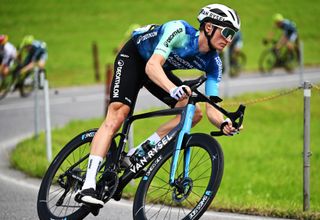
Decathlon–AG2R La Mondiale's Van Rysel RCR
French team Decathlon AG2R La-Mondiale began 2024 with a totally new equipment package, switching from BMC and Campagnolo equipment to Van Rysel bikes, a part of the Decathlon retail family.
The team has enjoyed a blistering start to the year, taking multiple victories and the Van Rysel RCR road bike they race on has been popular from the off.
The Van Rysel RCR is unique in the WorldTour and Tour de France peloton as being available to buy in exactly the same spec as the team race on for under £10,000. We think this makes it one of, if not the cheapest bike in the race. There you have it, a Tour de France race bike and change from £10,000 – a bargain if ever there was one.
The team races on the Van Rysel RCR carbon fibre frame, the bikes are built up with Shimano Dura-Ace electronic groupsets, SwissSide Hadron carbon wheels in a range of rim depth options and Continental GP5000 tubeless tyres. The bike's handlebars and stem are Italian Deda integrated units. We also have it on good authority the team might be using some new aerodynamic tyres from team sponsor Continental during the race.
We think that the team have one of the fastest, and best value equipment packages in the WorldTour. Apparently, Van Rysel engineers tested a range of competitor bikes and the RCR stacks up very well aerodynamically against the competition. Jean-Paul Ballard the SwissSide CEO brings his experience from Formula One to the cycling world and the team is surely benefiting from this. If you absolutely had to buy a fast Tour de France race bike, this one would probably offer the best value compared to the competition.
Approx total cost : £12,500 / €9,000 / $10,999 / AU$ NA

Tadej Pogačar's Colnago V4RS
Tade Pogacar is the overall race favourite this year after already taking overall victory at the Giro d'Italia just a few weeks ago.
His UAE Emirates team races on Italian Colnago V4RS bikes, but it isn't possible to purchase Tadj Pogacar's exact bike spec off the shelf, which makes things trickier. You could buy the individual parts that make up the team's bike, and get really close to the same build the team use, but may come unstuck trying to get your hands on his handlebars.
On the Colnago bikes website bike builder, the closest you can get to the Slovenian aces builds comes out at £14,143 / $17,919 / €16,763 / AUD $26,849.
This is with the same frame, Dura-Ace electronic groupset and integrated power meter. But instead with a Colnago CC.01 cockpit, not the Enve integrated handler and stem the team uses. The bike also gets specced with Enve SES 3.4C wheels, not the deeper profiled Enve SES 4.5 wheelset Pogacar tends to use.
Utah-based composites brand Enve provide the wheels and integrated handlebar on Pogacar's bike. The handlebars in particular will be tricky to get hold of right now and seem to be a custom version of the handmade SES AR handlebar which retails for a whopping $1,200, that's the cost of some bikes. The curve of Pogacar's handlebar drops is different to the stock bar offered on the company's website leading us to think this is a custom team-only option, at least for now.
It also isn't possible to buy the bike with the exotic Carbon-Ti chainrings and disc brake rotors the team uses to save weight. The 55-tooth Carbon Ti CarboRing chainring costs €249.00, whilst the smaller 40-tooth Inner chainrings cost €186. The X Rotor discs cost €185 each and weigh 80 grams in a 160mm size. We have subtracted the rough cost of the Dura-Ace equivalent parts to work out the total cost of Pogacar's build and used component RRP's
There's also the additional cost of bar tape, computer mount, bottle cages, and the probable addition of ceramic bearings to add on. We'll estimate an approximate cost of around £200 for all that.
We'll waive the added cost of the bottles since that's peripheral to the bike itself. Likewise his Wahoo computer.
Approx total cost: £13,479
Currency conversion as of June 2024: €16,087. / $17,186 / AUD $25,794

The most expensive Tour de France bike? Ineos Grenadiers' Pinarello Bolide F
There's no greater arms race in cycling than in the world of time trialling, and as such, it's here that the money really starts to stack up. Nowadays, we have such a deep understanding of aerodynamics, rolling resistance and drivetrain efficiency, and how they all affect the speed at which a rider will travel for a set power. Therefore, the time and research going into developing time trial bikes, components and clothing is growing exponentially as the available gains get smaller and smaller. The result is the cost of the products that are created are pretty damn expensive.
The bike in question is the Pinarello Bolide F; launched shortly after the Tour de France in 2022. From the PinarelloStore website, it is priced at £12,000 for a frame alone or a staggering £30,000 with custom-printed time trial extensions. You can bet that most Ineos riders will take the more expensive option.
On top of this, based on recent races, riders are likely to use a pair of wheels from Princeton Carbonworks: the Blur 633 V3 rear disc wheel ($2,950) and Mach 7580 TSV2 front tri-spoke ($2,850). Total cost $5,800 (Approximately £4,658 after conversion).
The team has also used a Classied hub equipped Parcours rear disc wheel this year to further increase 1x gear range, accommodate the dinner plate-sized front chainrings riders are using now and help improve drivetrain efficiency. This Classified hub gear-enabled Parcours Disc2 wheel retails for £1,099 / $1,449 / €1,429. But will then need to be paired with the Classified Powershift wireless hub system at £1,096 / €1,299 / $1,388. We expect that the terrain of a time trial will mostly determine when the team uses this option. We will price up with the more expensive Princeton wheelset option for the final total.
They'll also need a groupset, and it makes sense that they'll use the same Dura-Ace R9200 as found on their road bikes. When factoring in a power meter, that'll cost in the region of £4,200, albeit with small differences based on the time-trial-specific brake levers and shifters. They'll also almost certainly swap the 2x chainset and front derailleur in favour of a 1x aero-optimised chainring. We calculate this to be around £200 cheaper than a 2x setup, so will deduct this from the total.
Beyond these main components, there are other 'finishing' components to add on. Continental GP5000 S TR tyres will cost £198 for a pair. There's also a saddle, for which we'll use the Fizik Transiro Mistica KIUM saddle - all £165 of it - as used by the team's best time triallist Filippo Ganna , plus roughly £50 for bar tape, chain lube, tubeless conversion. We also acknowledge there may be new or secret prototype parts that we don't even know about yet, but this is a good estimation.
Approx total cost: £39,071
Approx currency conversion (June 2024): €58,127 / $62,110 / AU$93,266
A new rival to the Pinarello price tag

Wilier Triestina released a new time trial bike recently that rivals the Pinarello offering in price. The bike in question is the new Supersonica SLR TT .
The new bike has been developed alongside time trial ace and Groupama FDJ rider Stefan Kung after more than 50 hours of CFD computer simulations. Wilier offer a custom handlebar extension option to non-pro riders too, so if you splash the cash you can enjoy close to the pro treatment.
Price-wise, the Supersonica frame kit is €9,000, but like the Pinarello Bolide F, add on custom tri-bar handlebar extensions and a Dura-Ace build complete with Miche disc wheel and tri-spoke and the price gets bumped up to €27,400. You could easily head north of €30,00 here with upgrades like ceramic bearings and other aero components optimisations.
Approx total cost: £27,400
Approx currency conversion (June 2024) : €32,455 / $34,673 / AU$52,095
How many bikes do teams have at the Tour de France?
Most Tour de France riders will usually have two bikes available to them on any given day, with key riders having even more. Some teams will also have two different types of bike - one that is lighter in weight for the climbing days, and another that is more aerodynamic for the flatter, faster days. They will also have one or two-time trial bikes per rider for the time trial stages.
If you extrapolate that out to eight riders per team and take into account bikes that have been crashed out, it's not uncommon for teams to have 60 framesets and over 100 wheelsets at race (and hundreds more back at the team's service course). Hunt Bike Wheels previously confirmed to Cyclingnews that it supplied 115 wheelsets to Qhubeka Assos for the 2021 Giro d'Italia to give you an idea.
Can you buy a Tour de France bike?
The sport's governing body, the Union Cycliste Internationale (UCI), has a rule that means any product used in competition must be made available for public sale. Article 1.3.006 of the UCI Technical Regulations states:
"Equipment shall be of a type that is sold for use by anyone practicing cycling as a sport. Any equipment in development phase and not yet available for sale (prototype) must be subject of an authorization request to the UCI Equipment Unit before its use. Authorization will be granted only for equipment which is in the final stage of development and for which commercialization will take place no later than 12 months after the first use in competition."
To simplify, this means teams can only use technology that is available to the public or prototypes of tech that is planned to make it into the public domain within 12 months. Therefore, you can indeed ride the exact same bikes as the WorldTour pros… just know you'll need deep pockets.
If you want to go a step further and ride a bike that has literally been ridden in the Tour de France, then this is possible too. Websites like Bike Room sell off teams' old bikes at the end of the season once they've been finished with.
What do Tour de France teams pay for their bikes?
This depends on the sponsorship deal the team managed to strike with manufacturers of the frames and components, but for the most part, teams will not pay a single penny for their bikes.
Understandably, we're not privy to the ins and outs of these commercial negotiations, but the rough details are no big secret. The bike industry is rife with brands vying for attention, and there's no bigger stage than the Tour de France. Be they bike brands, kit manufacturers or shoe suppliers, they all want to put their products in front of a worldwide audience, and they all have something to offer that the team needs.
The types of sponsorship agreements vary greatly by team, usually dependent on the team's success - or likelihood thereof. A winning team is better publicity, after all.
Some deals will be for the frameset alone, meaning the team needs to head elsewhere for a supply of wheels, groupsets and everything else. Others will get complete bikes supplied by the brand.
In addition, some sponsorship agreements are a simple handover of product in return for the publicity it will garner, while others are fully integrated technical partnerships where the two parties work together to innovate, develop and market their products, like the AG2R Decathlon La Mondiale setup this year.
Moreover, rather than paying for the bikes, some deals will actually also involve a cash injection alongside the provision of equipment, meaning these teams are given bikes and money. Hands up anyone who's ever left a bike shop richer than when they entered...? No, nor us.
Do pro cyclists get to keep their bikes?
Usually not, no. In almost all cases, the bikes are provided to the team by a brand by way of sponsorship. The brand will supply enough bikes to supply the team for the season, and then at the end of the season - or contract period, which often spans a few years - the bikes will be returned.
Exceptions are sometimes made for key riders upon retirement, or bikes that are ridden to special victories, but in most cases, the bikes are returned to the brand and then sold, gifted, or in some cases even discarded.

Thank you for reading 5 articles in the past 30 days*
Join now for unlimited access
Enjoy your first month for just £1 / $1 / €1
*Read any 5 articles for free in each 30-day period, this automatically resets
After your trial you will be billed £4.99 $7.99 €5.99 per month, cancel anytime. Or sign up for one year for just £49 $79 €59
Try your first month for just £1 / $1 / €1
Josh is Associate Editor of Cyclingnews – leading our content on the best bikes, kit and the latest breaking tech stories from the pro peloton. He has been with us since the summer of 2019 and throughout that time he's covered everything from buyer's guides and deals to the latest tech news and reviews.
On the bike, Josh has been riding and racing for over 15 years. He started out racing cross country in his teens back when 26-inch wheels and triple chainsets were still mainstream, but he found favour in road racing in his early 20s, racing at a local and national level for Somerset-based Team Tor 2000. These days he rides indoors for convenience and fitness, and outdoors for fun on road, gravel, 'cross and cross-country bikes, the latter usually with his two dogs in tow.
Strength training for cyclists: How resistance training can enhance cycling performance and prevent injuries
Redshift Switch Aero System and ShockStop stem review: Odd on their own, but transformative together
Vuelta a España humble pie - Ben O'Connor makes his rivals and critics eat a slice of humility before week three showdown
Most Popular
What type of Tour de France rider are you most like?
‘No man is an island' is an epithet that even applies to the Tour de France yellow jersey winner. He relies on a group of riders, each with different strengths and responsibilities. We consider the various specialities needed in each team Illustration - www.chriswatson.cc
- Sign up to our newsletter Newsletter
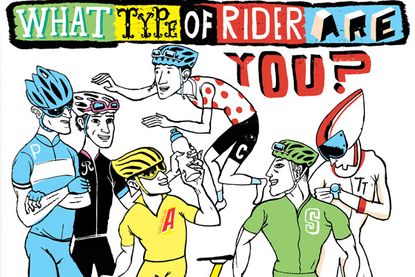
The Tour de France can be looked at as a bit of a circus, riders of all different shapes and sizes converging to create one of the strongest and best bunches of the pro calendar.
All these riders go into the Tour with different aims; not many are looking to win. For many, just getting to Paris in one piece is victory enough.
From climbers to puncheurs, domestiques to road captains, we dissect the Tour peloton to explain why not every rider is expecting to don the yellow jersey and what the different types of riders may aim to get out of their time riding the most prestigious race of them all.
Creating a Tour team
Many of the top pro teams have their goals for the Tour mapped out at the beginning of the season. For example, Team Sky will be intent on getting the yellow jersey on the shoulders of one of their riders for another year.
Meanwhile, Peter Sagan and his sprint rivals will be eyeing the green jersey competition. At the other end of the spectrum, the Pro Continental teams in the race will most likely focus on individual stages, as opposed to the overall competitions, with the aim of getting into as many breaks as possible to give their sponsors a good showing.
Each team in the race will have their targets set out and will be creating a team to help achieve these goals, usually focused around their selected team leader, the rider they feel most capable of winning the competition they are targeting.
These riders are selected to help the team leader achieve the team's goals and will each have a specific role within the team; if the team's goal is for a rider to win the green jersey, there's no point in putting a team of pure-bred climbers together to support him.
Get The Leadout Newsletter
The latest race content, interviews, features, reviews and expert buying guides, direct to your inbox!
Out on the road, there will be domestiques (which translates as 'servants') who will give up wheels when team-mates puncture, collect food and bottles from the team car and give them to the team leader and other team members.
The road captain is usually the most experienced rider of the team; he calls the shots out on the road and tells other team members what needs to be done - for example, when to chase or begin to reel in the day's break ready for the sprinter of the team.
These guys communicate with the directeur sportif (DS) back in the team car and receive time gaps and other information to relay on to the rest of the team.
Finally, there is the top rider's right-hand man, also known as the super-domestique. For GC contenders, their top domestique has to be able to be up there in the mountain stages, helping to cover all rivals' moves.
For a sprinter, this role is fulfilled by their lead-out man, who stays with them and ensures they're always sheltered, gets them over the mountains and makes sure that they're up there for the final sprint.
A great example is Bernie Eisel, who is always up there with Mark Cavendish in the major tours when they've been team-mates. So, while we often only see the winners of stages or overall victories, there are many other riders working hard for the top men to ensure that the victory is theirs.
Types of riders
Different types of rider are selected depending on the team's goal, but what are all the different types of riders out there for team managers to choose from?
Different types of riders specialise in different races, different stages, and vary widely in shape, size and abilities, as well as in personalities. So let's look at the different types of rider involved in racing the Tour and also assess what their role may be within the teams, depending on their strengths, weaknesses and motivations. Which one are you most similar to?
All-rounder
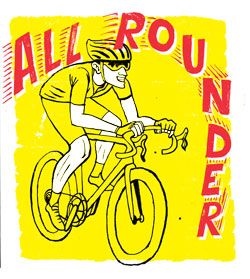
These are the true Tour contenders, the Chris Froome s and Eddy Merckx es of the bunch - not only do they have the ability to climb with the best of them, they can also time trial.
Whereas pure-bred testers of the bunch battle their way up the mountains and climbers struggle against the clock, these all-rounders are able to be competitive in both these crucial aspects of stage races.
Tours are won or lost on mountain stages, but if riders are down by only a few seconds and their ability against the clock is superior to their pure-bred climber rivals, it's very likely they'll claw back that difference, especially in the longer time trials.
The team leader is usually an all-rounder; the rest of the team works to help them achieve a top GC position. Usually bigger in height and weight, these guys cling on to the climbers up the mountains, so as to lose as little time as possible.
Their larger stature aids them in the time trials, though; their larger levers and chest allows them to sit at their threshold for extended periods while churning out high wattages.
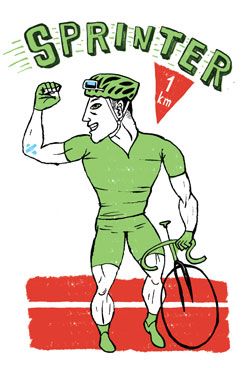
Hidden away for the majority of the race, sprinters don't show their faces much until the end of the race. Their teams work hard to shelter them so they can conserve their energy for that final sprint effort.
Sprinters are fast by nature, with a higher proportion of fast-twitch muscle fibres than the rest of those in the bunch, which helps them reach the very high top speeds seen in big bunch finishes.
You'll see these guys winning during the flat sprint finish days in the Tour, but they'll be suffering and sometimes struggling to finish within the time limits on the mountain stages.
Famous sprinters include Mark Cavendish, Robbie McEwen and Sean Kelly; they're often feisty, extroverted personalities who speak their mind on and off the bike.
Time Triallist

The powerhouses of the bunch who can sit at their threshold and bang out consistent wattages to put big time gaps into their opponents during the time trial stages.
However, despite being able to make up time against the clock, true ‘testers' really struggle when the road begins to point uphill - they are physically larger and heavier than other riders.
During regular flat stages, these riders work for their team leaders and are occasionally permitted a foray up the road in the day's break. But when it comes to the time trial stages, they are expected to perform.
Brit Alex Dowsett is a time trial specialist, as he has shown in stage races and the 2014 Commonwealth Games time trial title. To have the ability to maintain these high power outputs at threshold, a large lung capacity is vital, as is being able to put up with extended periods in an aero tuck. These riders are motivated by bettering their own times, power outputs and stats to go that extra bit faster.
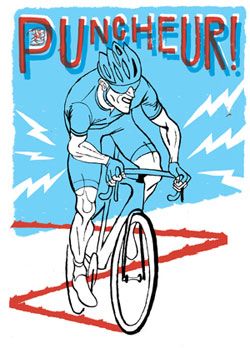
Puncheurs are riders best suited to rolling courses with short, steep climbs. The Spring Classics are ideal for them.
When it comes to the Tour, these guys will be eyeing victories on the more rolling stages. Otherwise, they are used by the team to work for their leaders to reel in breaks or attacking to make other teams and riders chase.
While they may be suited to short, punchy climbs, they struggle in the Tour's long Alpine and Pyrenean ascents.
These riders are usually quite well built, as far as cyclist go, with broader shoulders and bigger legs; their outright endurance and recovery is not as good as that of the climbers or GC contenders.
Examples of such riders include Peter Sagan who, although he can sprint, can also get over climbs other riders cannot, and former world champion Philippe Gilbert.
Their attacking style of riding often comes into play nearer the end of long stages as the day's break is being reeled in.
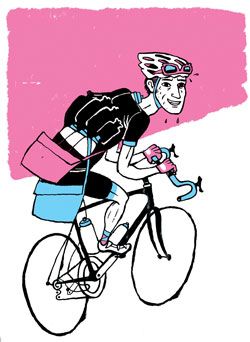
These are the pure domestiques of the bunch; they do not excel in any particular style of riding but do reasonably well at everything.
Their attributes and ability to turn their hand to any type of terrain makes them great at looking after the team leaders, whom they cater for loyally for the duration of the Tour.
Domestiques are often as strong physically as those contesting the Grand Tour stage and overall wins. Think how much extra riding they are doing going to and fro from the cars in the convoy or sitting on the front chasing breaks.
However, psychologically they are often much more introverted, and shy away from the media attention.
These riders just like to get on with riding their bikes. There are some very long-serving domestiques who have looked after their team leaders well during many Tours, staying with them and setting the pace on mountain stages before the attacks set in.
Jens Voigt , for example, was often on the attack or chasing down attacks; he was one of the most respected and loyal domestiques in the bunch.

The whippets in the bunch, weighing in at around 60kg or even less, these are the riders who dance their way up the big hills.
Climbing specialists thrive on the longer, mountainous ascents where the speed drops and drafting becomes of limited help but pacing is vital.
Due to their low weight, climbers are able to put in repeated accelerations to try and drop heavier rivals. Their high endurance levels enable them to recover quickly.
Their sprinting ability is limited to uphill sprints, as their small stature means they do not possess the strength on flat fast finishes.
Examples of pure climbers are Nairo Quintana , Romain Bardet and Alberto Contador .
Often these climbers keep themselves hidden and out of trouble during flatter stages and quietly bide their time as they wait for the terrain to begin to go up; they know this is where the Tour will be won or lost.
The pure-bred climber's GC tactic is to better their all-rounder rivals by an insurmountable amount of time on the climbs - allowing no comeback in the TTs.
Alternatively, you might see pure climbers aiming solely for the prestigious polka-dot King of the Mountains jersey, amassing points by heading out on day-long solo breakaways and crossing each col first.
Personality profile
With all these different types of riders and riding styles come different personalities. Often, riders' personalities echo how they like to ride: attacking, conservative, alone or for others. As well as personalities, different types of cyclist are motivated differently.

Although many top riders are motivated by an internal desire to win races, others, such as sprinters, are motivated by an external stimulus; namely, the riders around them, whom they want to beat.
Although it's not set in stone that all sprinters are extroverted and aggressive in their racing outlook, many of them are - their confidence and desire to win shines through.
The diagram below shows how our six different types of riders are affected by motivation and their personality type.
Choose your role
With a variety of personalities and riding styles in the pro peloton, all vying to be crowned winner of the various winners' jerseys, which would you most likely be able to win?
Knowing which type of rider you are is vitally important in riding. There's no point going for the climber's polka-dot jersey when you're an out-and-out sprinter.
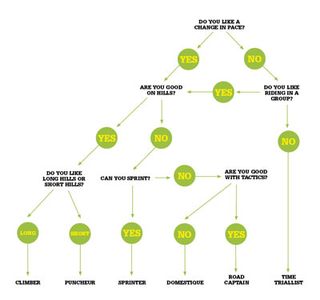
So now's the time to find out which type of rider you are and which jersey you should be competing for in the Tour. Are you the puncheur going for stage win or helping your team-mates?
If you seem to be saying yes to everything, maybe you're the super-domestique that your team leader needs!
Thank you for reading 20 articles this month* Join now for unlimited access
Enjoy your first month for just £1 / $1 / €1
*Read 5 free articles per month without a subscription
Join now for unlimited access
Try first month for just £1 / $1 / €1
Follow on Twitter: @richwindy
Richard is digital editor of Cycling Weekly. Joining the team in 2013, Richard became editor of the website in 2014 and coordinates site content and strategy, leading the news team in coverage of the world's biggest races and working with the tech editor to deliver comprehensive buying guides, reviews, and the latest product news.
An occasional racer, Richard spends most of his time preparing for long-distance touring rides these days, or getting out to the Surrey Hills on the weekend on his Specialized Tarmac SL6 (with an obligatory pub stop of course).
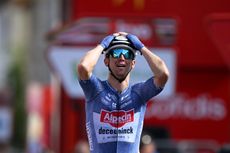
Visma-Lease a Bike controlled the action all day for Van Aert but the Belgian couldn't hold off Groves in Villablino
By Flo Clifford Published 31 August 24
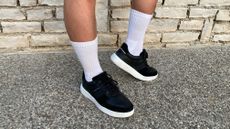
David Millar spent three years developing what he believed would become the finest urban cycling shoe bar none. James Shrubsall takes them for a spin.
By James Shrubsall Published 31 August 24
Useful links
- Tour de France
- Giro d'Italia
- Vuelta a España
buyers-guides
- Best road bikes
- Best gravel bikes
- Best smart turbo trainers
- Best cycling computers
- Editor's Choice
- Bike Reviews
- Component Reviews
- Clothing Reviews
- Contact Future's experts
- Terms and conditions
- Privacy policy
- Cookies policy
- Advertise with us
Cycling Weekly is part of Future plc, an international media group and leading digital publisher. Visit our corporate site . © Future Publishing Limited Quay House, The Ambury, Bath BA1 1UA. All rights reserved. England and Wales company registration number 2008885.

IMAGES
VIDEO
COMMENTS
A complete list of the bikes raced by each team in the 2024 Tour de France, along with the groupsets, wheels and finishing kit they're fitted with.
In terms of the teams themselves, the men's WorldTour roster has seen two new teams in 2023: Alpecin-Deceuninck and Arkéa-Samsic. Both Israel-PremierTech and Lotto-Dstny have left the World Tour but they take part in the Tour de France as wildcards alongside TotalEnergies and Uno-X. Without further ado, let's have a look at the bikes...
The 2024 Tour de France begins on Saturday the 29th of June in the beautiful city of Florence, Italy, before working its way into France. It is the biggest bike race in the world and sees the very ...
The Tour de France is the world's highest-profile cycling event. With millions of eyes on the race, the Tour is a rolling showcase for bicycle brands and equipment manufacturers. And since 2024 ...
For the 2024 season, Groupama - FDJ has replaced Lapierre bikes with those made by Wilier. This means the French team will have the choice of the Filante SLR, the 0 SLR and the new TT bike, the ...
The bikes in use at the Tour de France are up there with the very best that money can buy. All of the bikes used in the 2021 Tour de France are made from carbon fibre. That includes their frames ...
The next most successful brand is Peugeot. Now better know for cars, the French brand first won in 1905, with its last victory in 1977. Trek can only claim two official Tour de France wins, with ...
The Tour de France is the most prestigious race in the pro calendar and teams will have prepared their best riders to be at the peak of their fitness for the race's grand départ. They'll be ...
How to watch the Tour de France: Online, streaming, and on television; Tour de France route map; Tour de France stage-by-stage guide; Tour de France beginner's guide; For components, Shimano, Campagnolo, and SRAM are all in the mix, with Shimano having the lion's share of the teams. Read on for a look at every team bike of the 2022 Tour de ...
Colnago, Cube, Pinarello, and Specialized, don't differentiate between lightweight and aero bikes. So the teams riding these brands only have a choice of a road and TT bike. Canyon and Specialized (3 teams) and Canyon (2 teams) have the biggest presence in 2023. Shimano dominates the groupset presence with 18 teams using their latest 12-speed ...
2024 Tour de France Stage-Winning Bike Details: ... Bike Type: Aero Stage Type: Hilly. Romain Bardet (right) & Frank van den Broek. Photos: Team DSM-Firmenich PostNL. Stage 1 of this years was expected to be one of the hardest Tour starts in recent memory. Tough climbs, high temps, and costal winds would make many riders suffer early.
Bottom: A Scott Foil RC that will be used by Team Dsm-Firmenich PostNL at the 2024 Tour de France. 1. Carbon is the only way to go. Twenty years ago, carbon fiber had already begun to usurp aluminum, titanium and steel as the frame material of choice, but it was still early days. Many frames bonded carbon tubes to metal lugs.
Discover the latest tyre trends and technologies at the Tour de France, where wider rims, wider tyres and tubeless options dominate the peloton. BikeRadar gives you an inside look at the pros ...
Helyett - 3 wins. La Sportive - 3 wins. Tour de France winning bikes by year. Throughout 110 editions (up to 2023), the Tour de France has been won by 36 different bike brands. Many of these brands are unknown to cycling fans today. Few bike brands, such as Colnago, Pinarello, Specialized, and Trek, are synonymous with cycling fans today.
In 1972, Gitane produced the "Tour de France", which was a lightweight (for the time) frame, made from Reynolds 531 tubing and served as the brand's race bike, until it went on hiatus from the ...
Bike Type: Aero/All-Rounder Stage Type: Hilly Victory Lafay taking a surprise win. Photo: A.S.O./Charly Lopez. Victor Lafay (Cofidis) ended Cofidis' 15-year-long drought of Tour de France stage wins with a thrilling and powerful attack in the final meters of stage 2 to beat top favorites like Wout van Aert, Tadej Pogacar, and Tom Pidcock.
Our 8 favourite Tour de France bikes | The coolest Tour bikes, according to BikeRadar | BikeRadar.
> Jonas Vingegaard uses 1x gearing for Tour de France opening stages. A few riders have dabbled with 1x, with varying levels of success, and of course, there was the ill-fated Aqua Sport Blue team which solely used 1x drivetrains on 3T Strada bikes. The team boss at the time was quite scathing about either the drivetrain or the bike, or perhaps ...
The cost of bikes for Tour de France 2023 varies from team to team with each team having their own budgets but a rough estimate would be between $13,000 and $16,000 (USD) for each bike. With each team having eight riders and all the spare bikes needed to get across France, the bike sponsors are spending a lot of money, both in fees and free ...
Marco Pantani nears the final hairpin of the road to Alpe d'Huez on his record-setting climb at the 1997 Tour de France. Credit: Ein Ciere, CC BY 3.0, via Wikimedia Commons.Edited from the original. Grimpeurs - French for "climbers" - are the mountain goats of the peloton.. They're typically small and lightweight riders, capable of fast accelerations up steep inclines to shake off ...
The cost of a team race bike is in the region of £9,000 - £14,000 / €10k - €15k / $11k - $16k / AU$17k - $22k. But let's take a deeper dive into the cost of some specific Tour de France ...
Best young rider. The Tour de France sees the very best cyclists in the world battle it out for the yellow, green, white and polka dot jerseys, based on the general, points, mountains and young ...
The Tour de France can be looked at as a bit of a circus, riders of all different shapes and sizes converging to create one of the strongest and best bunches of the pro calendar. All these riders ...